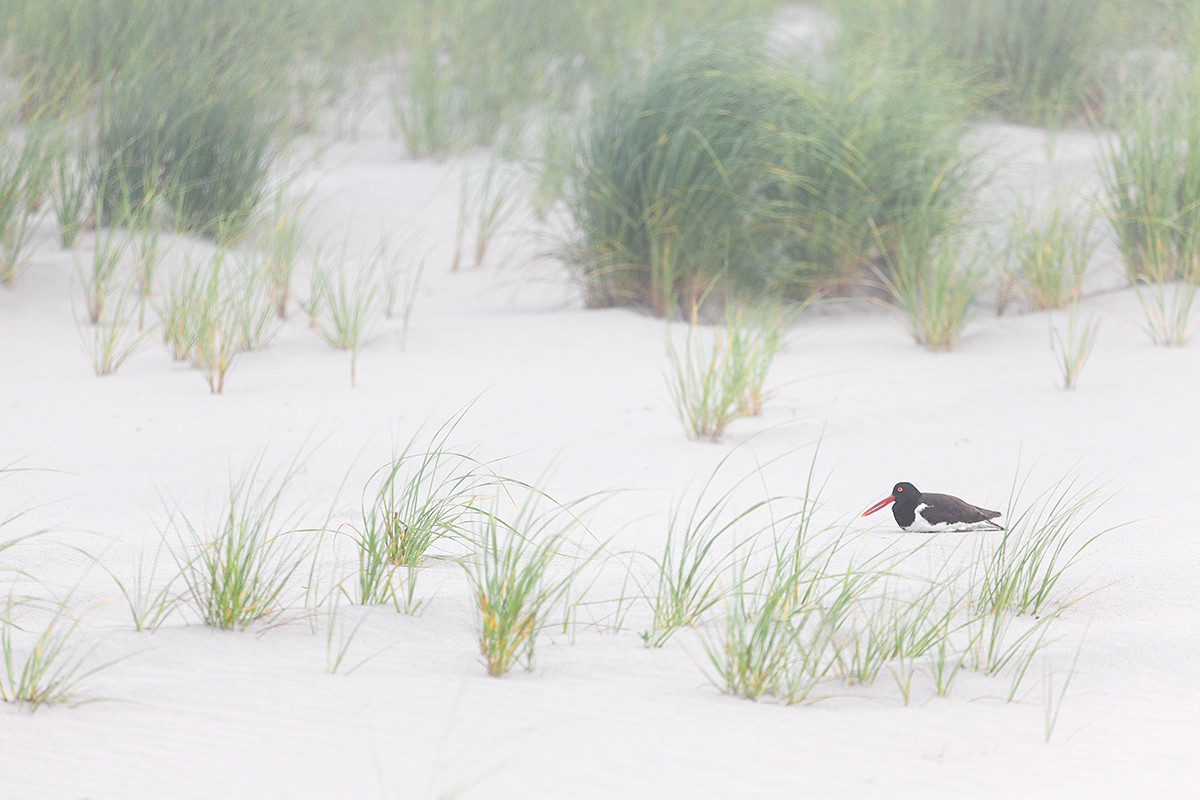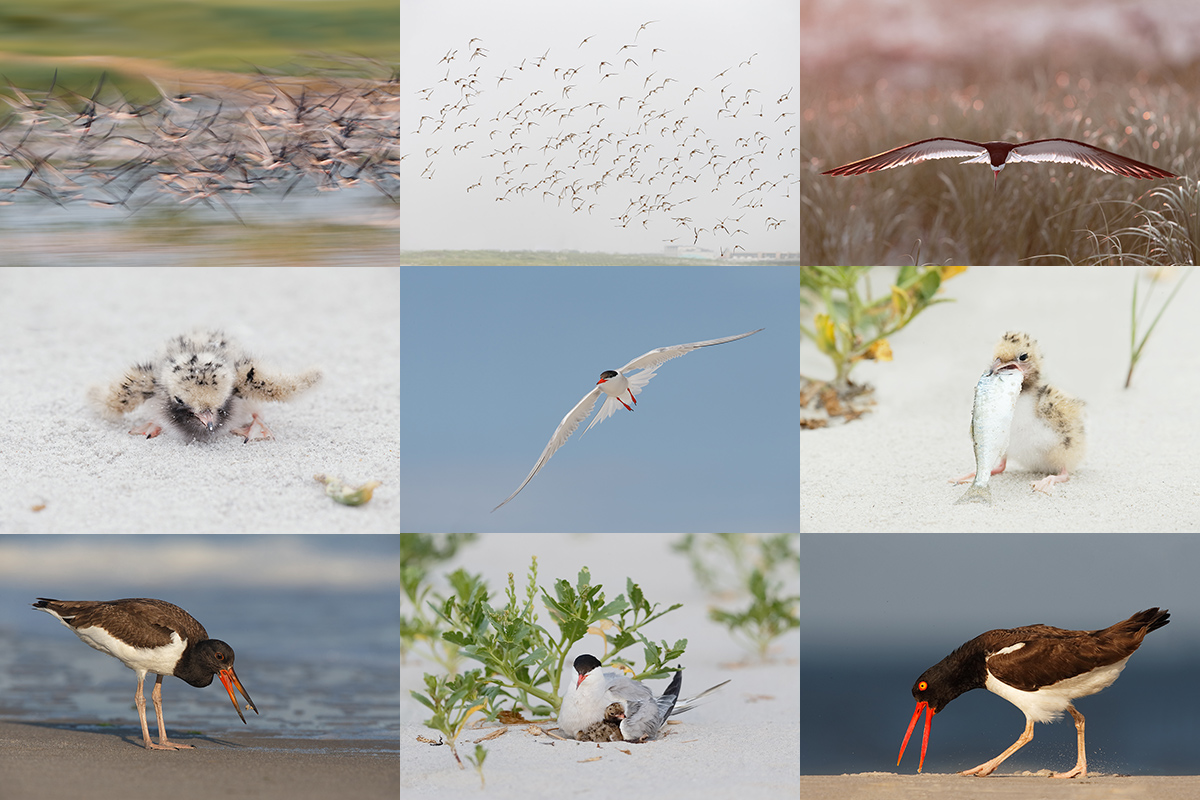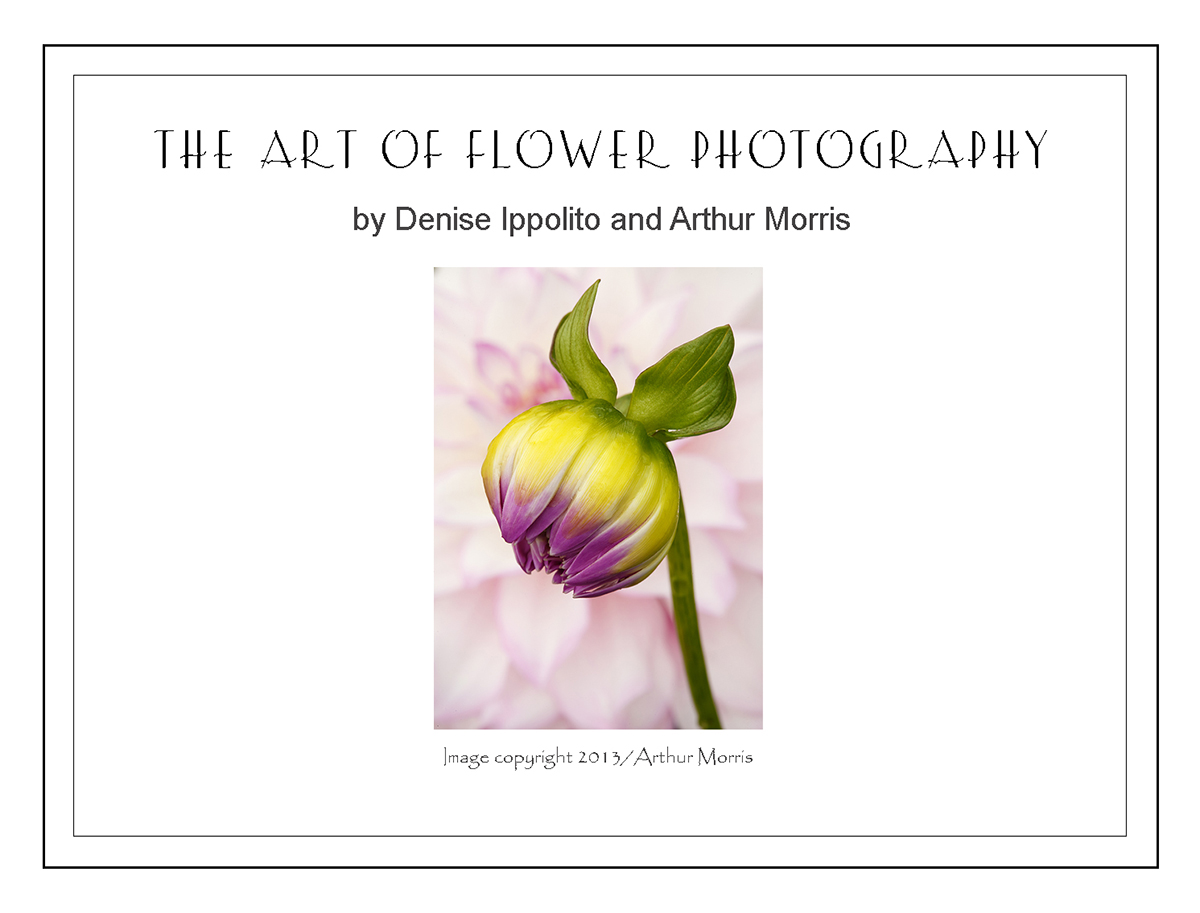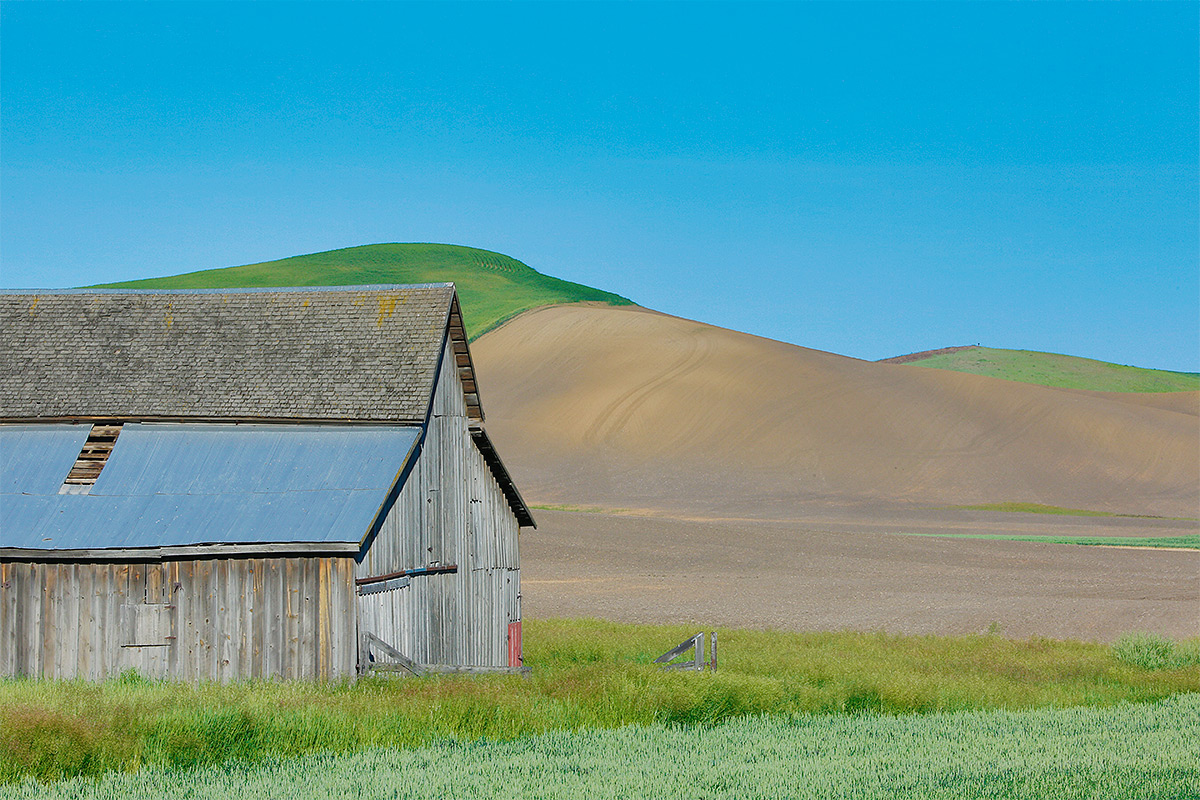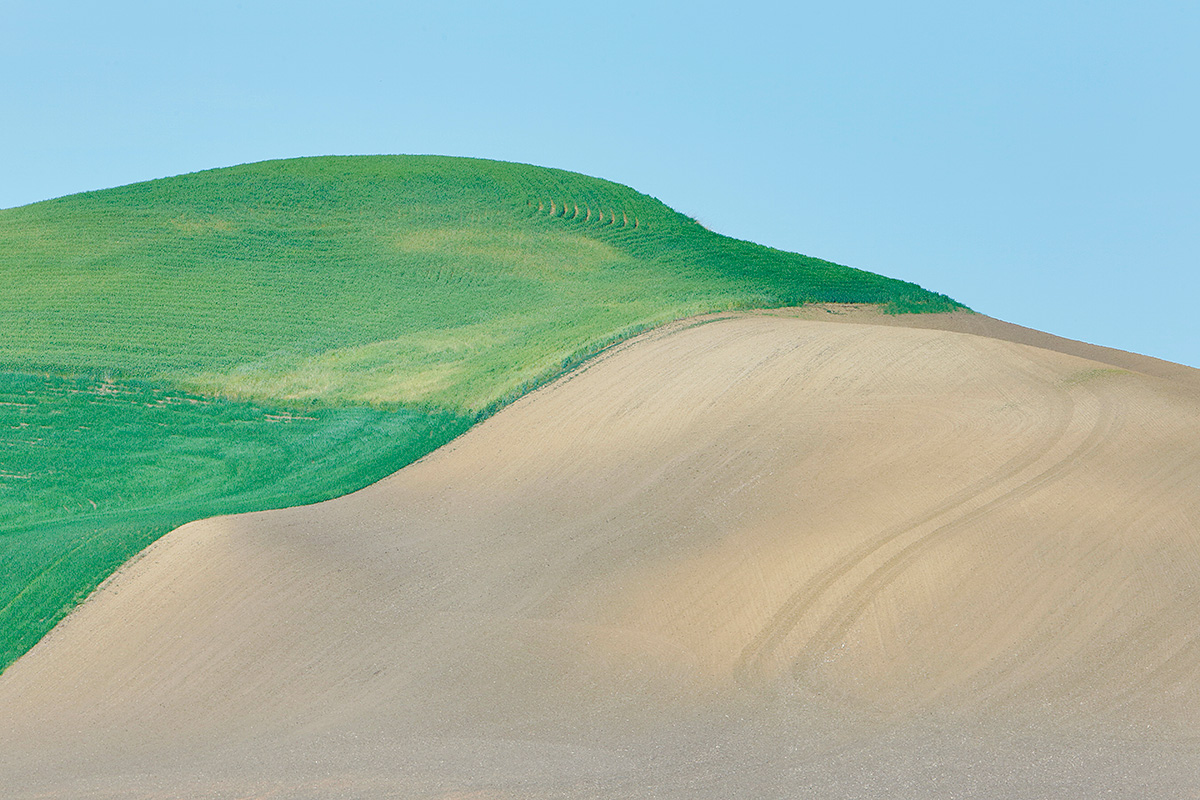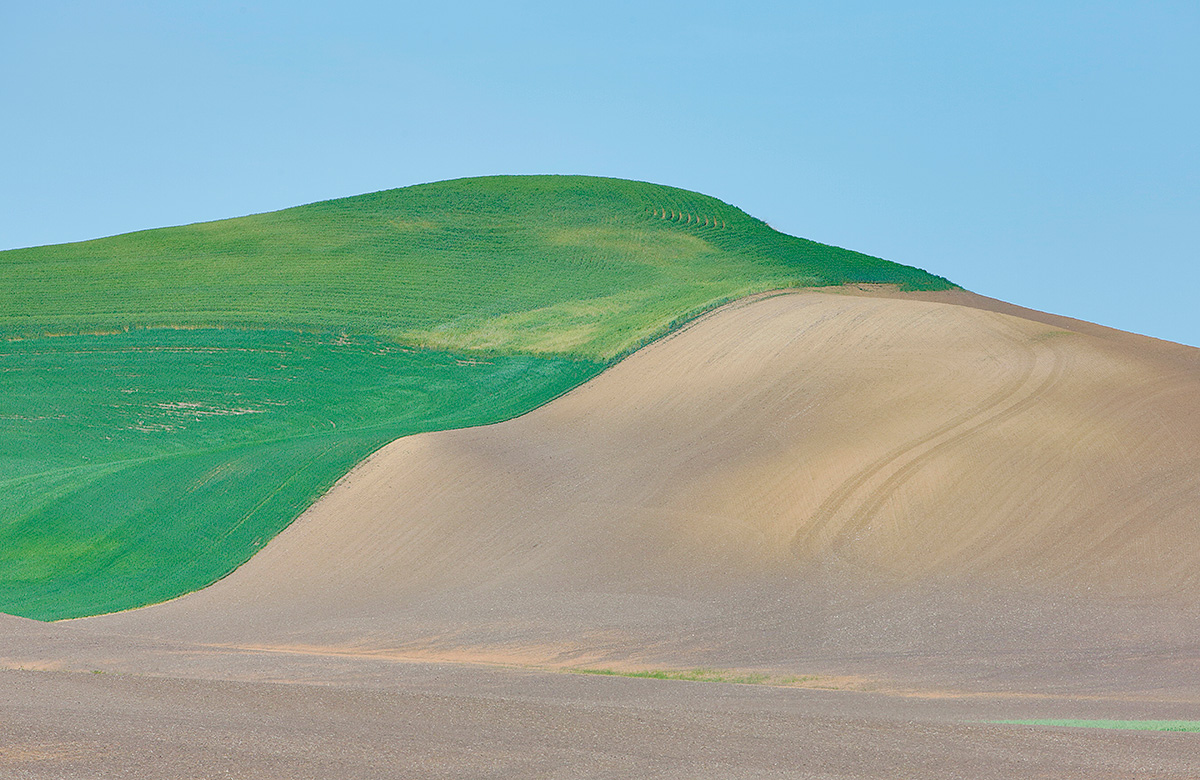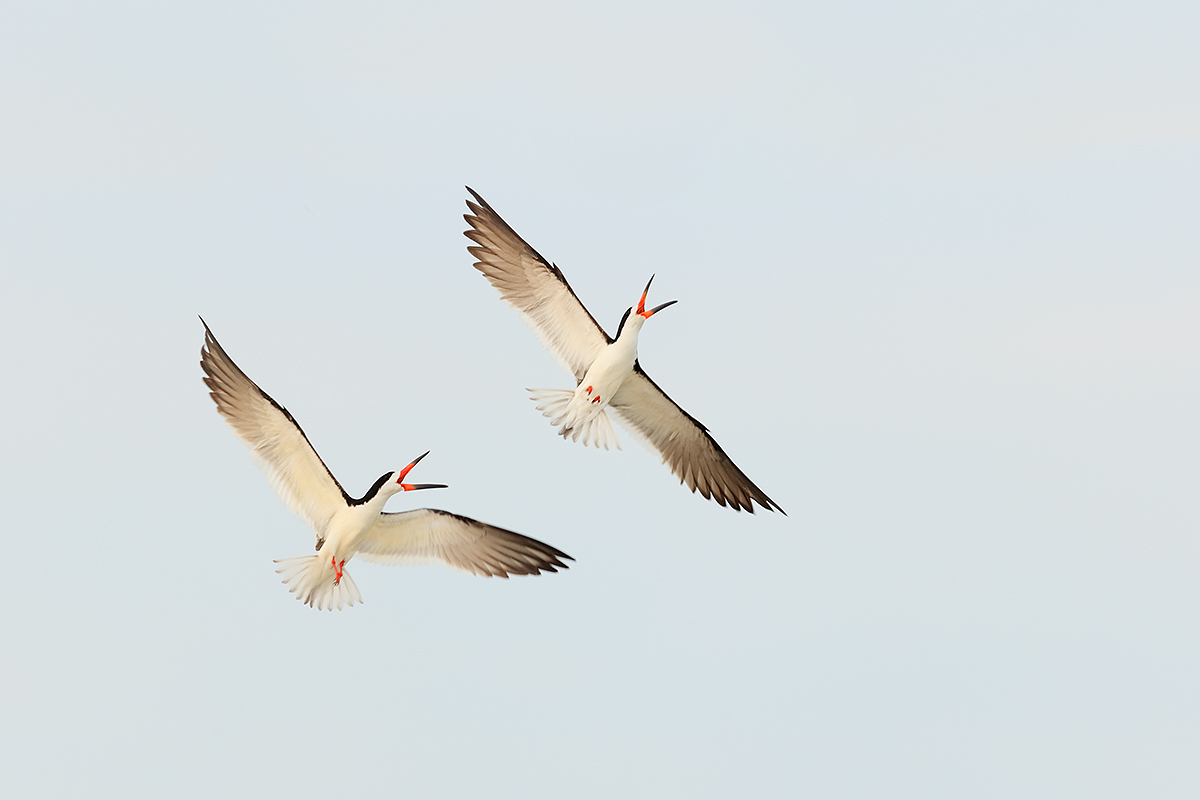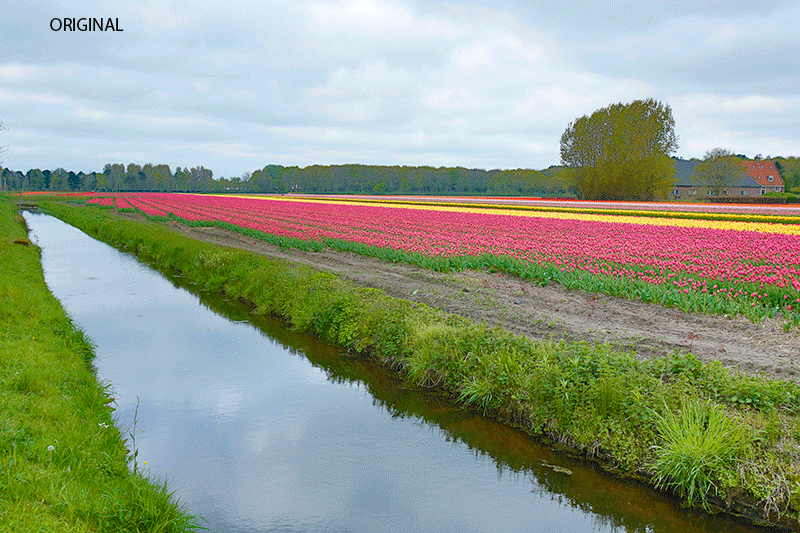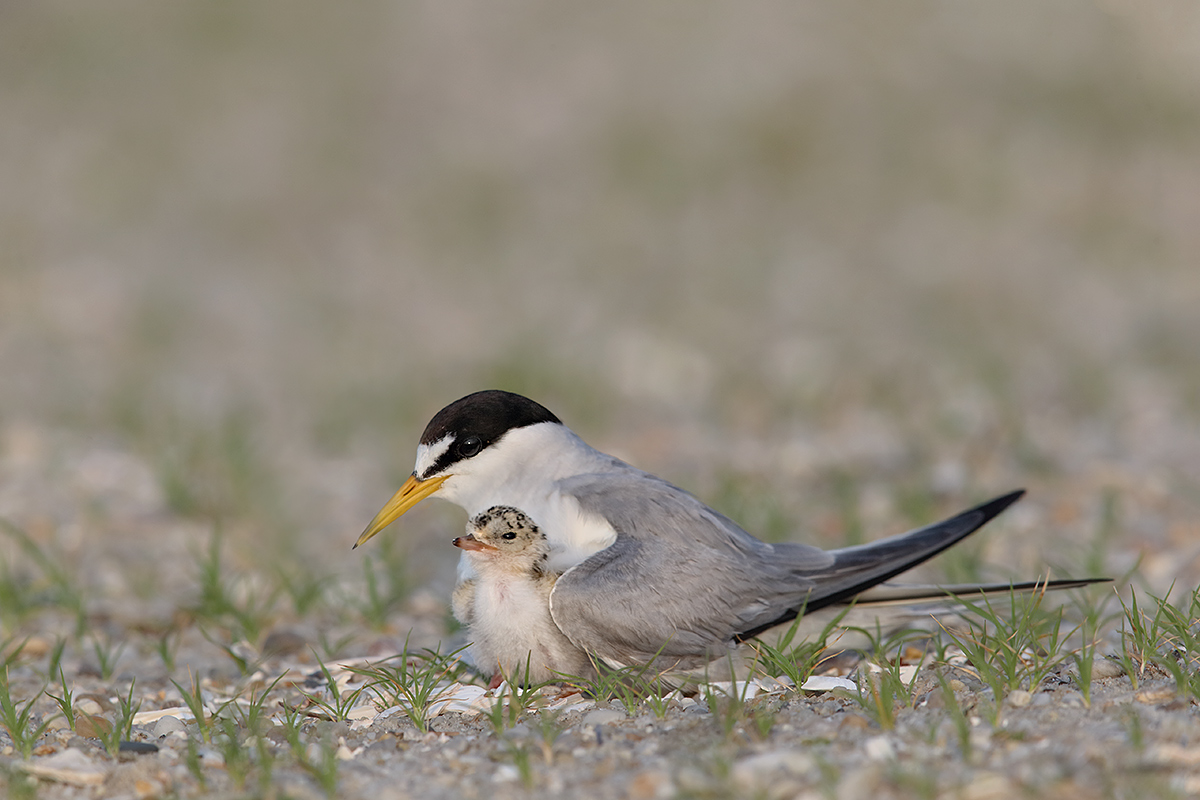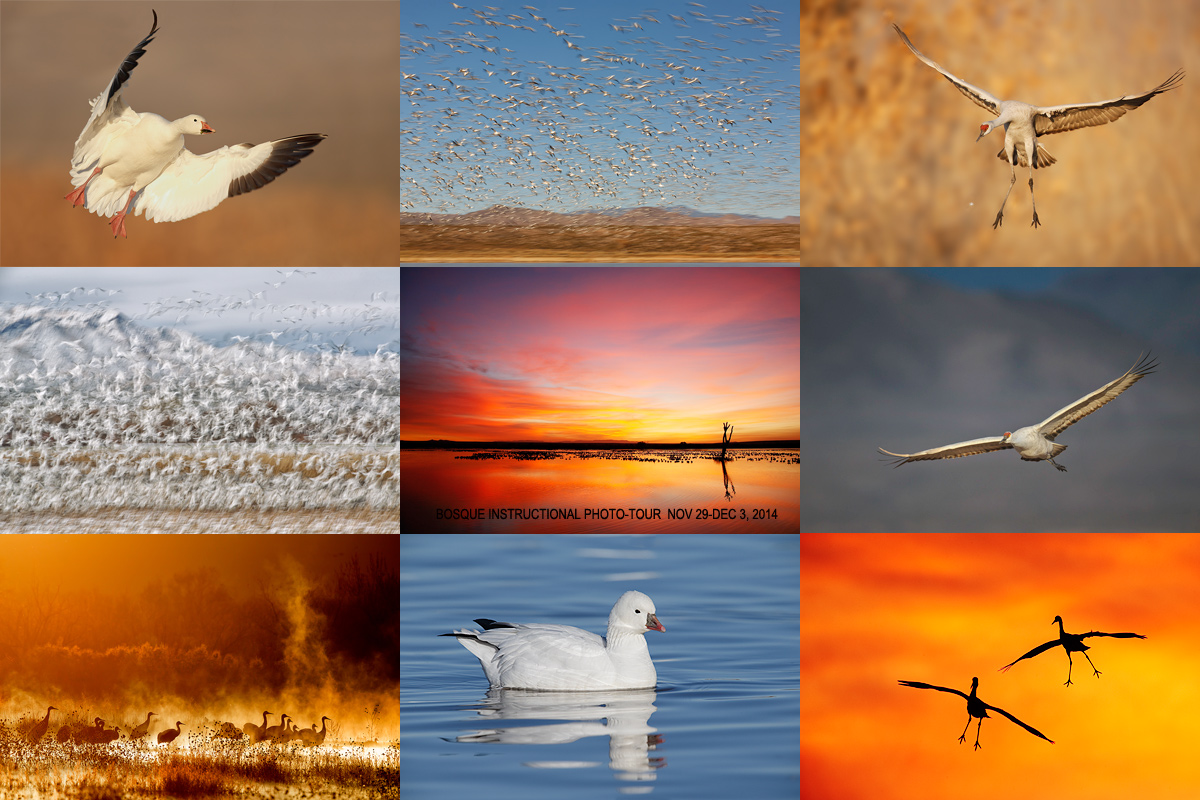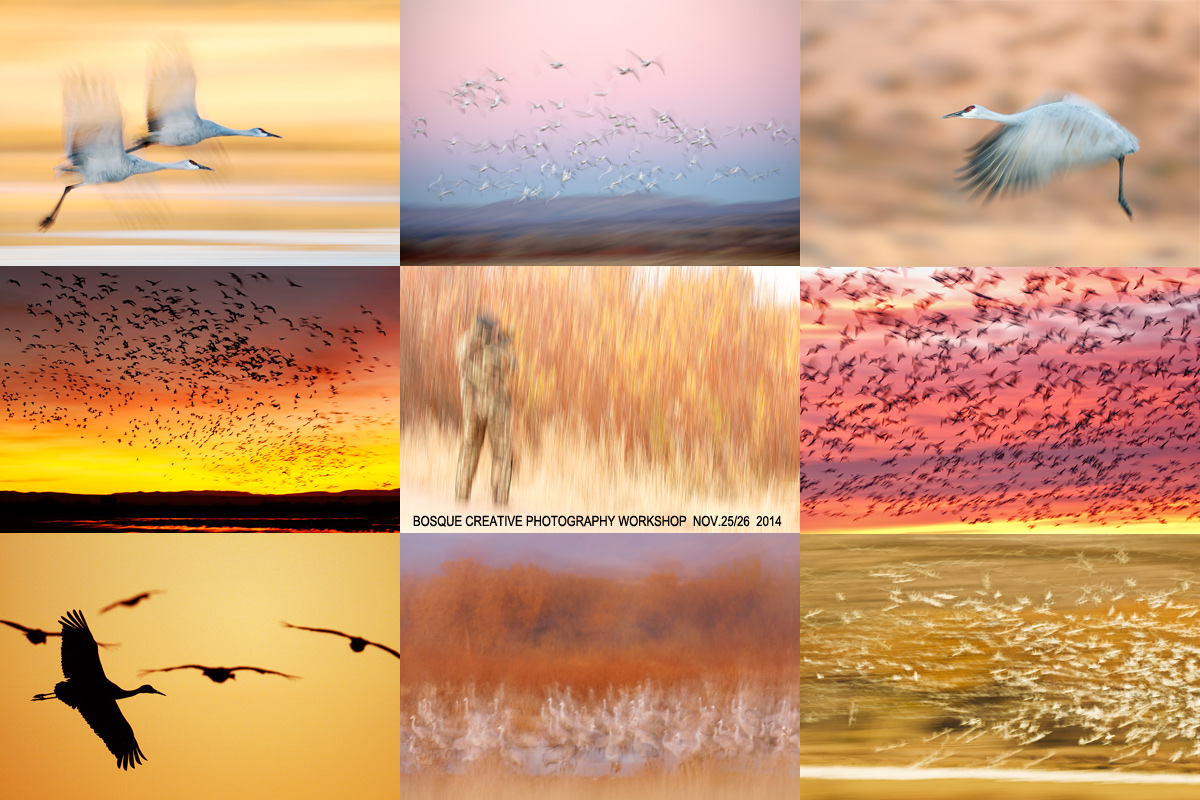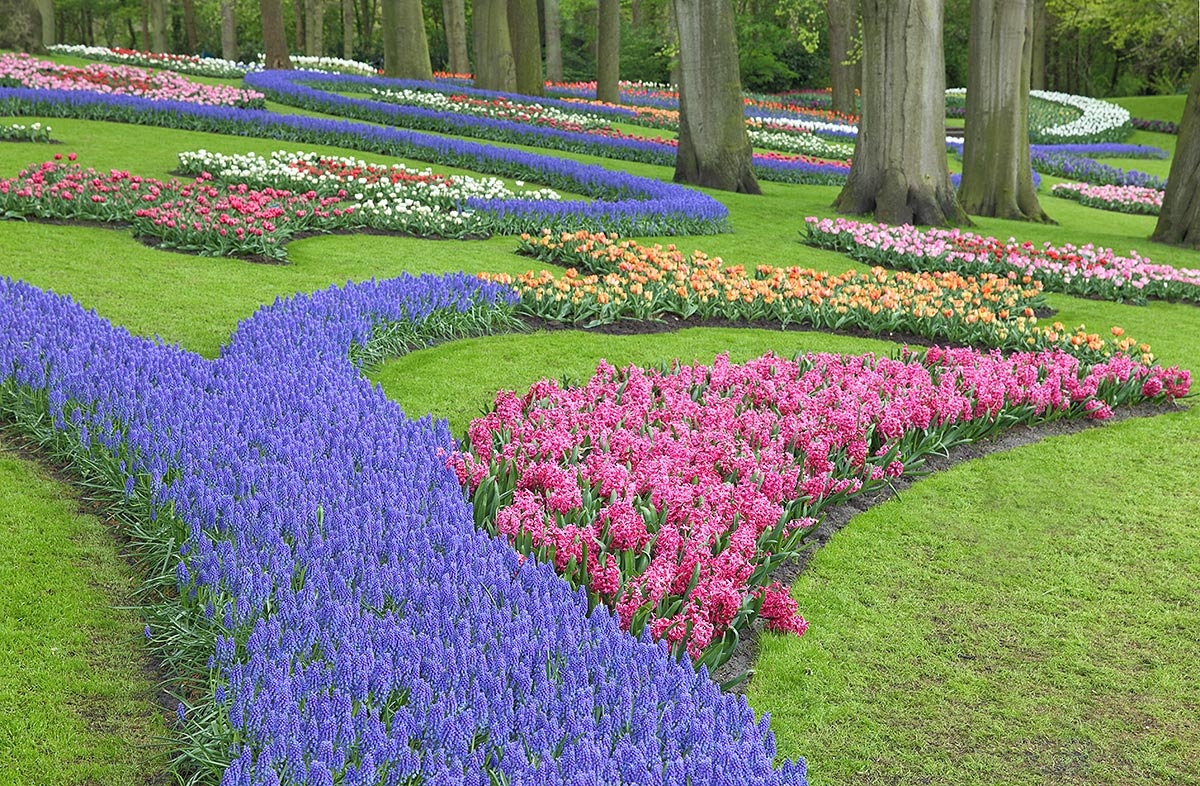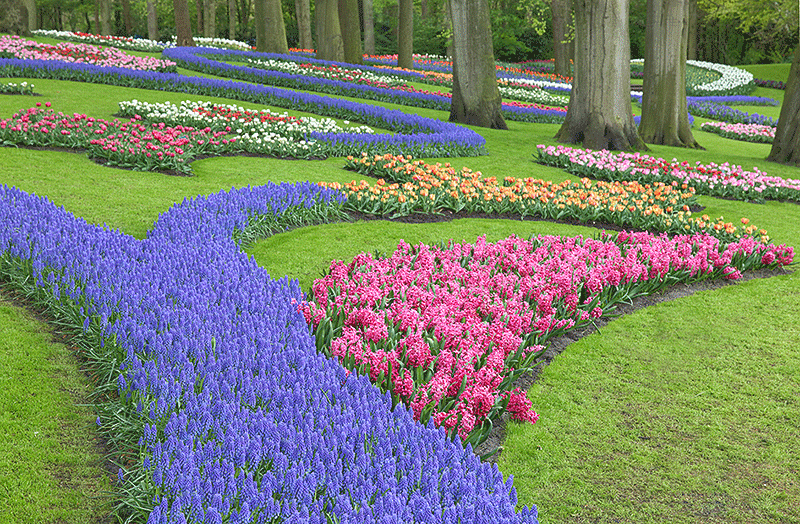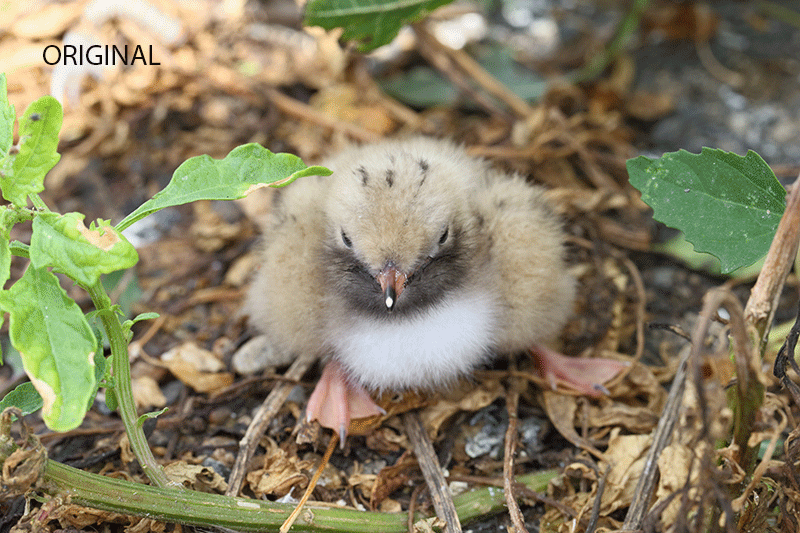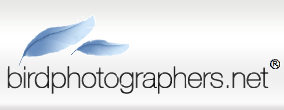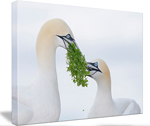August 14th, 2014 The Streak Continues: 257
This item was published just before 7:00am from my home at Indian Lake Estates, FL. This blog post, which took me 2 1/2 hours to prepare, marks 257 consecutive days with a new enjoyable and educational blog post. As always, I would appreciate your using the BIRDS AS ART B&H affiliate links for all of your major gear, video, and electronic purchases, using our Amazon logo-link for all of your household purchases, and visiting the BAA Online Store for your tripod, tripod head, LensCoat, miscellaneuos, accessories, and eGuide purchases as well.
The Art of Flower Photography
Click here if you missed yesterday’s eBook announcement.
Wrong For So Long…
It is a little-known fact that all pro-sumer and professional digital camera bodies create and embed a JPEG at the moment of capture even if you have your camera set to RAW only. Folks like me who use BreezeBrowser can highlight an image and then hit Shift/Control/X and follow the prompts to extract that JPEG. I have been doing that for years. When I open an extracted JPEG from the 1D X and bring it into Photoshop CS-6 and go Image > Image Size (or hit Shift/Control X the Image Size dialogue box shows the pixel dimensions as 5760 X 3840 or 63.3M. I have been telling folks for years that all quality digital camera bodies create very large JPEGs at the moment of RAW capture. How large with a 1D X? I have been telling folks confidently for years “63.3 MBs.
When I shared that “fact” with Arash Hazeghi while we were discussing the new DPP 4.0 RAW Conversion Guide he told me that I was flat out wrong. “The embedded JPEGs are actually quite small” he said. “You can see how small by going to My Computer, finding the image, right-clicking on it, and selecting Properties from the drop-down menu. When I do that with an extracted JPEG from the 1D X the File Size shows as 1.04 MB…. Even more confusing for me is that when I click on the details tab the pixel dimensions are exactly as they show in Photoshop, 5760 X 3840….
When I asked Arash why Photoshop showed the JPEGs as 5760 X 3840 pixels I did not understand it well enough to share with you here. Actually I did not understand it at all. It is quite obvious that I am confused. I am starting to realize that pixel dimensions have nothing to do with file size and that 63.3M does not mean 63.3 MB…
If you can leave a clear, lucid explanation that explains the basis of my confusion your help would be greatly appreciated.
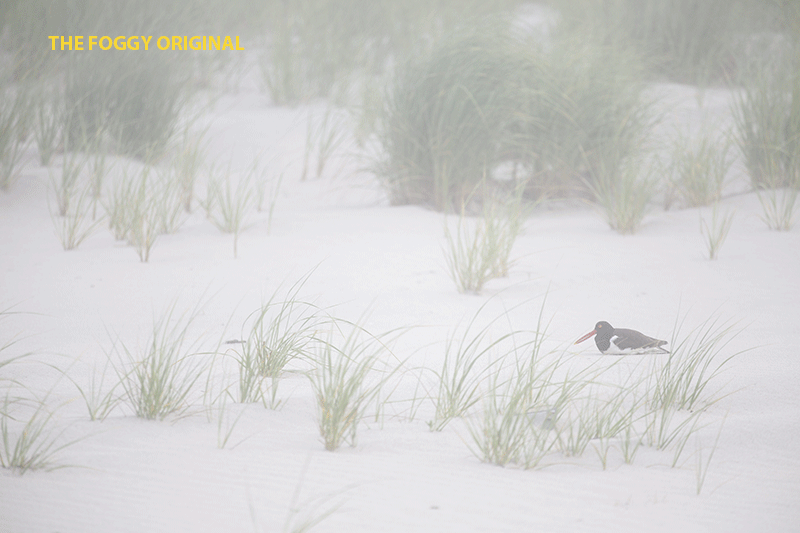
The animated GIF here compares the extracted JPEG (cropped to 800 pixels wide) with the optimized image (also cropped to 800 pixels wide).
|
The Foggy Image Optimization
After converting the image in DPP 4.0 I brought it into Photoshop CS-6 and did some clean-up work with the Clone Stamp Tool, the Spot Healing Brush, and several small Quick Masks that were fine-tuned with Regular Layer Masks. One Quick Mask layer was Warped. Next was a Levels adjustment but I did not move the shadow slider all the way to the clipping point (hold down the ALT key while moving the slider) as that made the image far too contrasty. I lowered the BLUE saturation about 40 points and raised the YELLOW saturation about 40 points, the latter to juice up the grasses a bit. I finished things off with a 10% Auto Contrast layer as taught to me by Denise Ippolito.
Image Questions
1-What were the 4 major clean-up projects?
2-Why is this an atypical BIRDS AS ART image?
3-What are the strong points of the image design?
The DPP RAW Conversion Guide
To learn why I use Canon’s Digital Photo Professional (DPP) to convert every image that I work on, click here. Coming soon: the DPP 4.0 RAW Conversion Guide by Arash Hazeghi with Arthur Morris.
Digital Basics
Most everything that I did to optimize today’s image above is detailed in my Digital Basics File–written in my easy-to-follow, easy-to-understand style. Are you tired of making your images look worse in Photoshop? Digital Basics File is an instructional PDF that is sent via e-mail. It includes my complete digital workflow, dozens of great Photoshop tips, details on using all of my killer clean-up tools, the use of Contrast Masks, several different ways of expanding and filling in canvas, all of my time-saving Keyboard Shortcuts, Quick Masking, Layer Masking, and NIK Color Efex Pro basics, Digital Eye Doctor, Tim Grey Dodge and Burn, how to create time-saving actions, and lots more.
APTATS I & II
Learn the details of advanced Quick Masking techniques in APTATS I. Learn Advanced Layer Masking Techniques in APTATS I. Mention this blog post and apply a $5 discount to either with phone orders only. Buy both APTATS I and APTATS II and we will be glad to apply at $15 discount with phone orders only. Please call Jim or Jennifer at 863-692-0906 weekdays to order.
Used Photography Gear for Sale
The “Old 600” that was featured in yesterday’s blog post sold right then and there. Though have sold a boatload of great gear recently, there are still some great buys available. Click here to see the complete listings. Below s today’s featured item.
Featured Lens
Used Canon 800mm f/56L IS USM Lens
Multiple IPT veteran and good friend Mike Gotthelf, is offering a used Canon EF 800mm f/5.6L IS USM lens in excellent + condition for $8850. The lens is like new except for some very minor wear on the finish. The sale includes the leather hood, the original hard case and key, a low foot, a LensCoat, and insured shipping via UPS Ground to US addresses only. Personal checks only; your new lens will be shipped only after your check clears.
This great lens, my favorite super-telephoto for more than 3 years, sells new at B&H for $13,999.00. B&H is asking $11,399.95 for a used one here in the same condition as Mike’s. They recently dropped their price for this lens from $11,999.90…. Buy Mike’s lens and save $2456.95 right now! It will save you a ton of dough and you will have a super-sharp lens with lots of reach. And it works great with a 1.4X TC too with all pro bodies and with the 5D Mark III.
Interested folks can contact Mike via e-mail or by phone at (978)-407-0679 (eastern time).
Selling Your Used Photo Gear Through BIRDS AS ART
Selling your used (or like-new) photo gear through the BAA Blog or via a BAA Online Bulletin is a great idea. We charge only a 5% commission. One of the more popular used gear for sale sites charges a minimum of 20% plus assorted fees! Yikes. The minimum item price here is $500 (or less for a $25 fee). If you are interested please e-mail with the words Items for Sale Info Request cut and pasted into the Subject line. Stuff that is priced fairly–I offer free pricing advise, usually sells in no time flat.
|
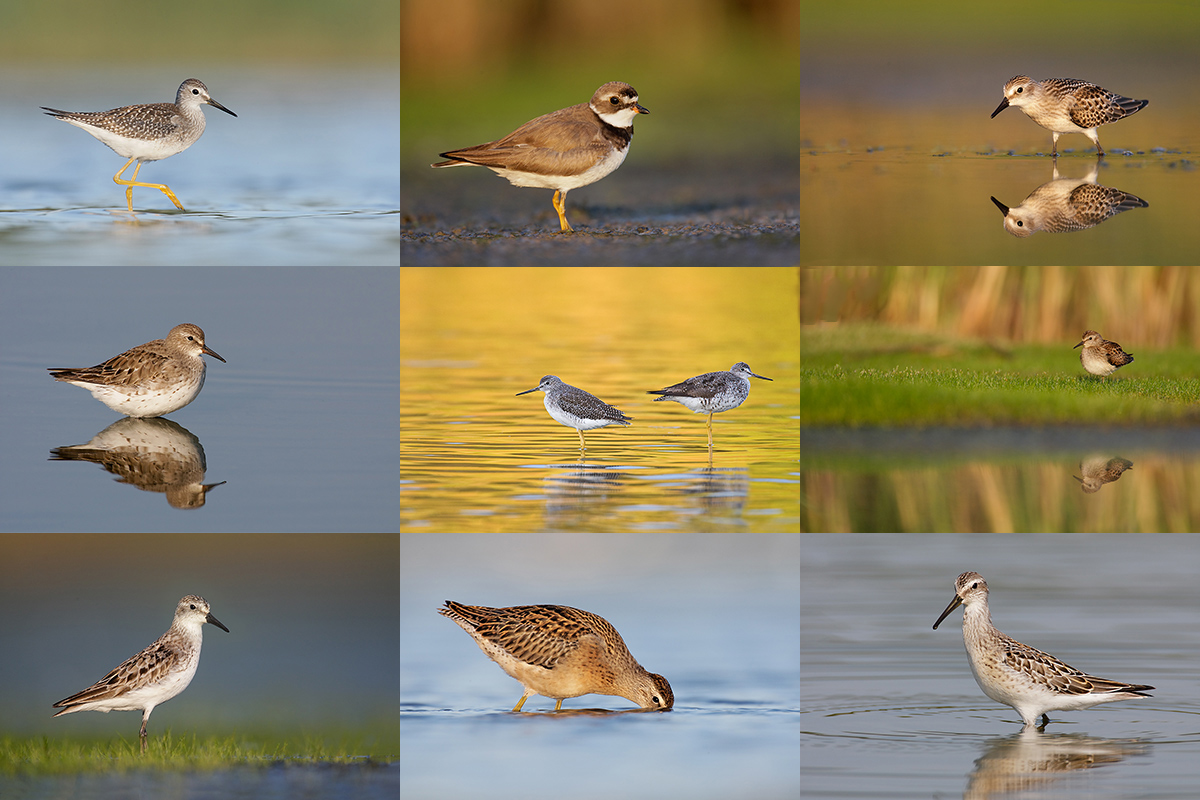
|
|
For me, the coolest thing about learning to identify shorebirds is that once you learn the basics it is actually easier to age a shorebird, that is, to tell if it an adult or a juvenile, than it is to identify it as to species. And with a bit of experience, study, and practice, identifying the common North American migrant shorebirds is nowhere as difficult as it is reputed to be. Advice: get yourself a copy of my Shorebirds: Beautiful Beachcombers, study, and get out to local ponds, estuaries, beaches, and mudflats as much as possible for the next month. Mid-August through early September is the best time of year to see both adult and fresh juvenile shorebirds together on migration. Better yet, join me at JBWR for two great mornings of shorebird photography while honing your identification and ageing skills and learning a ton about my favorite bird family. See below for details.
For the correct ageing and ID of each of the birds in the composite above, see the comments here.
|
JBWR Short-Notice Shorebird Photography and ID In-the-Field Morning Workshop Sessions
Saturday August 23 and Sunday August 24: sunrise till 10am followed by brunch and image review at a local diner: $299/morning session. $549 for both days. Limit 6.
Join me at Jamaica Bay Wildlife Refuge in Queens, NY for a morning or two of shorebird photography in the mud. You will learn to age and identify the common shorebirds that we will encounter. You will learn the best times, tides, and locations to visit for the very best shorebird photography on the east coast and why only a very few days each year offer the best chances for success. I will teach you how to get close; we will either be sitting in or lying on the hard mud. These two morning sessions offer you a chance to learn from someone who has spent more time studying and photographing the shorebirds of JBWR than anyone alive. Join me and you are invited to pick my brain; as is usual, I share everything that I know. For those who are coming from out of town who would like to photograph on either Saturday or Sunday afternoon I will be glad to offer location guidance and options. Some folks may wish to join me for a JBWR/Nickerson Beach double header. See below for Nickerson Beach details.
Payment in full is due when you register and is non-refundable. Call me on weekends or Jim or Jen weekdays at 863-692-0906 with a credit card in hand to register. Please print, complete, and sign the form that is linked to here and shoot us a scanned copy via e-mail or a hard copy via snail mail to BIRDS AS ART, PO Box 7245, Indian Lake Estates, FL 33855.
Nickerson Beach Short-notice Weekday Beach-nesting Birds IPT: 2-Full Days/August 25-26, 2014: $749. Leader: Arthur Morris
Join me on Long Island, NY soon to photograph Black Skimmers with chicks and young of all sizes, adult and juvenile Common Terns, and American Oystercatchers with grown young. The skimmers will be the stars of the show. Mid- to late August is prime time for photographing young skimmers. Chances are great to witness Great Black-backed Gull predation. The will also be chances to photograph a variety of shorebird species including large flocks of southbound migrant Sanderlings. Car-pooling is recommended; if we opt to return to the beach before 5pm there is a $30/vehicle parking fee that is not included so it is best to share that expense. Parking in the morning is free.
Call me on weekends or Jim or Jen weekdays at 863-692-0906 with a credit card in hand to register and leave a non-refundable $200 deposit. We will hold your spot pending the arrival of a check for your $549 balance. Checks should be made out to “Arthur Morris” and mailed to us at BIRDS AS ART, PO Box 7245, Indian Lake Estates, FL 33855. Please print, complete, and sign the form that is linked to here and shoot us a scanned copy via email or a hard copy via snail mail to the PO Box above.
If you have any questions please feel free to contact me via e-mail or by phone this weekend at 863-692-0906.
Facebook
Be sure to like and follow BAA on Facebook by clicking on the logo link upper right. Tanks a stack!
Support the BAA Blog. Support the BAA Bulletins: Shop B&H here!
We want and need to keep providing you with the latest free information, photography and Photoshop lessons, and all manner of related information. Show your appreciation by making your purchases immediately after clicking on any of our B&H or Amazon Affiliate links in this blog post. Remember, B&H ain’t just photography!
…..
Amazon Canada
Many kind folks from north of the border, ay, have e-mailed stating that they would love to help us out by using one of our affiliate links but that living in Canada and doing so presents numerous problems. Now, they can help us out by using our Amazon Canada affiliate link by starting their searches by clicking here. Many thanks to those who have written.
Typos
In all blog posts and Bulletins, feel free to e-mail or to leave a comment regarding any typos, wrong words, misspellings, omissions, or grammatical errors. Just be right. 🙂
August 13th, 2014
The Art of Flower Photography
Denise Ippolito and Arthur Morris are proud to announce the publication of The Art of Flower Photography, a 203 page eBook with more than 140 images: $29.00. A link to the PDF will be sent via e-mail. Get yourself a copy today so that you can learn and be inspired by the tour de force of flower photography how-to books. Purchase by clicking here, by calling BIRDS AS ART at 863-692-0906, or by sending a Paypal to us via e-mail.
Notice for i-Pad Users
It is easy to save and access any and all PDF files including The Art of Flower Photography and The Art of Bird Photography II on an i-Pad. Here is a link to a short easily-followed how-to tutorial: i-Pad PDF Tutorial.
|
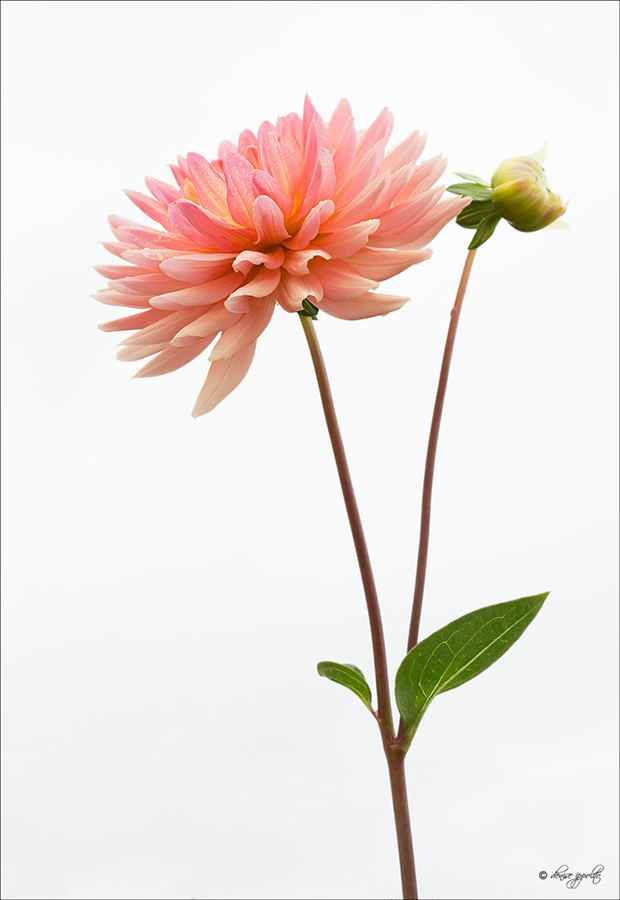
|
Dahlia, botanical print. Image copyright 2014: Denise Ippolito/A Creative Adventure.
Simply put, Denise Ippolito is a talented artist.
|
A Tour de Force
tour de force (ˈto͝or də ˈfôrs/) noun: an impressive performance or achievement that has been accomplished or managed with great skill. “The Art of Flower Photography is a tour de force.”
|
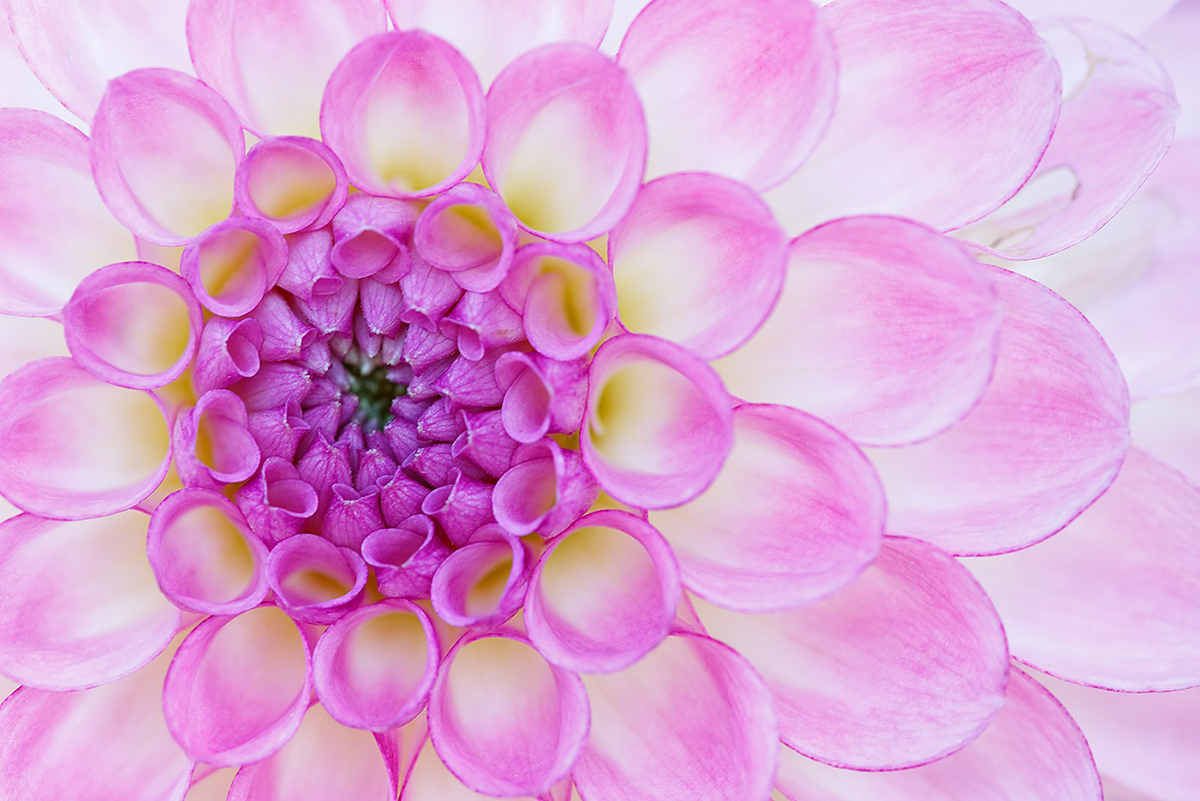
|
Dahlia, tight portrait. Image copyright 2014: Arthur Morris/BIRDS AS ART.
Like his bird photographs, artie’s flowers images tend to be clean, tight, and graphic.
|
The Project
Conceived by Denise Ippolito, six months in the making, The Art of Flower Photography is a summital achievement, the results of many hundreds of hours of effort. Thanks to Carol Carson for her careful review of the manuscript.
|
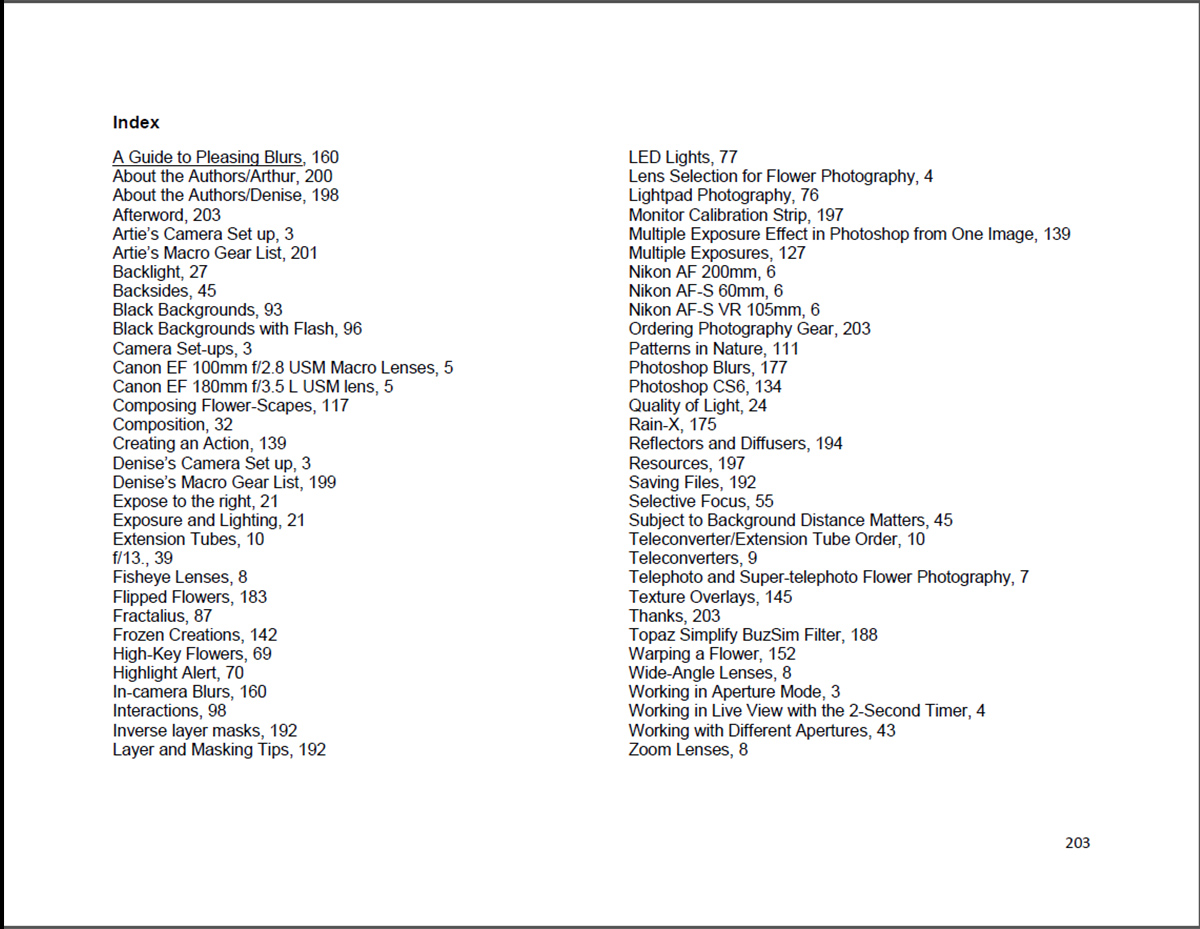
|
|
The Index of The Art of Flower Photography.
|
What You Will Learn?
In short, you will–as a glance at the eBook’s index above shows, learn everything about flower photography that you wanted to know but were afraid to ask.
We cover lens, gear, and accessory selection, in-the-field techniques, image design and composition, understanding and using the light, getting the right exposure, aperture choice and depth-of-field, focusing techniques, and a variety of post processing and Photoshop techniques. Among others.
Part of the strength of this eBook is that though both denise and artie produce beautiful and inspiring images on a consistent basis, they often use different lenses and different techniques to achieve their visions. In The Art of Flower Photography you get to pick the brains of two very fine photographers.
|
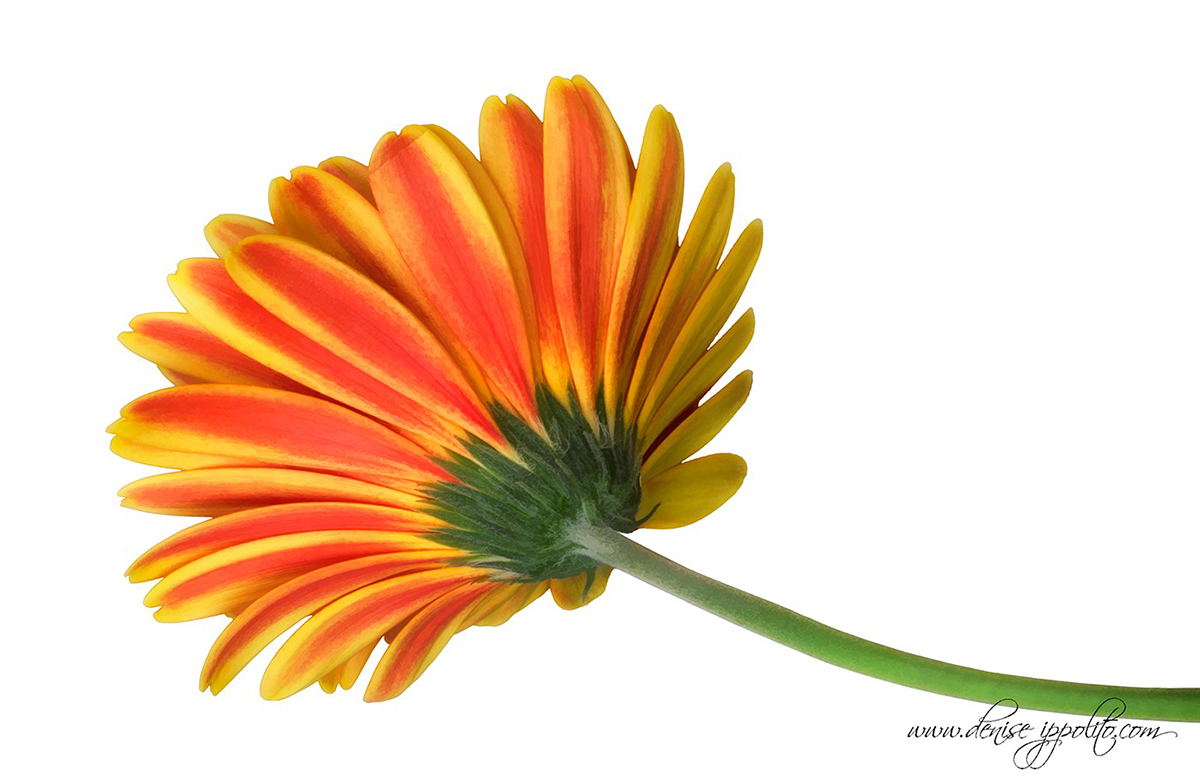
|
Gerbera Daisy after warping and rotation, Topaz Simplify BuzSim applied. Image copyright 2014: Denise Ippolito/A Creative Adventure.
Denise is as skilled and creative at the computer and in Photoshop as she is in a field of flowers.
|
Author Backgrounds
Denise Ippolito
Denise has been involved with flowers for much of her life. She is a fifth generation florist who owned and operated a successful flower shop. Subsequently, she then ran first one and then another garden center for the next ten years. Denise has since become a skilled flower photographer; and she has succeeded admirably. Her incredibly creative mind led her to experimenting with both in-the-field techniques and creative post processing effects using Photoshop and several plug-in applications to create the artistic flower renditions that are presented in this eBook.
Arthur Morris
Arthur is a world renowned photographer, and a member of Canon’s “Explorers of Light” program. Although Artie is perhaps best known for his superb bird photography, with thousands of his images gracing the pages of numerous books, magazines, and other publications, he has recently extended his subject matter by redirecting his lenses to capture images of flowers that emphasize their form, pattern, and texture.
|
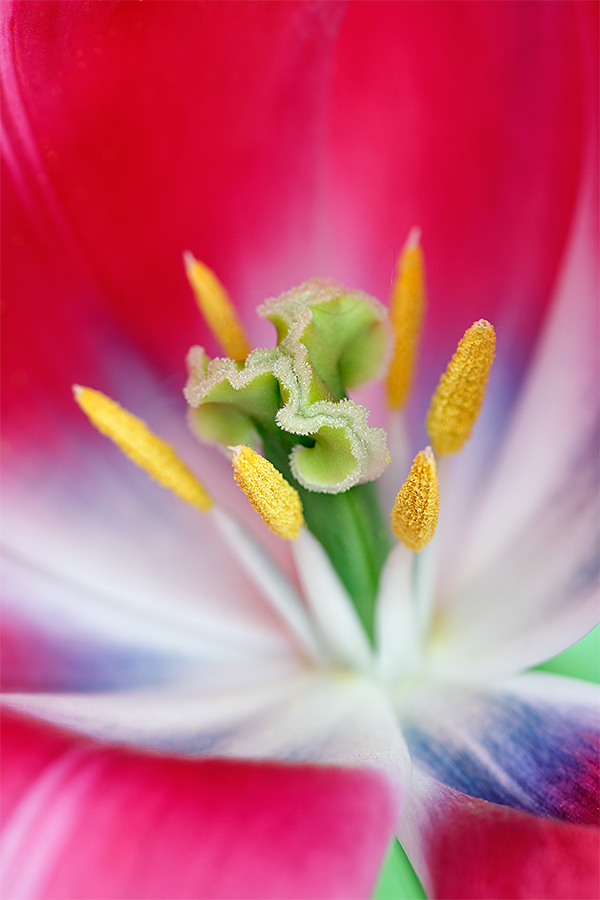
|
Tulipa Renown. Image copyright 2014: Arthur Morris/BIRDS AS ART.
On average, artie works with longer focal length lenses than denise. In this new eBook, he shares the techniques that he has developed for using super-telephoto lenses for flower photography. This image was created with the Canon EF 180mm f/3.5L Macro USM lens that denise owns but rarely uses as she much prefers the Canon EF 100mm f/2.8L Macro IS USM lens
|
The Team
The Art of Flower Photography combines the creative energy, the technical proficiency, and the artistic visions of Denise Ippolito and Arthur Morris. Together they form a dynamic teaching team that lectures and conducts seminars and workshops across the country and internationally. They are both multiple award winning photographers who specialize in making world class images of birds, flowers, wildlife, the natural world and Urbex subjects.
The First Review
The first review is in. From Carol Carson via e-mail:
Inspiration and instruction from two experts with different shooting styles–how can you top that? Denise and Artie have produced a must-have addition to the flower photographer’s eLibrary.
|
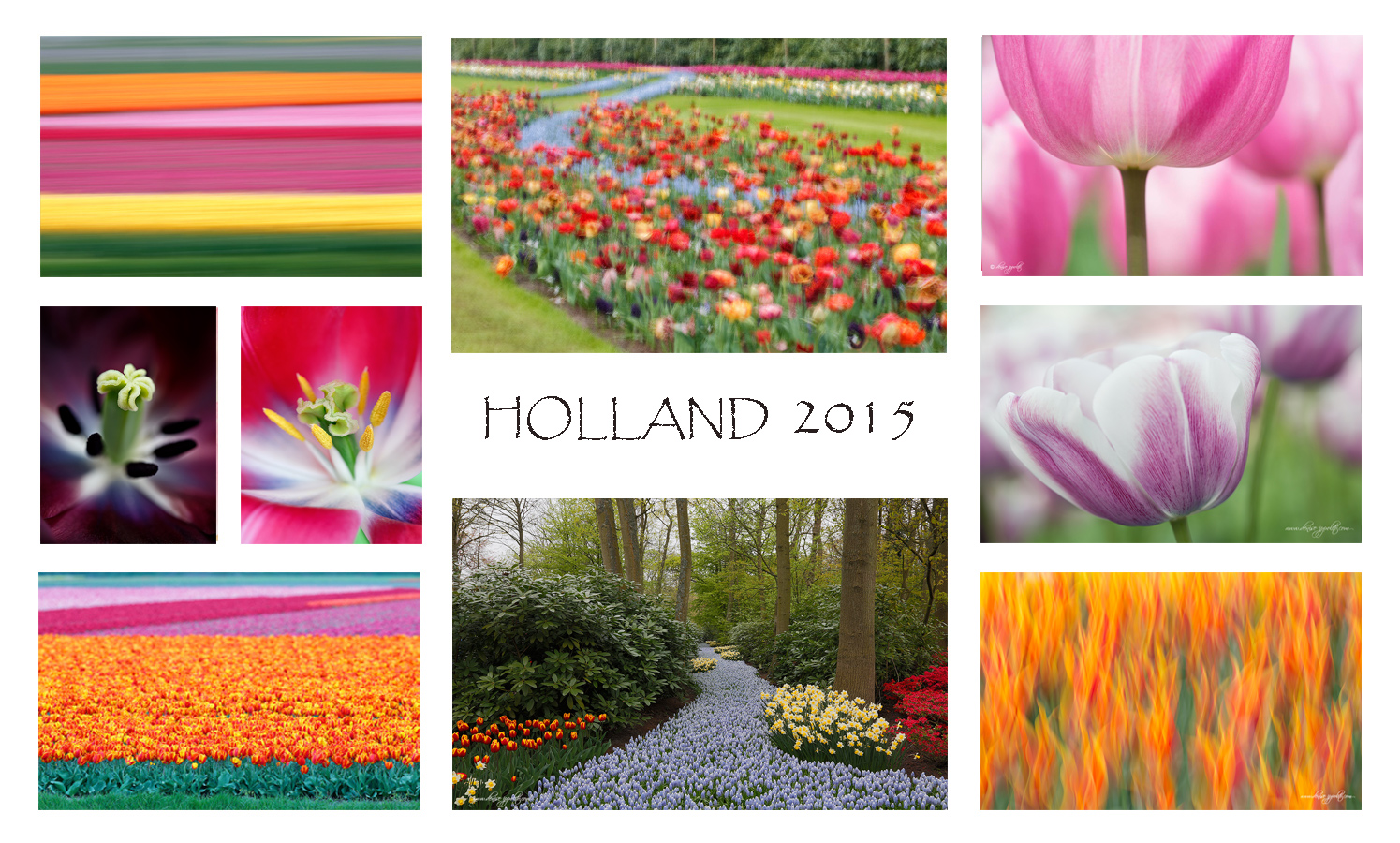
|
|
Denise and artie hope that you can join them next spring in Holland and learn to improve both the technical and creative aspects of your flower (and street) photography.
|
7 1/2-Day/8-Night: A Creative Adventure/BIRDS AS ART/Tulips & A Touch of Holland Instructional Photo-Tour (IPT)
Keukenhof—Delft—Amsterdam–Flower Fields—Kinderdijk
April 9 -April 16, 2015: $4995. Limit: 12 photographers/Openings 10. Four more to make the trip a go.
This trip is a go.
August 12th, 2014 The Streak Continues: 255
This item was published just after 8:30am from my home at Indian Lake Estates, FL. This blog post, which took me 2 hours to prepare, marks 255 consecutive days with a new enjoyable and educational blog post. As always, I would appreciate your using the BIRDS AS ART B&H affiliate links for all of your major gear, video, and electronic purchases, our Amazon logo-link for all of your household purchases, and visiting the BAA Online Store for your tripod, tripod head, LensCoat, miscellaneuos, accessories, and eGuide purchases as well.
Coming Soon
The release of the great new eBook, “The Art of Flower Photography” by Denise Ippolito and Arthur Morris is imminent. Everything that you wanted to know about how to photograph flowers but were afraid to ask….
|
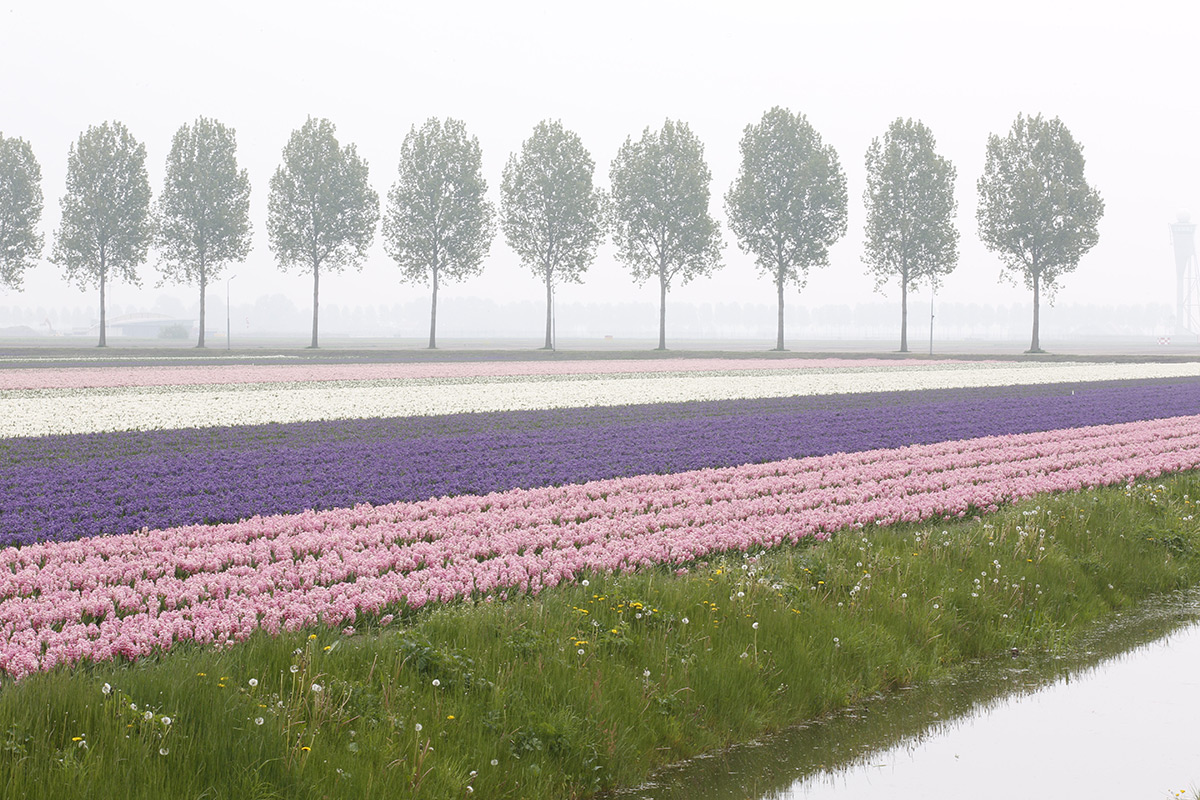
|
|
This image was created on a very foggy morning on last spring’s Tulips and a Touch of Holland IPT with the Gitzo 3532 LS carbon fiber tripod, the Mongoose M3.6 head, the Canon EF 70-200mm f/2.8L IS II USM lens (at 125mm) and the Canon EOS 5D Mark III . ISO 100. Evaluative metering at zero: 1/8 sec. at f/32 in Tv mode. AWB. Live View and 2-second timer. At zero I had some significant blinkies in the sky which is exactly what i wanted and needed to assure some detail in the darker tones of the trees. Zero as framed worked out to more than +3 stops off the sky.
Central Sensor/Surround/AI Servo-Rear Focus AF one-third of the way into the frame and re-compose. Click here to see the latest version of the Rear Focus Tutorial. Click on the image to see a larger version.
The Original Image
|
GPS Navigation Serendipity
We paid extra freight so that both of the vehicles that we rented for last spring’s Tulips and a Touch of Holland IPT would be equipped with GPS Navigation systems. In English not Dutch. I usually do not have good luck with such devices. Though both spoke English, we did not get off to a very good start… The GPS system in Denise’s vehicle could not find our major hotel. Just for the heck of it we tried to find Keukenhoff Gardens under Attractions. No luck there. Ominous. My GPS got us to the hotel. Great. The next morning we programmed in the Kuekenhoff address. It got us there but opted for the very long route. The 20 minute trip took us twice that. But as we approached a quite lovely yellow pedestrian bridge I noted some nice flower fields off to our left perhaps half a mile down a country lane.
The next morning we decided to get intentionally lost again and check out the fields. There were some very nice tulip fields to our right, and some very nice hyacinth fields on our left. We enjoyed a good session, made some nice images, and headed towards some of the more well known flower fields that turned out to be in spectacular bloom. A few mornings later we opted to split the group in two with most folks heading directly to Kuekenhoff while Mike Gotthelf, one or two others, and I joined by the late-arriving Peter Kes re-visited the newfound fields. We learned upon closer inspection that these new fields actually abutted the Amsterdam airport.
We enjoyed the fog and worked on the left side of the road with the hyacinth fields and the line of trees behind it. If you enlarge the image and check out the areas between the trees you can see lots of telephone poles and airport structures sort of lost in the fog…. As for the fog, I knew that there was a striking, vibrant image waiting to be created from the somewhat flat and boring original image above. My plan was to eliminate all traces of the airport in the background and then to juice up the colors and contrast to give the image some much-needed pop.
|
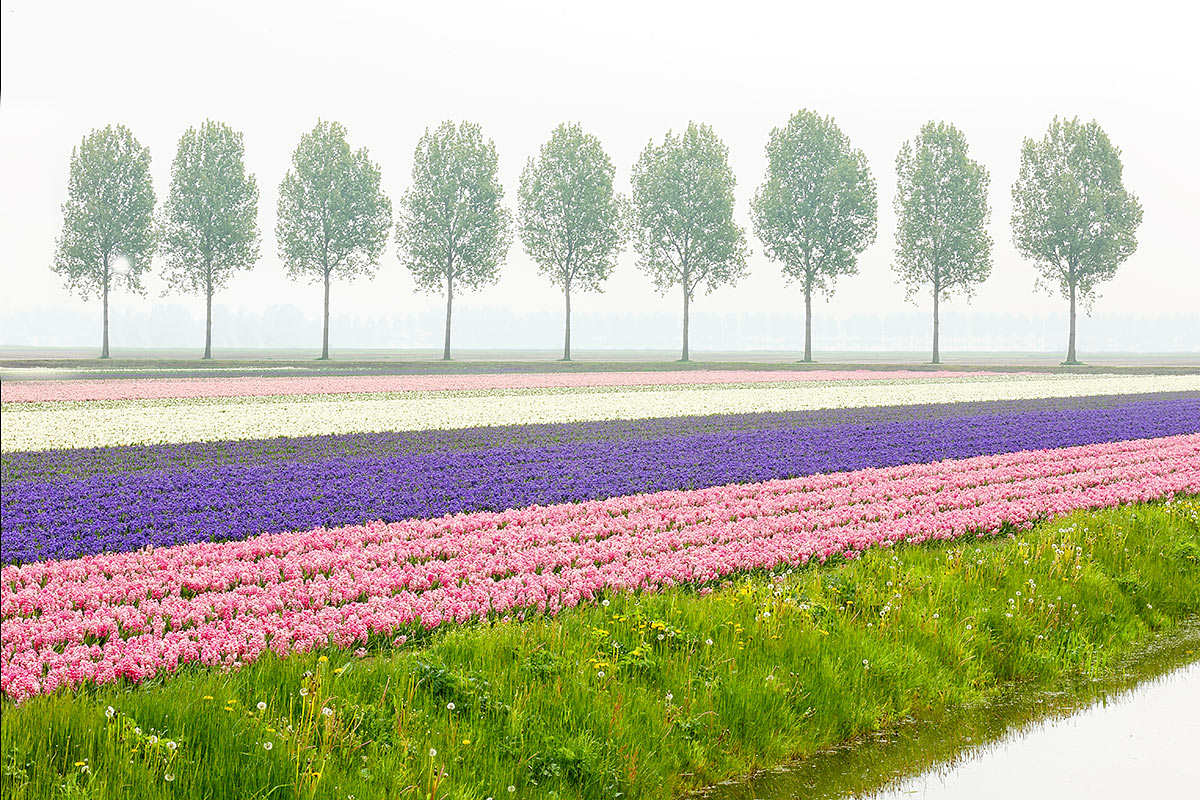
|
The Optimized Image
|
The Image Optimization
Airport Elimination and Working In and With the Fog
This is the first image that I converted in DPP 4.0. There is a lot to learn and most of what I did was somewhat experimental. I did enjoy working with the new “Adjust image colors” tab that is the equivalent of the HSL tab in Photoshop CS-6. I need to get with Arash, ask some questions, and then incorporate lots of new stuff into the DPP 4.0 RAW Conversion Guide that we are working on.
The first thing that I did after bringing the image into Photoshop was clean up the airport stuff in the background. I began with the Clone Stamp Tool and some Patch Tool work. Once I had cleaned up two or three areas between the trees I used the Rectangular Marquee Tool to select a now clean area, put that selection on a new layer (Ctrl J), moved it into place with the Move Too (V), and fine-tuned the layer with a Regular Layer Mask. Once that clean-up work was done I painted a Quick Mask of the right side of the image at horizon level (Q, B, Q), put that on its own layer (Ctrl J), flipped that horizontally, and covered the intruding tree on the left side of the frame. I used a Regular Layer Mask to fine tune the repair. Then I used the Spot Healing Brush to get rid of a single prominent Dandelion.
Now I was ready for the juicing-up process. I brought the image into NIK Color Efex Pro 4 and applied Tonal Contrast at 100% and Detail Extractor at 35%. Next I boosted the Vibrance about 40 points, put the whole thing on a layer (Ctrl J), and applied Auto Contrast at about 40%. Thanks as always to Denise Ippolito for teaching me that one. Then I lightened the image by pulling up the curve (Ctrl M). Last was my artistic crop from the right and below all the while maintaining the original 3X2 proportions.
Then I named and saved my optimized TIFF file and created the 1200 pixel wide JPEG that you see immediately above.
Of Note
#1: I did not use Levels to totally eliminate the foggy look. By using NIK Tonal Contrast and Auto Contrast at 40% I was able to maintain the foggy look while adding some pop to the image.
#2: the keys to the compositional success of this image are the use of diagonal lines and the compositional balance that came as a result of eliminating the clipped tree on the left and cropping from the bottom and the right.
#3: I am not sure where the thin line in the upper right corner of the JPEG came from. It does not appear in the optimzed TIFF file…. It pretty much disappears into the frame edge when you enlarge the image.
The DPP RAW Conversion Guide
To learn why I use Canon’s Digital Photo Professional (DPP) to convert every image that I work on, click here. Coming soon: the DPP 4.0 RAW Conversion Guide by Arash Hazeghi with Arthur Morris.
Digital Basics
Most everything that I did to optimize today’s image above is detailed in my Digital Basics File–written in my easy-to-follow, easy-to-understand style. Are you tired of making your images look worse in Photoshop? Digital Basics File is an instructional PDF that is sent via e-mail. It includes my complete digital workflow, dozens of great Photoshop tips, details on using all of my killer clean-up tools, the use of Contrast Masks, several different ways of expanding and filling in canvas, all of my time-saving Keyboard Shortcuts, Quick Masking, Layer Masking, and NIK Color Efex Pro basics, Digital Eye Doctor, Tim Grey Dodge and Burn, how to create time-saving actions, and lots more.
APTATS I & II
Learn the details of advanced Quick Masking techniques in APTATS I. Learn Advanced Layer Masking Techniques in APTATS I. Mention this blog post and apply a $5 discount to either with phone orders only. Buy both APTATS I and APTATS II and we will be glad to apply at $15 discount with phone orders only. Please call Jim or Jennifer at 863-692-0906 weekdays to order.
Used Photography Gear for Sale
The “Old 600” that was featured in yesterday’s blog post sold right then and there. Though have sold a boatload of great gear recently, there are still some great buys available. Click here to see the complete listings. Below are today’s featured items.
Today’s Featured Lenses
Used Canon 300mm f/4L IS USM Lens
Chris Callahan is offering a used Canon 300mm f/4L IS USM Lens in good to very good condition for $900. There is some wear on the finish. The sale includes the heavy duty fabric carrying case that is moderately worn, the tripod ring (tripod collar), and the rear cap. The seller will pay insured UPS shipping within continental US. The lens will ship after the check clears.
Please contact Chris via e-mail or by phone at 1-850-516-7155 (eastern time).
I have long recommended this lens as the best Canon bird photography starter lens, a clear choice over my old “toy lens,” the 400mm f/5.6L. Why? It is faster at f/4. It has IS. And it autofocuses with a 7D and a 1.4X teleconverter. The 300 f/4 L IS has great close focus making it great for frogs, butterflies, medium-sized and large flowers, and large insects like dragonflies. It is a great flight lens either alone or with the 1.4X TC. And it is deadly sharp. It is great on a tripod with the Mongoose M3.6.
Used Canon EF 100-400 f 4.5-5.6 L IS Lens
Bruce Boswell is offering a used Canon EF 100-400 f 4.5-5.6 L IS lens in very good condition for $999 plus insured shipping via UPS Ground to US Continental addresses only. The tripod and zoom rings have a few minor blemishes. The sale includes: the original case, the front and rear caps, the lens hood, and the lens manual. Your gear will be shipped only after your check clears.
Please contact Bruce via e-mail ourpals5@msn.com or by phone at (309) 451-1506 or (309) 530-8493 (cell) (Central).
The 100-400 is a versatile intermediate telephoto zoom lens with 1,000+ uses. This one is priced to sell.
Selling Your Used Photo Gear Through BIRDS AS ART
Selling your used (or like-new) photo gear through the BAA Blog or via a BAA Online Bulletin is a great idea. We charge only a 5% commission. One of the more popular used gear for sale sites charges a minimum of 20% plus assorted fees! Yikes. The minimum item price here is $500 (or less for a $25 fee). If you are interested please e-mail with the words Items for Sale Info Request cut and pasted into the Subject line. Stuff that is priced fairly–I offer free pricing advise, usually sells in no time flat.
|

|
|
Denise and artie hope that you can join them next spring in Holland and learn to improve both the technical and creative aspects of your flower (and street) photography.
|
7 1/2-Day/8-Night: A Creative Adventure/BIRDS AS ART/Tulips & A Touch of Holland Instructional Photo-Tour (IPT)
Keukenhof—Delft—Amsterdam–Flower Fields—Kinderdijk
April 9 -April 16, 2015: $4995. Limit: 12 photographers/Openings 10. Four more to make the trip a go.
This trip needs 6 registrants to run so please do not purchase your plane tickets until you hear from us that the trip is a go.
Join Denise Ippolito, the author of “Bloomin’ Ideas,” and Arthur Morris, Canon Explorer of Light Emeritus, for a great trip to Holland in mid-April 2015. Day 1 of the IPT will be April 9, 2015. We will have a short afternoon get-together and then our first photographic session at the justly-famed Keukenhof. Our last day, Day 8, April 16 will be a full day of photography.
The primary subjects will be tulips and orchids at Keukenhof and the spectacularly amazing tulip, hyacinth, and daffodil bulb fields around Lisse and points north. We will spend one full day in Amsterdam. There will be optional visits to the Van Gogh Museum, the Anne Frank House and/or the Rijk’s Museum. Street photography and sightseeing will be other options. We will spend a half day at Kinderdijk where we will be photographing the windmills and doing some creative photography. We will spend an afternoon in the lovely Dutch town of Delft where we will do some street photography and shopping. There is an optional church tower tour/climb. We will also enjoy a superb fine dining experience in a traditional restaurant.
Other than the arrival date: April 9, Day 1, and the date of our last day of photography on April 16, Day 8, there is no set itinerary. We will check the weather and play everything by ear to maximize the photographic opportunities. We will try to do Amsterdam, Delft, and especially Kinderdijik, on cloudy days.
There are several huge pluses to this trip. First off, denise is an amazingly skilled and caring instructor. Both her creativity and her willingness to share and to help beginning and intermediate photographers are unmatched. And though artie has learned a ton about flower photography from denise, their styles and techniques do vary considerably. You will have a chance to be counseled by and to learn from both of them. While denise will hunt you down to help you, artie’s teaching style is more “the closer you stay to me, the more you will learn.” Both leaders consistently inspire the participants. And each other. The sky, of course, is the limit.
You will learn to create tight abstracts, how best to use depth-of-field (or the lack thereof) to improve your flower photography, how to get the right exposure and make sharp images every time, how to see the best shot, and how to choose the best perspective for a given situation. And you will of course learn to create a variety of pleasingly blurred flower images. If you bring a long lens, you will learn to use it effectively for flower photography. Denise’s two favorite flower lenses are the Canon EF 100mm f/2.8L Macro IS USM lens and the Canon EF 24-105mm f/4L IS USM lens. Mine are the Canon 100mm f/2.8L IS macro , the Canon EF 180mm f/3.5L Macro USM lens ,and the Canon EF 300mm f/2.8L IS II USM lens, all almost always on a tripod. Often with extension tubes and/or either the 1.4X or the 2X (with the 300 II) teleconverters. Denise hand holds a great deal of the time. For flower field blurs denise uses the same lenses mentioned above along with her new 70-200mm f/2.8L IS III lens. Artie’s favorite is that same 70-200 often with a 1.4X TC but he uses both the new Canon EF 24-70mm f/2.8L II USM lens and the 300 II as well. Both of us use and love the Canon EOS 5D Mark IIIfor all of our flower photography. The in-camera HDR and Multiple Exposure features are a blast.
One of the great advantages of our trip is that we will be staying in a single, strategically located hotel that is quite excellent. Do note that all ground transfers to and from Schipol Airport will be via the free hotel shuttle bus.
What’s included: Eight hotel nights. All ground transportation except for airport transfers as noted above. In-the-field instruction and small group image review and Photoshop sessions. All meals from dinner on Day 1 through dinner on Day 8. There is good food at the hotel and we will be dining there on occasion; whenever you order off the menu be it at the hotel or at another restaurant only the cost of your main course is included. On these occasions the cost of soups, appetizers, salads, sodas and other beverages, alcoholic drinks and wine, bottled water, and desserts are not included. Snacks, personal items, phone calls, etc. are also not included. The cost of bus or train transportation to and from Amsterdam (about $20 US), museum entry, and tower and church entry fees (optional) are likewise not included.
Beware of seemingly longer, slightly less expensive tours that include travel days and days sitting in the hotel doing nothing as part of the tour. In addition, other similar trips have you changing hotels often and needlessly. One final note on other similar trips: the instructors on this trip actually instruct. On other similar trips the instructors, though usually imminently qualified, serve for the most part as van drivers and van door openers.
A non-refundable deposit of $1,000 per person is required to hold your spot. The second payment of $2,000 due by October 30, 2014. The balance is due on January 15, 2015. Payments in full are of course welcome at any time. All payments including the deposit must be by check made out to “Arthur Morris.” As life has a way of throwing an occasional curve ball our way, you are urged to purchase travel insurance within 15 days of our cashing your check. Artie uses and recommends Travel Insurance Services. All payments are non-refundable unless the trip fills to capacity. In that case, all payments but your deposit will be refunded. If the trip does not run every penny will of course be refunded. Again, please do not purchase your air tickets until you hear from us that the trip is a go. We are very confident that it will.
All checks should be made out to “Arthur Morris” and sent to: Arthur Morris, PO Box 7245, Indian Lake Estates, FL 33855. Call Jim or Jen in the BAA office with any additional registration questions: 863-692-0906.
For couples or friends signing up at the same time for the tulip trip, a $200/duo discount will be applied to the final payment.
When you send your deposit check, please print, sign, and include the paperwork here.
If you have any questions on the trip please contact artie by e-mail or denise by e-mail.
Facebook
Be sure to like and follow BAA on Facebook by clicking on the logo link upper right. Tanks a stack!
Support the BAA Blog. Support the BAA Bulletins: Shop B&H here!
We want and need to keep providing you with the latest free information, photography and Photoshop lessons, and all manner of related information. Show your appreciation by making your purchases immediately after clicking on any of our B&H or Amazon Affiliate links in this blog post. Remember, B&H ain’t just photography!
…..
Amazon Canada
Many kind folks from north of the border, ay, have e-mailed stating that they would love to help us out by using one of our affiliate links but that living in Canada and doing so presents numerous problems. Now, they can help us out by using our Amazon Canada affiliate link by starting their searches by clicking here. Many thanks to those who have written.
Typos
In all blog posts and Bulletins, feel free to e-mail or to leave a comment regarding any typos, wrong words, misspellings, omissions, or grammatical errors. Just be right. 🙂
August 11th, 2014 The Streak Continues: 254
This post was published just before 6:15am from my home at Indian Lake Estates, FL. I spent yesterday afternoon and evening glued to the TV, enthralled by the excitement and the incredible quality of play in the final round of the PGA Championship. Kudos to Rory McIlroy who is on an incredible hot streak having won the last three tournaments and the last two majors. This post, which took me only 1 1/2 hours to prepare, marks 254 consecutive days with a new enjoyable and educational blog post.
With so many folks getting in the habit of using our B&H links and our Amazon logo-links, why quit now? April, May, and June were fantastic. July was good. Lots of folks are getting the message: using my affiliate links does not cost you a penny and helps support my efforts here. To show your appreciation, I do ask that you use our B&H and Amazon affiliate links on the right side of the blog for all of your purchases. Please check the availability of all photographic accessories in the BIRDS AS ART Online Store, especially Gitzo tripods, Wimberley tripod heads, and the like. We sell only what I have used and tested, and know that you can depend on. We will not sell you junk. We know the tools that you need to make creating great images easy and fun. And we are always glad to answer your gear questions via e-mail.
You can find the following items in the store: Gitzo tripods, Mongoose M3.6 and Wimberley heads, plates, low feet, and accessories, flash brackets, , Delkin e-film Pro Compact Flash Cards, LensCoat products, and our unique line-up of educational materials including ABP I & II, Digital Basics, Site and Set-up e-Guides, Canon and Nikon Camera Users and AF e-Guides, and MP-4 Photoshop video tutorials among others.
I would of course appreciate your using our B&H affiliate links for all of your major gear, video, and electronic purchases. For the photographic stuff mentioned in the paragraph above we, meaning BAA, would of course greatly appreciate your business. Here is a huge thank you to the many who have been using our links on a regular basis and visiting the BAA Online store as well.
JBWR & Nickerson Beach Short-Notice Workshop Opportunities
Scroll down for information on the mid-August Jamaica Bay Wildlife Refuge In-the Field Morning Sessions and the 2-DAY Nickerson Beach IPT.
|
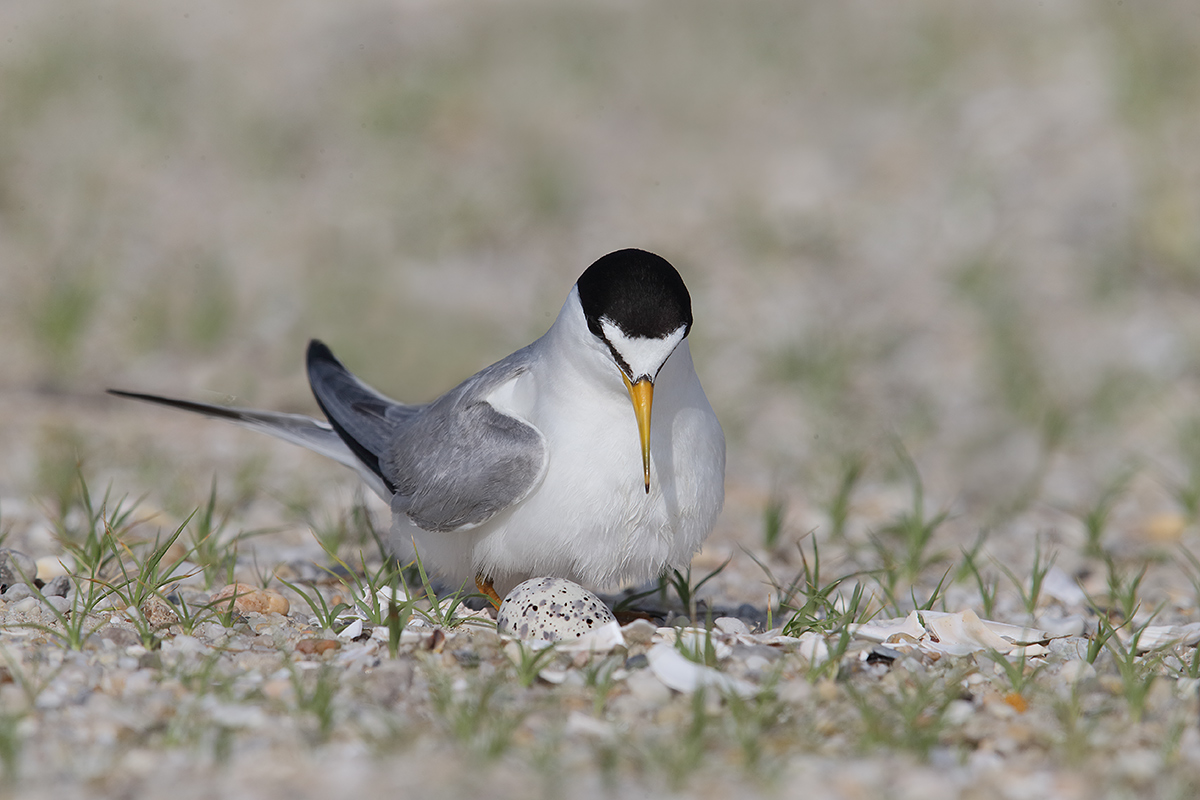
|
|
This image was created at Jones Beach at 5:27pm on July 16, 2014, day 2 of the Nickerson Beach IPT. I sat behind the Gitzo 3532 LS carbon fiber tripod, the Mongoose M3.6 head, the Canon EF 600mm f/4L IS II USM lens, the Canon Extender EF 2X III, and the Canon EOS-1D X. ISO 400. Evaluative metering +1 stop: 1/1000 sec. at f/11 in Manual mode. AWB.
Central Sensor (by necessity)/AI Servo-Expand/Rear Focus AF just bird’s neck directly above the egg was active at the moment of exposure. When you add the 2X TC to an f/4 lens with the 1DX or the 5D III hit the MFn button once to toggle to AF Expand and enjoy 4 extra AF sensors. Learn everything there is to know about the 1D X and 5D III AF systems including how to manage the various AF Area Selection Modes, when to use which one, and several ways to move the AF sensor around in the 1D X AF Guide and the 5D Mark III User’s Guide. Click here to see the latest version of the Rear Focus Tutorial. Click on the image to see a larger version. .
Image #1: Adult Least Tern at nest with single egg
|
Thanks Again Dr. Greg
Thanks again to Dr. Greg Gulbransen for alerting me to the presence of a small Least Tern colony at Jones Beach just before the Nickerson IPT began and then keeping me updated on the status of the nest and egg featured in the opening image. Greg recently saw Hillary Clinton and had a chance to bring her up to date with the Rear View Camera legislation and the lawsuit. If you missed that amazing story, you can learn more in the How Can a Man Who Runs Over and Kills His 2-Year Old Son While Backing Up His Car Become a Hero? blog post.
In his last e-mail he wrote:
I made her feel proud of what she had done (helped save at least 59-69 lives a year according to the DOT–the Department of Transportation); she was wild with joy. It’s pretty cool to be able to impress the next president of the USA. She met my family again and we had a great time. I was on top of the world and so was she.
|
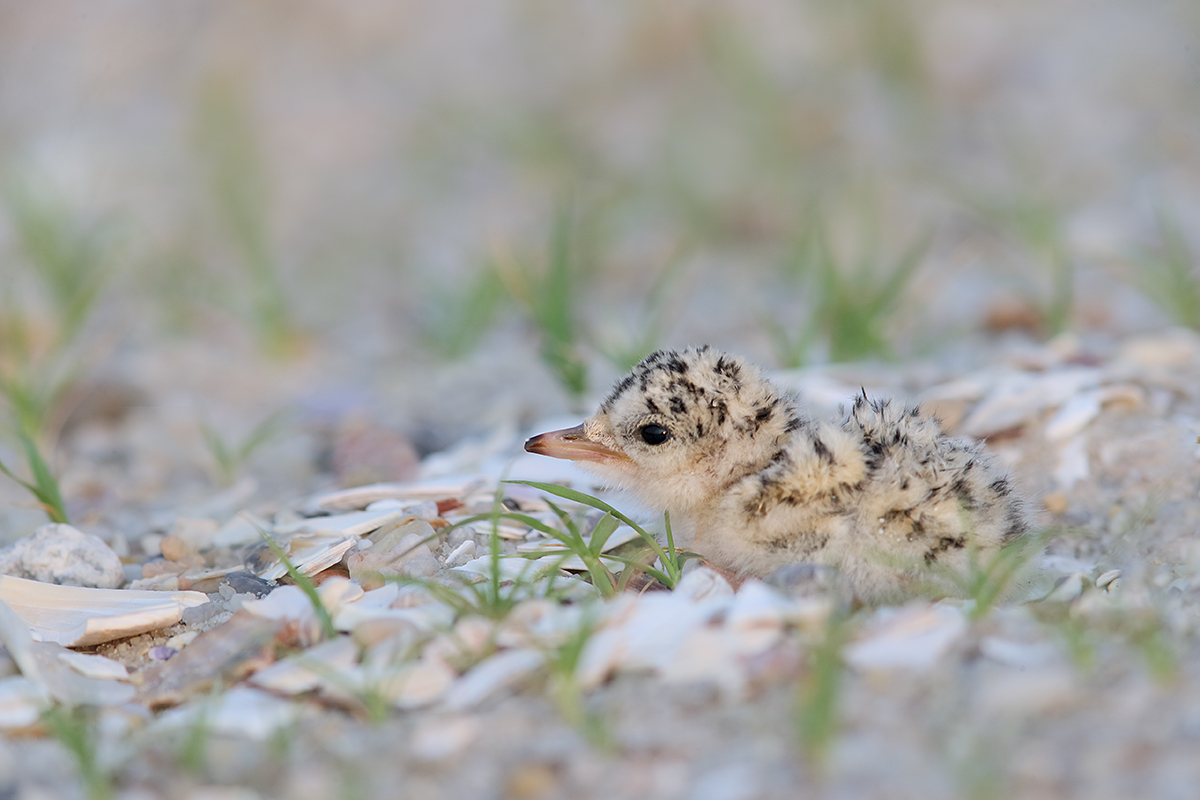
|
|
This blonde Least Tern chick was less than 3 days old when I photographed it on the early morning of July 21 again while I sat behind the Gitzo 3532 LS carbon fiber tripod, the Mongoose M3.6 head, the Canon EF 600mm f/4L IS II USM lens, the Canon Extender EF 2X III, and the Canon EOS-1D X. ISO 400. Evaluative metering +2/3 stop: 1/125 sec. at f/9 in Av mode. AWB.
Central Sensor (by necessity)/AI Servo-Expand/Rear Focus AF the chick’s eye and re-compose. Again, when you add the 2X TC to an f/4 lens with the 1DX or the 5D III hit the MFn button once to toggle to AF Expand and enjoy 4 extra AF sensors. Learn everything there is to know about the 1D X and 5D III AF systems including how to manage the various AF Area Selection Modes, when to use which one, and several ways to move the AF sensor around in the 1D X AF Guide and the 5D Mark III User’s Guide. Click here to see the latest version of the Rear Focus Tutorial. Click on the image to see a larger version. .
Image #2: Newly-hatched Least Tern chick in scrape
|
Before and After Blonde
The tiny blonde chick in Image #2 hatched from the egg seen in Image #1 two mornings after the IPT ended. Note that I almost always stop down at least 1/3 stop from wide open (f/8) when working with an f/4 lens and a 2X TC.
The Only Negative?
What was my only wish for Image #2?
|

|
|
For me, the coolest thing about learning to identify shorebirds is that once you learn the basics it is actually easier to age a shorebird, that is, to tell if it an adult or a juvenile, than it is to identify it as to species. And with a bit of experience, study, and practice, identifying the common North American migrant shorebirds is nowhere as difficult as it is reputed to be. Advice: get yourself a copy of my Shorebirds: Beautiful Beachcombers, study, and get out to local ponds, estuaries, beaches, and mudflats as much as possible for the next month. Mid-August through early September is the best time of year to see both adult and fresh juvenile shorebirds together on migration. Better yet, join me at JBWR for two great mornings of shorebird photography while honing your identification and ageing skills and learning a ton about my favorite bird family. See below for details.
For the correct ageing and ID of each of the birds in the composite above, see the comments here.
|
JBWR Short-Notice Shorebird Photography and ID In-the-Field Morning Workshop Sessions
Saturday August 23 and Sunday August 24: sunrise till 10am followed by brunch and image review at a local diner: $299/morning session. $549 for both days. Limit 6.
Join me at Jamaica Bay Wildlife Refuge in Queens, NY for a morning or two of shorebird photography in the mud. You will learn to age and identify the common shorebirds that we will encounter. You will learn the best times, tides, and locations to visit for the very best shorebird photography on the east coast and why only a very few days each year offer the best chances for success. I will teach you how to get close; we will either be sitting in or lying on the hard mud. These two morning sessions offer you a chance to learn from someone who has spent more time studying and photographing the shorebirds of JBWR than anyone alive. Join me and you are invited to pick my brain; as is usual, I share everything that I know. For those who are coming from out of town who would like to photograph on either Saturday or Sunday afternoon I will be glad to offer location guidance and options. Some folks may wish to join me for a JBWR/Nickerson Beach double header. See below for Nickerson Beach details.
Payment in full is due when you register and is non-refundable. Call me on weekends or Jim or Jen weekdays at 863-692-0906 with a credit card in hand to register. Please print, complete, and sign the form that is linked to here and shoot us a scanned copy via e-mail or a hard copy via snail mail to BIRDS AS ART, PO Box 7245, Indian Lake Estates, FL 33855.
Nickerson Beach Short-notice Weekday Beach-nesting Birds IPT: 2-Full Days/August 25-26, 2014: $749*. Leader: Arthur Morris
Join me on Long Island, NY soon to photograph Black Skimmers with chicks and young of all sizes, adult and juvenile Common Terns, and American Oystercatchers with grown young. The skimmers will be the stars of the show. Mid- to late August is prime time for photographing young skimmers. Chances are great to witness Great Black-backed Gull predation. The will also be chances to photograph a variety of shorebird species including large flocks of southbound migrant Sanderlings. Car-pooling is recommended; if we opt to return to the beach before 5pm there is a $30/vehicle parking fee that is not included so it is best to share that expense. Parking in the morning is free.
Call me on weekends or Jim or Jen weekdays at 863-692-0906 with a credit card in hand to register and leave a non-refundable $200 deposit. We will hold your spot pending the arrival of a check for your $549 balance. Checks should be made out to “Arthur Morris” and mailed to us at BIRDS AS ART, PO Box 7245, Indian Lake Estates, FL 33855. Please print, complete, and sign the form that is linked to here and shoot us a scanned copy via email or a hard copy via snail mail to the PO Box above.
* Folks who sign up for one or both JBWR morning sessions may apply a $50 discount to their Nickerson Beach fee bringing that cost down to $699.
If you have any questions please feel free to contact me via e-mail or by phone this weekend at 863-692-0906. Some may wish to combine this workshop with one or both of my JBWR morning In-the-Field sessions above or with Denise’s Nickerson Beach weekend workshop below.
|
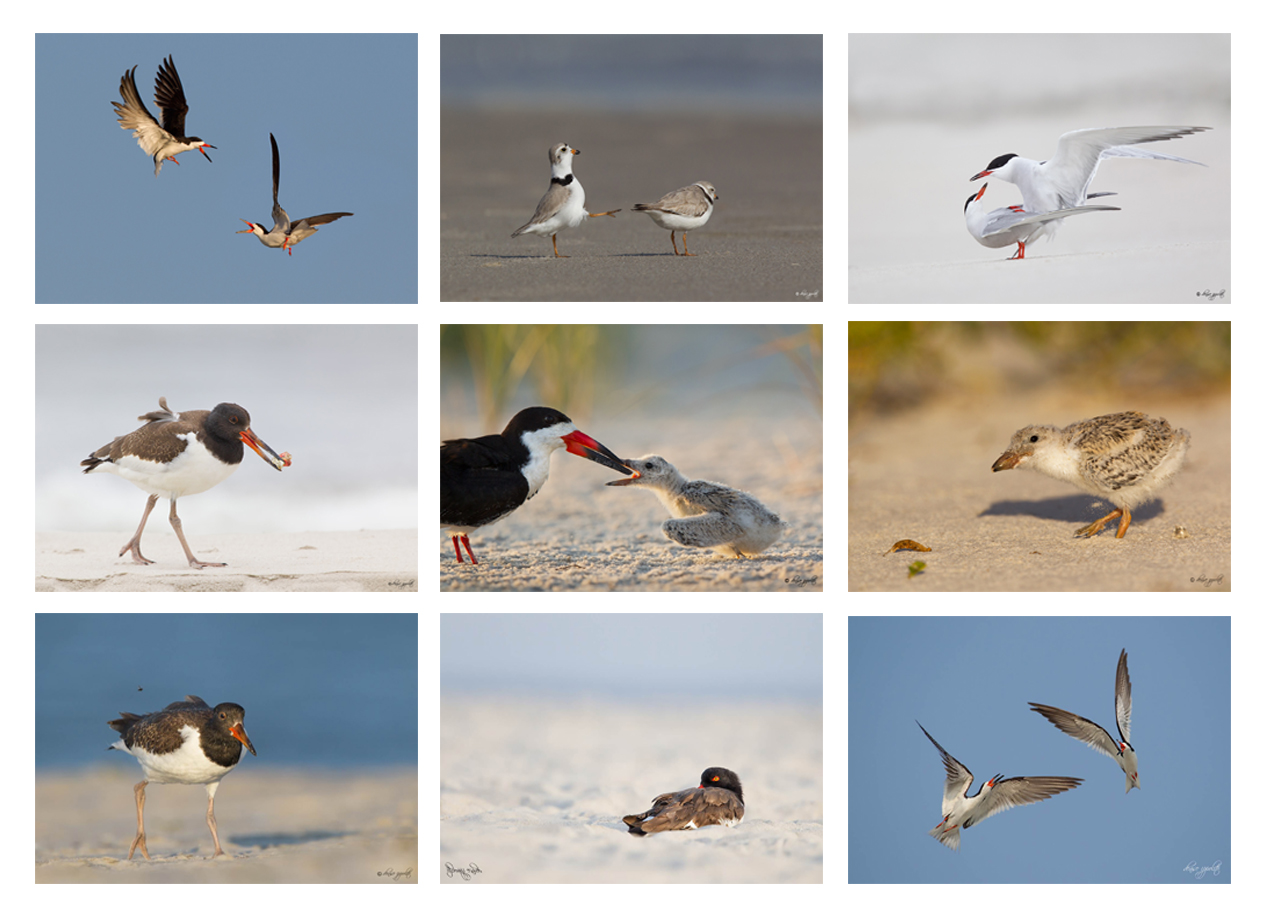
|
|
Images and card design by Denise Ippolito/A Creative Adventure
|
Denise Ippolito Nickerson Beach Workshop ~ Saturday & Sunday August 23-24th, $699.00 includes 4 photo sessions and 2 Image Review/ Photoshop sessions.
One great leader! Please let Denise know that you learned of this workshop through BIRDS AS ART. Click here and scroll down to register.
From Denise
There is just too much going on at Nickerson to stay away. I have decided to do a 2-day workshop at Nickerson Beach this August. By then lots of the Black Skimmer chicks will be hatched and there should also be plenty of action! The skimmers are lots of fun to photograph in flight, especially when they battle. We should also have good opportunities to photograph American Oystercatcher, Common Tern and maybe even some Least Terns and Piping Plovers. I will do my very best to get the group in position to capture great images. I will share with you my flight techniques and my techniques on getting you close to your subject. I will help you to recognize good situations and become a better bird photographer. This workshop needs 6 participants.
Saturday Schedule: 5:45am- 9:45am morning photography session, Lunch Break – Photoshop/Image Review, Gear and Camera settings session, Afternoon Break, 4:30pm- 7:30pm afternoon photography session.
Sunday Schedule: 5:45am- 9:45am morning photography session, Lunch Break- Photoshop/Image Review, Afternoon Break, 4:30pm- 7:30pm afternoon photography session.
We will photograph in the morning on Saturday, then break for an early lunch (included in the price). During lunch we will do image review and Photoshop lessons. After lunch I will go over gear handling tips and camera settings with the group. Then we will take an afternoon rest. This will give you time to download your images and have some time to yourself before we head back out in the late afternoon/early evening. Sunday we will wake up and have basically the same schedule as Saturday. This schedule is subject to change depending on conditions and wildlife. 🙂
Gear Suggestions:
I recommend that you bring your longest lens. If that is a 70-200mm lens than you will need a teleconvertor. You should have at the very least 400mm of focal length. A sturdy tripod- preferably w/o a center column. A complete list of gear recommendations as well as hotel recommendations and general information sheet will be provided at sign up.
Please contact Denise via e-mail with any questions.
Today’s Featured Lens: Used Canon EF 600mm f/4L IS USM Lens, the “old six”
An Amazing Package for Someone Young and Strong. Or Old and Strong.
Chuck Pettis is offering a Canon EF 600mm f/4L IS USM lens for $6199 with an amazing package of extras, extras that I used and depend on. The lens is in excellent condition used only a dozen times. The sale includes the Lens Trunk (one latch on the case was damaged by the TSA on a trip to Bosque but the latch still functions fine), the leather lens hood, and the rear cap. Amazingly Chuck is also including more than $300 in extras: a Canon 52mm Drop-in Circular Polarizing Filter PL-C, also in excellent condition and an extra Canon 52mm Drop-in Filter Holder in excellent condition. I put a 3-stop ND in my extra filter draw for creating blurs on sunny days.
The seller will also pay insured UPS shipping within the continental US.
Interested folks can contact Chuck via e-mail or try him at 360-331-6667 or on his cell at 206-930-2623.
The old six was my workhorse super-telephoto for too many years….
Used Photography Gear for Sale
Though we have sold a boatload of great gear recently, there are still some great buys available. Click here to see the complete listings. Below is today’s featured item.
Facebook
Be sure to like and follow BAA on Facebook by clicking on the logo link upper right. Tanks a stack!
Support the BAA Blog. Support the BAA Bulletins: Shop B&H here!
We want and need to keep providing you with the latest free information, photography and Photoshop lessons, and all manner of related information. Show your appreciation by making your purchases immediately after clicking on any of our B&H or Amazon Affiliate links in this blog post. Remember, B&H ain’t just photography!
…..
Amazon Canada
Many kind folks from north of the border, ay, have e-mailed stating that they would love to help us out by using one of our affiliate links but that living in Canada and doing so presents numerous problems. Now, they can help us out by using our Amazon Canada affiliate link by starting their searches by clicking here. Many thanks to those who have written.
Typos
In all blog posts and Bulletins, feel free to e-mail or to leave a comment regarding any typos, wrong words, misspellings, omissions, or grammatical errors. Just be right. 🙂
August 10th, 2014 The Streak Continues: 253
This post was published just before 8:15am from my home at Indian Lake Estates, FL. Yesterday was a very relaxing one followed by another good night’s sleep. This post, which took me more than 5 hours to prepare due to an almost endless variety of snafus, marks 253 consecutive days with a new enjoyable and educational blog post.
With so many folks getting in the habit of using our B&H links and our Amazon logo-links, why quit now? April, May, and June were fantastic. July was good. Lots of folks are getting the message: using my affiliate links does not cost you a penny and helps support my efforts here. To show your appreciation, I do ask that you use our B&H and Amazon affiliate links on the right side of the blog for all of your purchases. Please check the availability of all photographic accessories in the BIRDS AS ART Online Store, especially Gitzo tripods, Wimberley tripod heads, and the like. We sell only what I have used and tested, and know that you can depend on. We will not sell you junk. We know the tools that you need to make creating great images easy and fun. And we are always glad to answer your gear questions via e-mail.
You can find the following items in the store: Gitzo tripods, Mongoose M3.6 and Wimberley heads, plates, low feet, and accessories, flash brackets, , Delkin e-film Pro Compact Flash Cards, LensCoat products, and our unique line-up of educational materials including ABP I & II, Digital Basics, Site and Set-up e-Guides, Canon and Nikon Camera Users and AF e-Guides, and MP-4 Photoshop video tutorials among others.
I would of course appreciate your using our B&H affiliate links for all of your major gear, video, and electronic purchases. For the photographic stuff mentioned in the paragraph above we, meaning BAA, would of course greatly appreciate your business. Here is a huge thank you to the many who have been using our links on a regular basis and visiting the BAA Online store as well.
JBWR & Nickerson Beach Short-Notice Workshop Opportunities
For information on mid-August Jamaica Bay Wildlife Refuge In-the Field Morning Sessions and the 2-DAY Nickerson Beach IPT click here and scroll down.
|
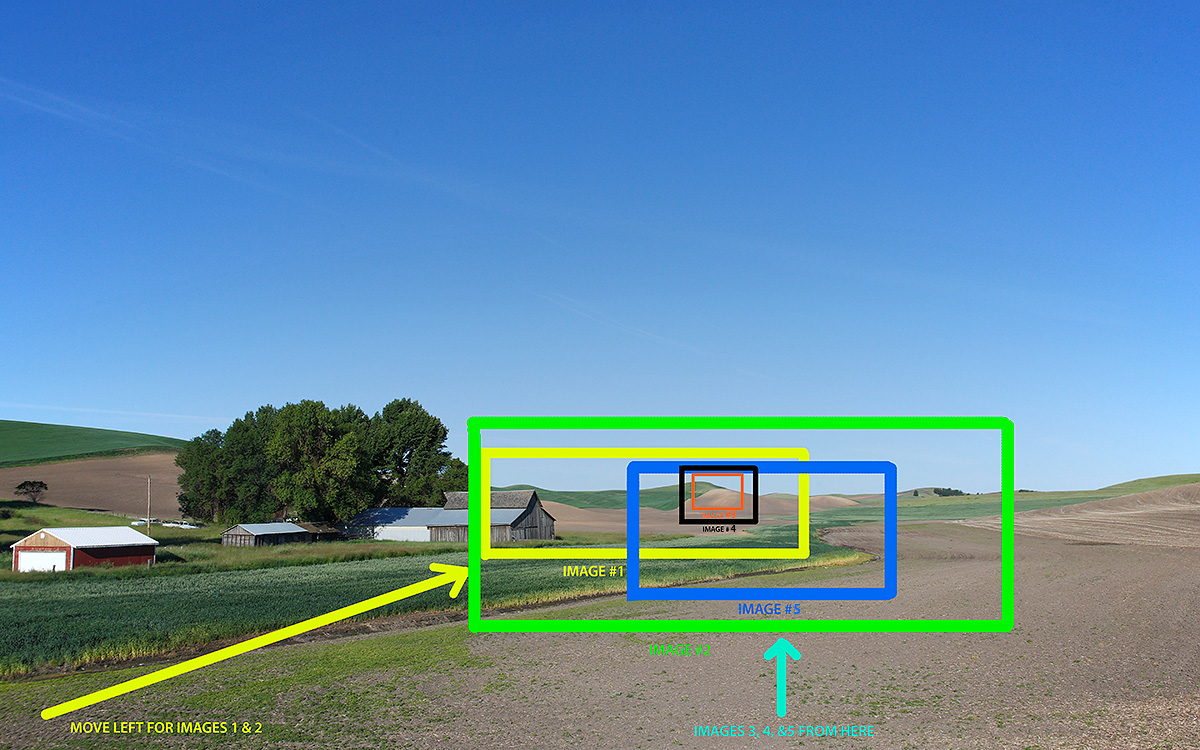
|
|
This diagram maps out the five images that caught my eye on that fine morning. Note that I used the tall hill in the center as a major compositional element in each image that I created. The lovely curved line that separated the green vegetation from the adjacent plowed field was quite sensuous. Read on for the details.
Click on the image to enlarge.
|
Learning to Think and See Like a Pro/The Fourth of a Series
In the Learning to Think and See Like a Pro/The Fourth of a Series blog post here, I wrote with in reference to the then-unadorned image above:
Here is the challenge: click on the image above to enlarge it. Examine it carefully. You have access to all focal lengths from 70mm to 784mm in the form of a 70-200 II and a 200-400 with Internal TC along with an external 1.4X III. The latter covers from 200-784mm in its various configurations. What catches your eye? What images would you extract from the scene? Please leave a comment and please be specific. I will share several of the images that I created that morning with you in this coming Saturday’s blog post. Suggestions for creating pleasing blurs are of course welcome.
Lots of folks left thoughtful comments that hit upon many of the interesting features in the scene. Below I share my four favorite images from that situation along with a digital creation of Image #4. .
Image #1 (framed in yellow) Questions
This was the first image that I made.
1-Why did I move so far to the left?
2-Why did I raise my tripod as high as possible?
3-What is the greatest strength of this composition?
Clue: the answer to all three questions is the same….
|
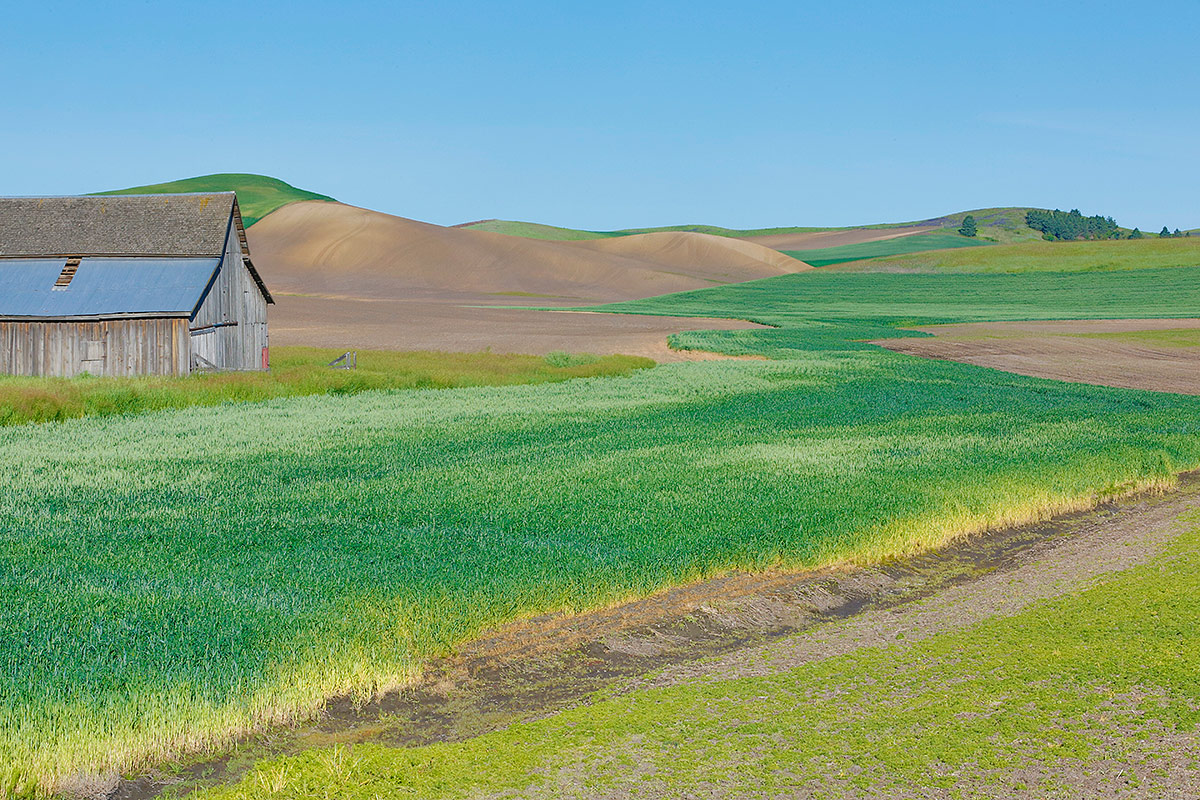
|
|
This three-frame Art Vivid HDR image was created on last June’s Palouse scouting trip with the Gitzo 3532 LS carbon fiber tripod, the Mongoose M3.6 head, the Canon EF 70-200mm f/2.8L IS II USM lens (at 95mm) and the Canon EOS 5D Mark III . ISO 400. Evaluative metering +1 stop +/- two stops around the base exposure of 1/40 sec. at f/32 in Av mode. Color temperature 4500K. Live View and 2-second timer.
Central Sensor/Surround/AI Servo-Rear Focus AF on the nearest corner of the blue roof and re-compose. Click here to see the latest version of the Rear Focus Tutorial. Click on the image to see a larger version.
Image #2
|
Image #2 (framed in lime green) Questions
1-Why is Image #1 much stronger than Image #2?
2-Did I move my tripod at all after I created Image #1?
3-How do you know?
Image #3 (framed in orange)
The sensuous curve in this, the tightest framing, caught my eye more than any single element in the wide scene. That is why I opted to include it in every image.
Image #4 (framed in black)
Image #3 is the tight view. Image #4 is a wider view. Image #3 offers the greatest detail in both the green vegetation and the plowed dirt field. Image #4 features much of the same plus a thin green strip in the lower right. Which of these two images do you like best? Why?
|
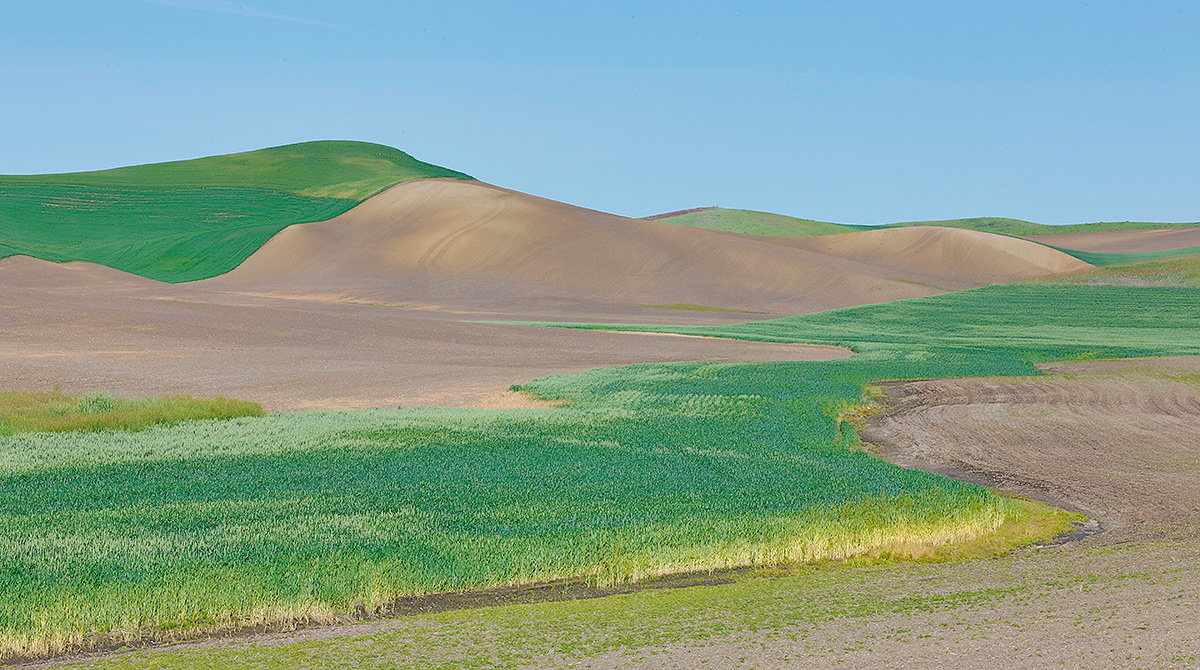
|
|
This three-frame Art Vivid HDR image was created on last June’s Palouse scouting trip with the Gitzo 3532 LS carbon fiber tripod, the Mongoose M3.6 head, the Canon EF 70-200mm f/2.8L IS II USM lens (at 125mm) and the Canon EOS 5D Mark III . ISO 400. Evaluative metering +1 2/3 stops +/- two stops around the base exposure of 1/60 sec. at f/22 in Av mode. Color temperature 4500K. Live View and 2-second timer.
Central Sensor/Surround/AI Servo-Rear Focus AF on the apex of the green curve on the lower right and re-compose. Click here to see the latest version of the Rear Focus Tutorial. Click on the image to see a larger version.
Image #5
|
Image #5 (framed in blue)
This image was cropped from below to a pano. Note the inclusion of the complete curve of green vegetation that was missing in Image #2.
HDR Art Vivid Question
Why were all of the HDR Art Vivid images presented here created at Color Temperature 4500K?
|
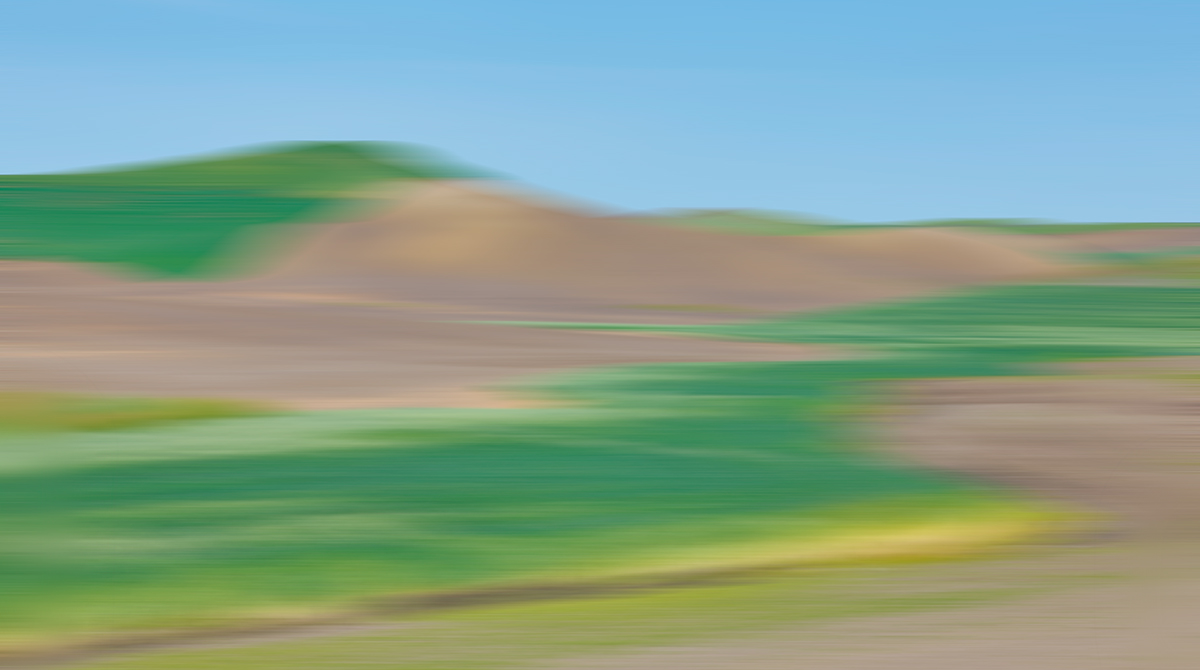
|
Image #6 was created from Image #5 (immediately above) in Photoshop CS-6. Keep reading to learn how.
|
Image #6
Image #6 was Created in Photoshop from Image #5 using Filter/Blur/Motion Blur and then adjusting the Distance slider to about 75. Though I created more than a dozen pleasing blurs of the area in Image 5, the Photoshop-created version was my favorite by far.
Your Favorite?
Take a moment to leave a comment and let us know which of the six images here is your favorite and why.
Used Photography Gear for Sale
Though we have sold a boatload of great gear recently, there are still some great buys available. Click here to see the complete listings. Below is today’s featured item.
|
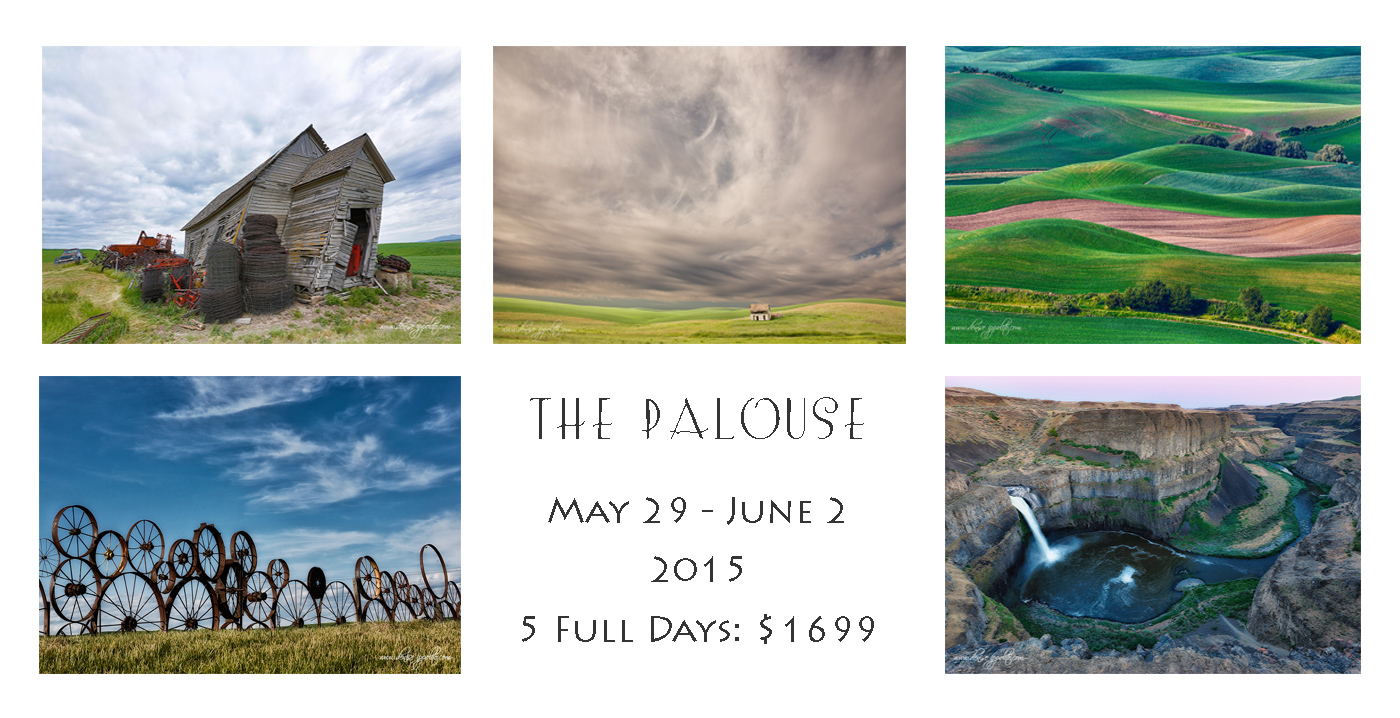
|
|
Card and design by Denise Ippolito. Scroll down here to see lots more of Denise’s Palouse images. Note that the dates on Denise’s card are for the first Palouse IPT that is sold out with a long waiting list. The dates for the 2nd IPT are June 5-9, 2015. See below for complete details.
|
The Palouse A Creative Adventure/BIRDS AS ART Instructional Photo-Tour (IPT)/Eastern Washington State. May 29-June 2, 2015/5 Full Days: $1699/Limit 12 photographers/Sold Out with a long waiting list
As the trip above sold out quickly and now has a long waiting list we scheduled a second trip after giving ourselves 2 days to recover from the first one. We have already sold eight slots for the 2nd Palouse trip so please do not tarry if you wish to join us. There will not be a third trip. 🙂 See the details below.
|
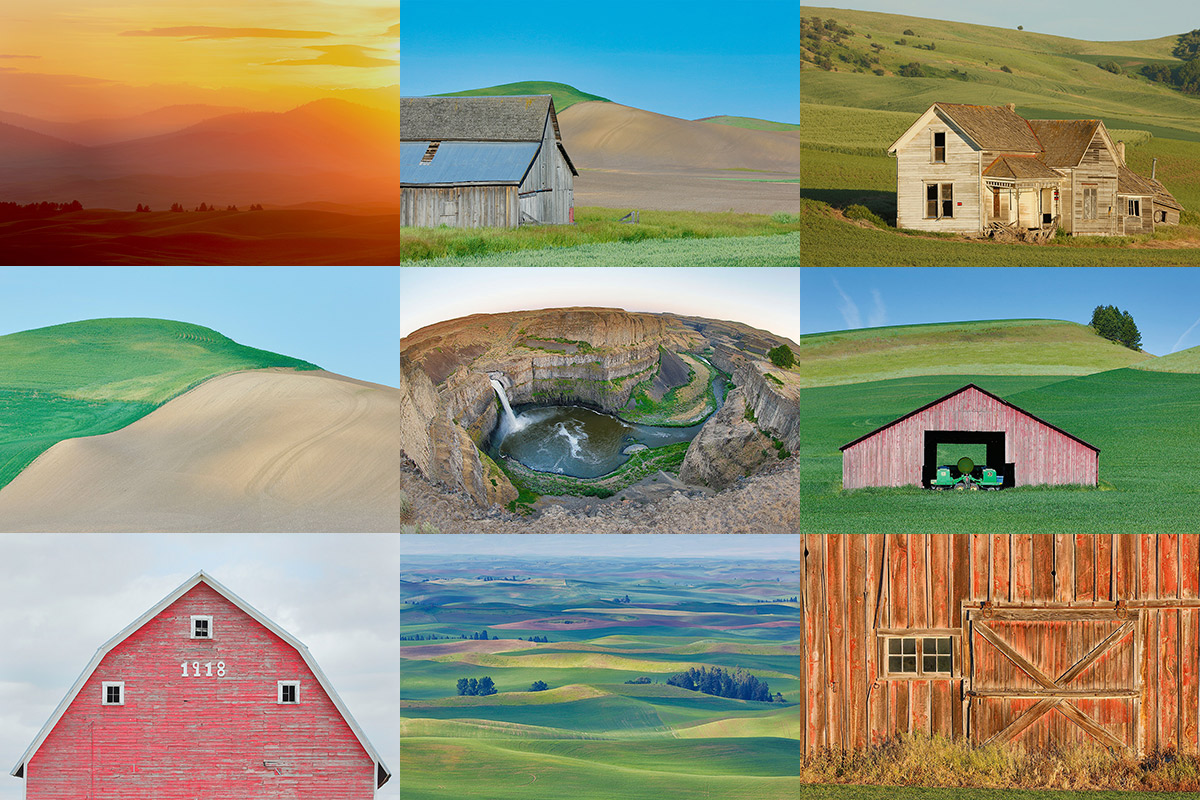
|
|
Please note that there are two Palouse IPTs in place; the first has been sold out with a waiting list for some time. We hope that you can join us for IPT #2: Card and design by Arthur Morris/BIRDS AS ART.
|
The Palouse A Creative Adventure/BIRDS AS ART Instructional Photo-Tour (IPT #2)/Eastern Washington State. June 5-9, 2015/5 Full Days: $1699/Limit 12 photographers/Openings 4; this trip is a go.
Rolling farmlands provide a magical patchwork of textures and colors, especially when viewed from the top of Steptoe Butte where we will likely enjoy spectacular sunrises and possibly a nice sunset or two. We will photograph grand landscapes and mini-scenics of the rolling hills and farm fields. We will take you to some really neat old abandoned barns and farmhouses in idyllic settings. There is no better way to improve your compositional and image design skills and to develop your creativity than to join us for this trip. Two great leaders: Denise Ippolito and Arthur Morris. Photoshop and image sharing sessions when we have the time and energy…. We get up early and stay out late and the days are long.
After 6 days of back-breaking scouting work in early June 2014 we found all of the iconic locations and, in addition, lots of spectacular new old barns and breath-taking landforms and views. We will teach you what makes one situation prime and another seemingly similar one a waste of your time.
What’s included: In-the-field instruction, guidance, lessons, and inspiration, our newfound but very extensive knowledge of the area, all lunches, motel lobby breakfasts, and Photoshop and image sharing sessions when possible.
You will learn and hone both basic and advanced compositional and image design skills. You will learn to get the right exposure every time. You will learn to develop your creative eye. You will learn the basics of HDR (high dynamic range) photography. You will learn a variety of in-camera creative techniques; Canon 5D Mark III bodies are a plus. And most importantly you will learn to see the situation and to create a variety of top-notch images. Do see both of our blogs for lots more on that in the coming weeks. You will learn how the quality and direction of light combine to determine the success of your images. And–please don’t gasp–we will be working quite a bit with sidelight when creating landscapes. Lastly, we will be touching on infrared photography.
A non-refundable $699 deposit is due now. The balance will be due on January 29, 2015. With the unpredictable nature of the photography business, I have not said this often lately, but it seems quite likely that this one will fill up very quickly. Please let me know via e-mail that you will be joining us. Then you can either call Jim or Jennifer at 863-692-0906 during business hours or send us a check; the latter is preferred.
Please send your deposit check made out to “Arthur Morris” to us at Arthur Morris/BIRDS AS ART, PO Box 7245, Indian Lake Estates, FL, 33855. If you have any questions, please feel free to contact me via e-mail. You can also contact denise via e-mail here
Facebook
Be sure to like and follow BAA on Facebook by clicking on the logo link upper right. Tanks a stack!
Support the BAA Blog. Support the BAA Bulletins: Shop B&H here!
We want and need to keep providing you with the latest free information, photography and Photoshop lessons, and all manner of related information. Show your appreciation by making your purchases immediately after clicking on any of our B&H or Amazon Affiliate links in this blog post. Remember, B&H ain’t just photography!
…..
Amazon Canada
Many kind folks from north of the border, ay, have e-mailed stating that they would love to help us out by using one of our affiliate links but that living in Canada and doing so presents numerous problems. Now, they can help us out by using our Amazon Canada affiliate link by starting their searches by clicking here. Many thanks to those who have written.
Typos
In all blog posts and Bulletins, feel free to e-mail or to leave a comment regarding any typos, wrong words, misspellings, omissions, or grammatical errors. Just be right. 🙂
August 9th, 2014 The Streak Continues: 252
This post was published just after 8:30am from my home at Indian Lake Estates, FL. Yesterday I enjoyed another great swim, an ice bath, a productive but relaxing day of work, and another good night’s sleep. The mornings have been clear, still, hot and sunny. The afternoons have been partly cloudy. And just after dinner there has been an absolute deluge every day. This post, which took me more than 4 1/2 hours to prepare, marks 252 consecutive days with a new enjoyable and educational blog post.
With so many folks getting in the habit of using our B&H links and our Amazon logo-links, why quit now? April, May, and June were fantastic. July was good. Lots of folks are getting the message: using my affiliate links does not cost you a penny and helps support my efforts here. To show your appreciation, I do ask that you use our B&H and Amazon affiliate links on the right side of the blog for all of your purchases. Please check the availability of all photographic accessories in the BIRDS AS ART Online Store, especially Gitzo tripods, Wimberley tripod heads, and the like. We sell only what I have used and tested, and know that you can depend on. We will not sell you junk. We know the tools that you need to make creating great images easy and fun. And we are always glad to answer your gear questions via e-mail.
You can find the following items in the store: Gitzo tripods, Mongoose M3.6 and Wimberley heads, plates, low feet, and accessories, flash brackets, , Delkin e-film Pro Compact Flash Cards, LensCoat products, and our unique line-up of educational materials including ABP I & II, Digital Basics, Site and Set-up e-Guides, Canon and Nikon Camera Users and AF e-Guides, and MP-4 Photoshop video tutorials among others.
I would of course appreciate your using our B&H affiliate links for all of your major gear, video, and electronic purchases. For the photographic stuff mentioned in the paragraph above we, meaning BAA, would of course greatly appreciate your business. Here is a huge thank you to the many who have been using our links on a regular basis and visiting the BAA Online store as well.
“Learning to Think and See Like a Pro/The Fourth of a Series” Images
The images from the fourth Learning to Think and See Like a Pro blog post that were promised for today will be featured in tomorrow’s blog post. Lots of folks have posted some great ideas by leaving well thought out comments. As you now have another day it is not too late to take a crack at it.
|
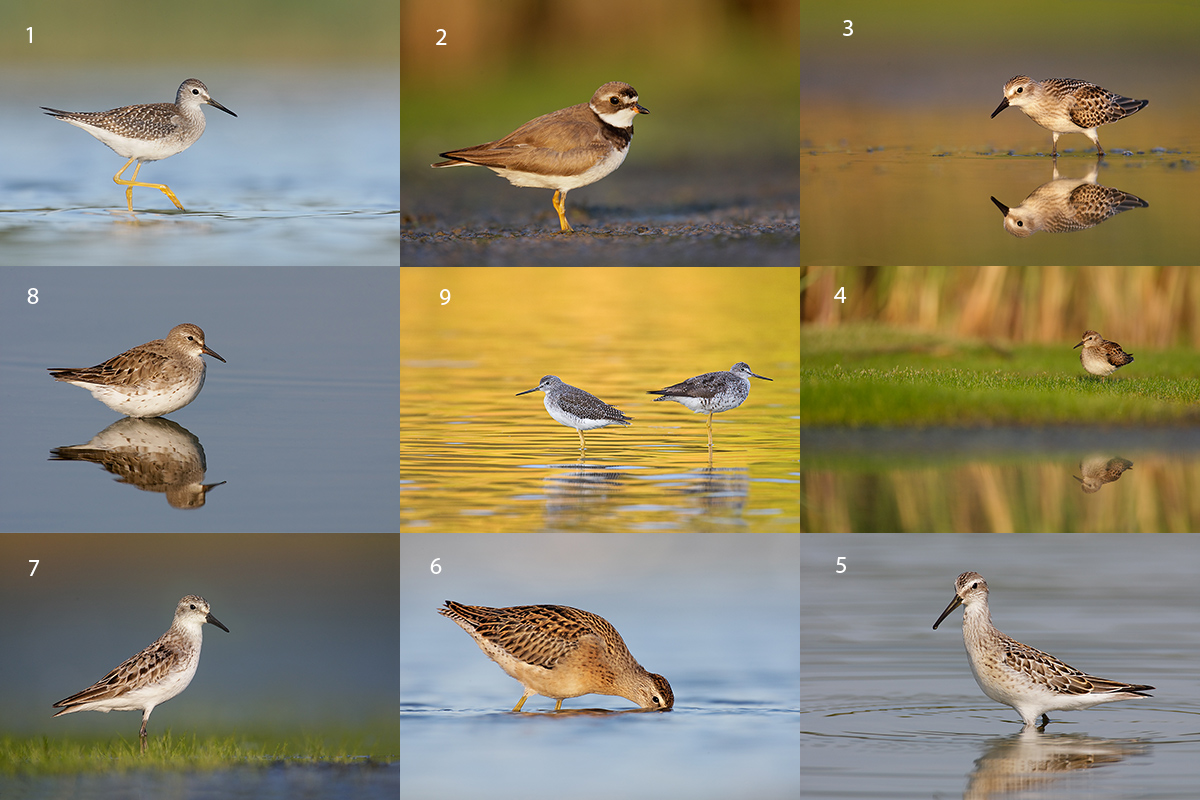
|
|
All of the shorebirds on this composite card were photographed at Jamaica Bay Wildlife Refuge (JBWR) in late summer. Amazingly, “fall” (southbound) migration for arctic and sub-arctic breeding shorebirds begins every year in late June when the first Least Sandpipers and Short-billed Dowitchers, birds that did not breed, stop in New York City on their way south to their wintering grounds. You can learn the whole story, as well as the basics of identifying and ageing North American shorebirds in my Shorebirds: Beautiful Beachcombers (softcover: 160 pages with 96 full color photographs).
See the Shorebird ID quiz below and be sure to click on the image to view a larger size.
|
Shorebirds
For me, the coolest thing about learning to identify shorebirds is that once you learn the basics it is actually easier to age a shorebird, that is, to tell if it an adult or a juvenile, than it is to identify it as to species. And with a bit of experience, study, and practice, identifying the common North American migrant shorebirds is nowhere as difficult as it is reputed to be. Advice: get yourself a copy of my Shorebirds: Beautiful Beachcombers, study, and get out to local ponds, estuaries, beaches, and mudflats as much as possible for the next month. Mid-August through early September is the best time of year to see both adult and fresh juvenile shorebirds together on migration. Better yet, join me at JBWR for two great mornings of shorebird photography while honing your identification and ageing skills and learning a ton about my favorite bird family. See below for details.
Shorebird ID Quiz
After much thought I have decided to make things easy for y’all: we will do this as a matching exercise. You are invited to leave a comment by listing the numerals 1-9, each on its own line, and then cutting and pasting the name and age of the shorebird depicted in each image from this list:
Juvenile Least Sandpiper
Adult and juvenile Greater Yellowlegs
Stilt Sandpiper in juvenal plumage
Adult Semipalmated Sandpiper
Adult Semipalmated Plover
Juvenile Lesser Yellowlegs
Short-billed Dowitcher in fresh juvenal plumage
Worn, fading adult White-rumped Sandpiper
Fresh juvenile Semipalmated Sandpiper
Below I illustrate the proper format by giving you a head start with one correct answer:
1-
2-
3-
4-
5-
6-
7-
8-
9-Adult and juvenile Greater Yellowlegs
You may of course consult a good field guide or reference book. Good luck!
|
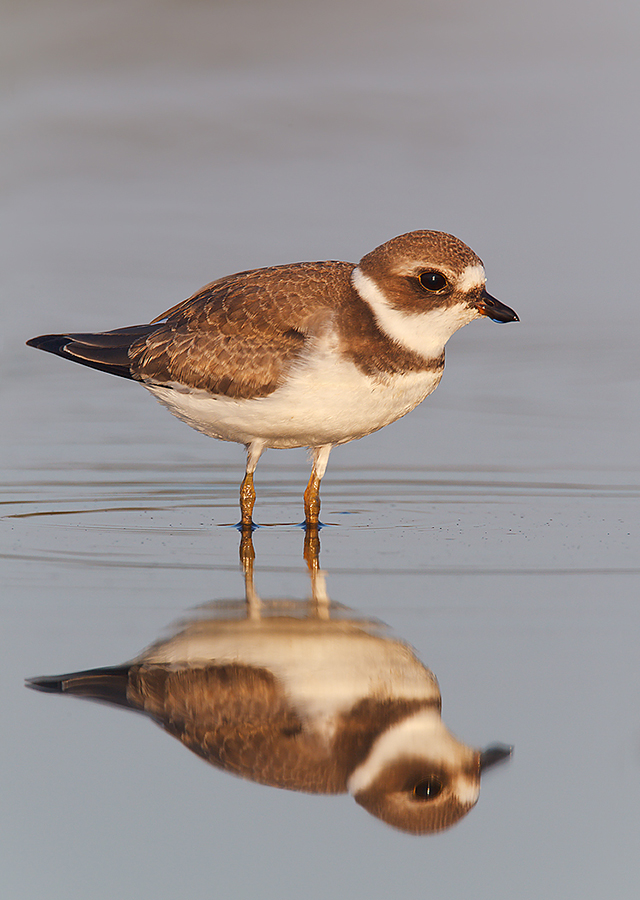
|
|
This juvenile Semipalmated Plover image was created on August 20, 2010. Note the whitish fringes on each feather of the bird’s upperparts and crown that give the bird the scalloped look sported by many young shorebirds. I used the the Gitzo 3530LS tripod now replaced by the Gitzo 3532 LS carbon fiber tripod, the Mongoose M3.6 head, the Canon EF 800mm f/5.6L IS USM lens, the Canon Extender EF 1.4X III, and the EOS-1D Mark IV (now replaced by the Canon EOS-1D X. ISO 400. Evaluative metering +1 1/3 stops as framed: 1/320 sec. at f/11in Manual Av mode. AWB.
Central Sensor (by necessity)/AI Servo-Expand/Rear Focus on the bird’s eye and re-compose. Today, when you add a 2X TC to an f/4 lens with the 1DX or the 5D III, hit the MFn button once to toggle to AF Expand and enjoy 4 extra AF sensors. Learn everything there is to know about the 1D X and 5D III AF systems including how to manage the various AF Area Selection Modes, when to use which one, and several ways to move the AF sensor around in the 1D X AF Guide and the 5D Mark III User’s Guide. Click here to see the latest version of the Rear Focus Tutorial. Click on the image to see a larger version.
|
JBWR Short-Notice Shorebird Photography and ID In-the-Field Morning Workshop Sessions
Saturday August 23 and Sunday August 24: sunrise till 10am followed by brunch and image review at a local diner: $299/morning session. $549 for both days. Limit 6.
Join me at Jamaica Bay Wildlife Refuge in Queens, NY for a morning or two of shorebird photography in the mud. You will learn to age and identify the common shorebirds that we will encounter. You will learn the best times, tides, and locations to visit for the very best shorebird photography on the east coast and why only a very few days each year offer the best chances for success. I will teach you how to get close; we will either be sitting in or lying on the hard mud. These two morning sessions offer you a chance to learn from someone who has spent more time studying and photographing the shorebirds of JBWR than anyone alive. Join me and you are invited to pick my brain; as is usual, I share everything that I know. For those who are coming from out of town who would like to photograph on either Saturday or Sunday afternoon I will be glad to offer location guidance and options. Some folks may wish to join me for a JBWR/Nickerson Beach double header. See below for Nickerson Beach details.
Payment in full is due when you register and is non-refundable. Call me on weekends or Jim or Jen weekdays at 863-692-0906 with a credit card in hand to register. Please print, complete, and sign the form that is linked to here and shoot us a scanned copy via e-mail or a hard copy via snail mail to BIRDS AS ART, PO Box 7245, Indian Lake Estates, FL 33855.
Nickerson Beach Short-notice Weekday Beach-nesting Birds IPT: 2-Full Days/August 25-26, 2014: $749*. Leader: Arthur Morris
Join me on Long Island, NY soon to photograph Black Skimmers with chicks and young of all sizes, adult and juvenile Common Terns, and American Oystercatchers with grown young. The skimmers will be the stars of the show. Mid- to late August is prime time for photographing young skimmers. Chances are great to witness Great Black-backed Gull predation. The will also be chances to photograph a variety of shorebird species including large flocks of southbound migrant Sanderlings. Car-pooling is recommended; if we opt to return to the beach before 5pm there is a $30/vehicle parking fee that is not included so it is best to share that expense. Parking in the morning is free.
Call me on weekends or Jim or Jen weekdays at 863-692-0906 with a credit card in hand to register and leave a non-refundable $200 deposit. We will hold your spot pending the arrival of a check for your $549 balance. Checks should be made out to “Arthur Morris” and mailed to us at BIRDS AS ART, PO Box 7245, Indian Lake Estates, FL 33855. Please print, complete, and sign the form that is linked to here and shoot us a scanned copy via email or a hard copy via snail mail to the PO Box above.
* Folks who sign up for one or both JBWR morning sessions may apply a $50 discount to their Nickerson Beach fee bringing that cost down to $699.
If you have any questions please feel free to contact me via e-mail or by phone this weekend at 863-692-0906. Some may wish to combine this workshop with one or both of my JBWR morning In-the-Field sessions above or with Denise’s Nickerson Beach weekend workshop below.
|

|
|
Images and card design by Denise Ippolito/A Creative Adventure
|
Denise Ippolito Nickerson Beach Workshop ~ Saturday & Sunday August 23-24th, $699.00 includes 4 photo sessions and 2 Image Review/ Photoshop sessions.
One great leader! Please let Denise know that you learned of this workshop through BIRDS AS ART. Click here and scroll down to register.
From Denise
There is just too much going on at Nickerson to stay away. I have decided to do a 2-day workshop at Nickerson Beach this August. By then lots of the Black Skimmer chicks will be hatched and there should also be plenty of action! The skimmers are lots of fun to photograph in flight, especially when they battle. We should also have good opportunities to photograph American Oystercatcher, Common Tern and maybe even some Least Terns and Piping Plovers. I will do my very best to get the group in position to capture great images. I will share with you my flight techniques and my techniques on getting you close to your subject. I will help you to recognize good situations and become a better bird photographer. This workshop needs 6 participants.
Saturday Schedule: 5:45am- 9:45am morning photography session, Lunch Break – Photoshop/Image Review, Gear and Camera settings session, Afternoon Break, 4:30pm- 7:30pm afternoon photography session.
Sunday Schedule: 5:45am- 9:45am morning photography session, Lunch Break- Photoshop/Image Review, Afternoon Break, 4:30pm- 7:30pm afternoon photography session.
We will photograph in the morning on Saturday, then break for an early lunch (included in the price). During lunch we will do image review and Photoshop lessons. After lunch I will go over gear handling tips and camera settings with the group. Then we will take an afternoon rest. This will give you time to download your images and have some time to yourself before we head back out in the late afternoon/early evening. Sunday we will wake up and have basically the same schedule as Saturday. This schedule is subject to change depending on conditions and wildlife. 🙂
Gear Suggestions:
I recommend that you bring your longest lens. If that is a 70-200mm lens than you will need a teleconvertor. You should have at the very least 400mm of focal length. A sturdy tripod- preferably w/o a center column. A complete list of gear recommendations as well as hotel recommendations and general information sheet will be provided at sign up.
Please contact Denise via e-mail with any questions.
Today’s Featured Lens: Used Canon 800mm f/56L IS USM Lens
Multiple IPT veteran and good friend Mike Gotthelf, is offering a used Canon EF 800mm f/5.6L IS USM lens in excellent + condition for $8850. The lens is like new except for some very minor wear on the finish. The sale includes the leather hood, the original hard case and key, a low foot, a LensCoat, and insured shipping via UPS Ground to US addresses only. Personal checks only; your new lens will be shipped only after your check clears.
This great lens, my favorite for 3 years, sells new at B&H for $13,999.00. B&H is asking $11,399.95 for a used one here in the same condition as Mike’s. They recently dropped their price for this lens from $11,999.90…. Buy Mike’s lens and save $2456.95 right now! It will save you a ton of dough and you will have a super-sharp lens with lots of reach. And it works great with a 1.4X TC too with all pro bodies and with the 5D Mark III.
Interested folks can contact Mike via e-mail or by phone at (978)-407-0679 (eastern time).
Used Photography Gear for Sale
Though we have sold a boatload of great gear recently, there are still some great buys available. Click here to see the complete listings. Below is today’s featured item.
Facebook
Be sure to like and follow BAA on Facebook by clicking on the logo link upper right. Tanks a stack!
Support the BAA Blog. Support the BAA Bulletins: Shop B&H here!
We want and need to keep providing you with the latest free information, photography and Photoshop lessons, and all manner of related information. Show your appreciation by making your purchases immediately after clicking on any of our B&H or Amazon Affiliate links in this blog post. Remember, B&H ain’t just photography!
…..
Amazon Canada
Many kind folks from north of the border, ay, have e-mailed stating that they would love to help us out by using one of our affiliate links but that living in Canada and doing so presents numerous problems. Now, they can help us out by using our Amazon Canada affiliate link by starting their searches by clicking here. Many thanks to those who have written.
Typos
In all blog posts and Bulletins, feel free to e-mail or to leave a comment regarding any typos, wrong words, misspellings, omissions, or grammatical errors. Just be right. 🙂
August 8th, 2014 The Streak Continues: 251
This post was published just before 7:15am from my home at Indian Lake Estates, FL. Yesterday I enjoyed another great swim, an ice bath, a productive but relaxing day of work, and another good night’s sleep. This post, which took me about two hours to prepare, marks 251 consecutive days with a new enjoyable and educational blog post.
With so many folks getting in the habit of using our B&H links and our Amazon logo-links, why quit now? April, May, and June were fantastic. July was good. Lots of folks are getting the message: using my affiliate links does not cost you a penny and helps support my efforts here. To show your appreciation, I do ask that you use our B&H and Amazon affiliate links on the right side of the blog for all of your purchases. Please check the availability of all photographic accessories in the BIRDS AS ART Online Store, especially Gitzo tripods, Wimberley tripod heads, and the like. We sell only what I have used and tested, and know that you can depend on. We will not sell you junk. We know the tools that you need to make creating great images easy and fun. And we are always glad to answer your gear questions via e-mail.
You can find the following items in the store: Gitzo tripods, Mongoose M3.6 and Wimberley heads, plates, low feet, and accessories, flash brackets, , Delkin e-film Pro Compact Flash Cards, LensCoat products, and our unique line-up of educational materials including ABP I & II, Digital Basics, Site and Set-up e-Guides, Canon and Nikon Camera Users and AF e-Guides, and MP-4 Photoshop video tutorials among others.
I would of course appreciate your using our B&H affiliate links for all of your major gear, video, and electronic purchases. For the photographic stuff mentioned in the paragraph above we, meaning BAA, would of course greatly appreciate your business. Here is a huge thank you to the many who have been using our links on a regular basis and visiting the BAA Online store as well.
|
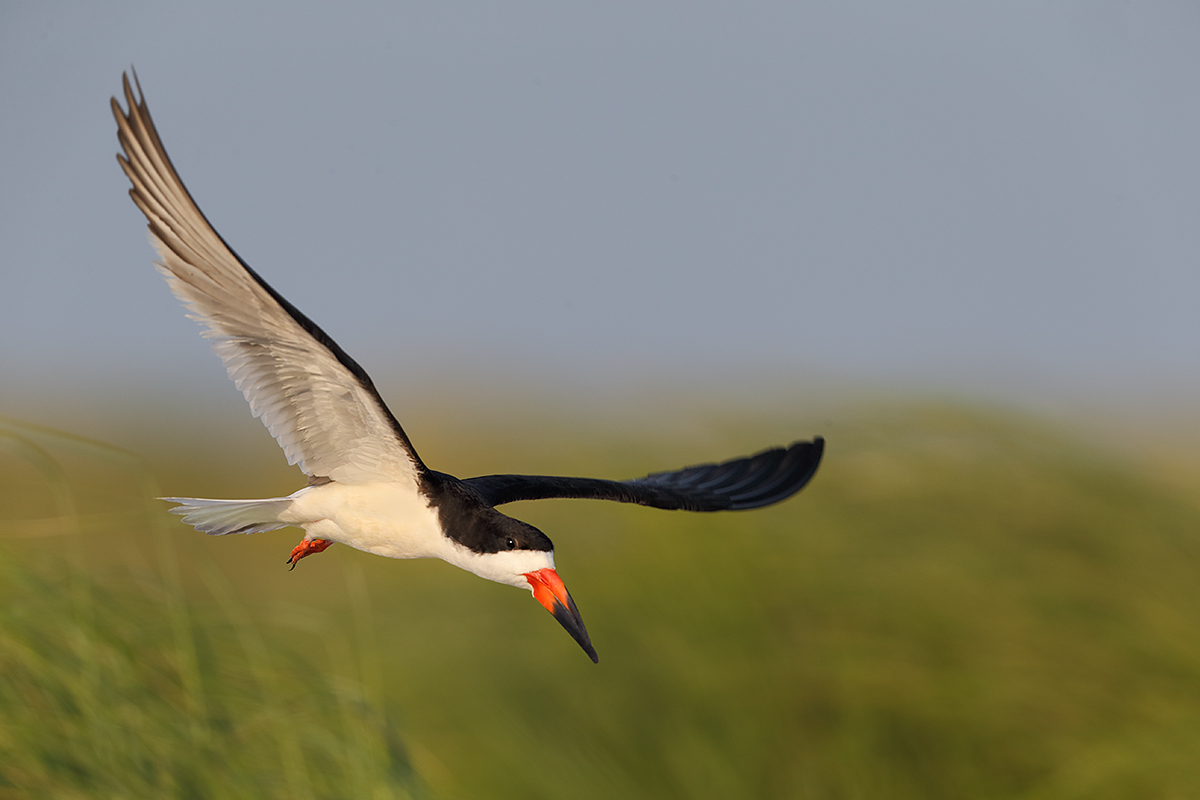
|
|
This image was created on the Nickerson Baby Beach Nesting Birds IPT. I used the Gitzo 3532 LS carbon fiber tripod, the Mongoose M3.6 head, the Canon EF 600mm f/4L IS II USM lens, the Canon 1.4x EF Extender III (Teleconverter), and the Canon EOS-1D X. ISO 400. Evaluative metering +1 stop off the light blue sky 30 degrees up from the horizon at 6:37pm on a sunny afternoon with a touch of haze: 1/1600 sec. at f/6.3 in Manual mode. AWB.
Though 61-point/AI Servo Rear Focus AF selected the sensor one to the left of the central sensor and that sensor was nowhere near the bird the image was sharp on the eye; Go figure? AF was of course active at the moment of exposure. Click on the image to see a larger version.
Image #1: Black Skimmer On Final Approach
|
My Favorite of the Two Skimmer Images
Of the two images presented in the “Sit or Stand? And a Basic Exposure Concept That Most Folks Simply Do Not Get…” blog post here, the image above is my favorite as it is un-cropped and but for a bit of bill clean-up and the removal of a single blade of grass on the lower right frame edge, pretty much right out of camera. As noted in the original blog post, you can only make this image while seated behind your tripod….
It is quite rewarding when you are able to capture the image that you envisioned to perfection…. Such occasions are rare in nature photography. At least for me.
The Photoshop Creation
Since the opening image was pretty much right out of camera, that leaves “Black Skimmers Battling” as the Photoshop creation. Read on to earn how I created it from two separate frames that were created just an instant apart.
|
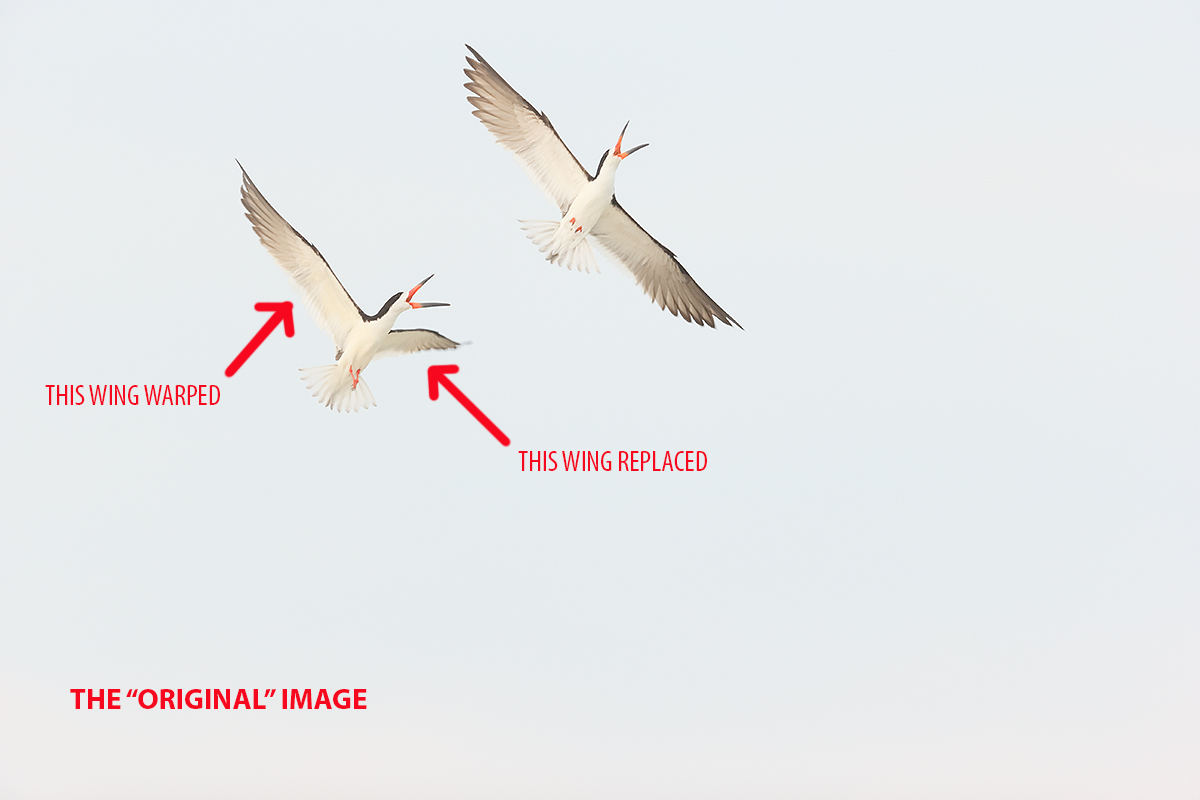
|
|
This is the base or “original” image, frame _Y7O0452.NY.CR2.
|
Almost But No Cigar
I liked a lot about the image above, especially the two open bills and the wings positions of the bird on the top right. The birds were too high in the frame but that would be an easy repair using techniques from APTATS II. In addition the far- (left) wing of the bird on the lower left was twisted in such a way as to have little impact on the image…. While reviewing the series of six images created in the same second I noticed that the far (left) wing of the bird on the lower left in the preceding frame, _Y7O0451.NY.CR2, was perfectly positioned…. See image next.
|
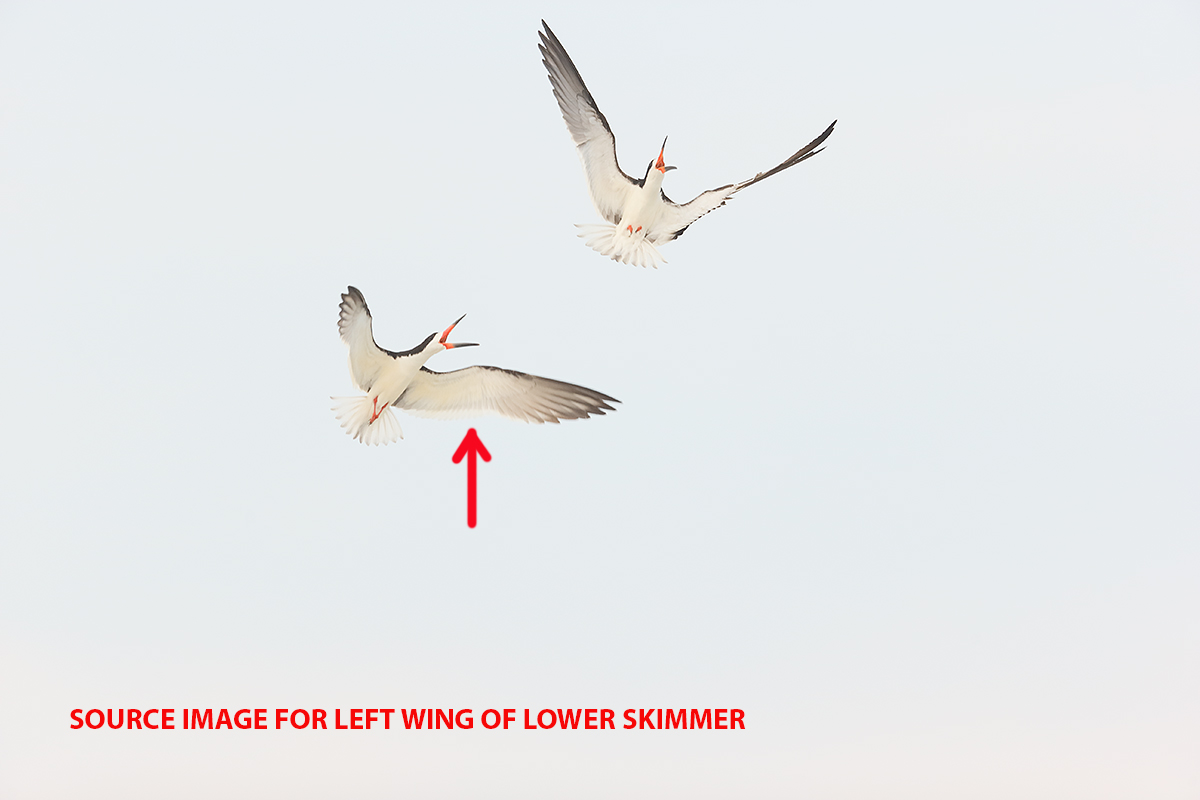
|
|
The preceding image, seen here, _Y7O0451.NY.CR2, served as source material for a new wing for the bird on the lower left in frame _Y7O0452.NY.CR2.
|
Assembling the Composite
Once I realized that I would be using parts of two images to create my final version, I first converted _Y7O0452.NY.CR2 in DPP, saved the recipe, and then pasted it in when converting _Y7O0451.NY.CR2. That ensured that the tonality of the two skies would match perfectly. To the same end, I made sure to eliminate the vignetting during the DPP conversion by checking the box for Peripheral illumination in the Lens aberration correction section that is found under the Lens tab. (All as detailed in the DPP Raw Conversion Guide.)
I painted a Quick Mask of the new wing as detailed in both Digital Basics and APTATS I and made sure to include lots of the surrounding sky so that the original wing would be completely covered. I put the selection on its own layer and then used the Move Tool (V) to bring the new wing onto the “original” or base image. I used the Free Transform command (Ctrl T) to position the layer and then added a Regular Layer Mask to fine-tune the selection. I needed to take great care when working on the area where the new wing met the bird’s body. It is always best to work large in situations like this. (Tip from Denise Ippolito.)
When the new wing was added successfully it was obvious that the near- (right) wing of the bird on the lower left looked too thin as compared to the wing that was just added. So I painted a Quick Mask of that wing, placed it on its own layer, and hit Ctrl T for the Free Transform command. I used both the Free Transform box handles and the Warp sub-command to broaden the wing but when I was done I saw that the area near the bird’s upper body was a mess; I had created a large halo where the leading edge of the wing met the back of the neck. I discarded that layer and started over. This time when I painted the Quick Mask of the wing I made sure not to include any of the bird’s upper back. I proceeded as above; the second time was the charm.
The Image Optimization
Once the wing repairs were complete Levels and Curves adjustments gave the image some pop, my NIK 50-50 preset was applied to the birds only, and the faces of both birds were selectively sharpened with a Contrast Mask (Unsharp mask at 15/65/0). All as detailed in my Digital Basics File. (See below for details).
The DPP RAW Conversion Guide
To learn why I use Canon’s Digital Photo Professional (DPP) 3.14 to convert every image that I work on, click here. Coming soon: the DPP 4.0 RAW Conversion Guide by Arash Hazeghi with Arthur Morris. I will be starting to use DPP 4.0 this week as I get into editing the new guide.
Digital Basics
Most everything that I did to optimize today’s image above is detailed in my Digital Basics File–written in my easy-to-follow, easy-to-understand style. Are you tired of making your images look worse in Photoshop? Digital Basics File is an instructional PDF that is sent via e-mail. It includes my complete digital workflow, dozens of great Photoshop tips, details on using all of my killer clean-up tools, the use of Contrast Masks, several different ways of expanding and filling in canvas, all of my time-saving Keyboard Shortcuts, Quick Masking, Layer Masking, and NIK Color Efex Pro basics, Digital Eye Doctor, Tim Grey Dodge and Burn, how to create time-saving actions, and lots more.
APTATS I & II
Learn the details of advanced Quick Masking techniques in APTATS I. Learn Advanced Layer Masking Techniques in APTATS I. Mention this blog post and apply a $5 discount to either with phone orders only. Buy both APTATS I and APTATS II and we will be glad to apply at $15 discount with phone orders only. Please call Jim or Jennifer at 863-692-0906 weekdays to order.
Used Photography Gear for Sale
Though we have sold a boatload of great gear recently, there are still some great buys available. Click here to see the complete listings. Below is today’s featured item.
Used Canon 400 DO IS USM Lens
Price slashed $450!
Joe Messina is offering a used Canon 400 DO IS USM lens in very good ++ condition for 3750! There are some minor cosmetic scratches to the finish. The lens hood is slightly out of round and is difficult to install. The sale includes an AquaTech flexible strap-on hood, a $150 value. The sale also includes the lens trunk (with key), the original leather hood, and a hard plastic lens cap. The seller will pay insured UPS shipping within continental US. The lens will ship after the check clears.
Please contact Joe via e-mail or by phone at 415-563-6577.
If you are looking for a fast, lightweight, hand holdable telephoto lens, this is the lens for you. Learn a ton more about the 400 DO here and see lots of 400 DO images by visiting the “The Canon 400mm f/4 IS DO Lens: Fourteen Images that Prove that the Internet Experts are (As Usual) Idiots” blog post here. The lens sells new at B&H for $6499.00.
Selling Your Used Photo Gear Through BIRDS AS ART
Selling your used (or like-new) photo gear through the BAA Blog or via a BAA Online Bulletin is a great idea. We charge only a 5% commission. One of the more popular used gear for sale sites charges a minimum of 20% plus assorted fees! Yikes. The minimum item price here is $500 (or less for a $25 fee). If you are interested please e-mail with the words Items for Sale Info Request cut and pasted into the Subject line :). Stuff that is priced fairly–I offer free pricing advise, usually sells in no time flat.
Facebook
Be sure to like and follow BAA on Facebook by clicking on the logo link upper right. Tanks a stack!
Support the BAA Blog. Support the BAA Bulletins: Shop B&H here!
We want and need to keep providing you with the latest free information, photography and Photoshop lessons, and all manner of related information. Show your appreciation by making your purchases immediately after clicking on any of our B&H or Amazon Affiliate links in this blog post. Remember, B&H ain’t just photography!
…..
Amazon Canada
Many kind folks from north of the border, ay, have e-mailed stating that they would love to help us out by using one of our affiliate links but that living in Canada and doing so presents numerous problems. Now, they can help us out by using our Amazon Canada affiliate link by starting their searches by clicking here. Many thanks to those who have written.
Typos
In all blog posts and Bulletins, feel free to e-mail or to leave a comment regarding any typos, wrong words, misspellings, omissions, or grammatical errors. Just be right. 🙂
August 7th, 2014 The Streak Continues: 250
This post was published just after 7:30am from my home at Indian Lake Estates, FL. Yesterday I enjoyed a great swim, an ice bath, a productive but relaxing day of work, and another good night’s sleep. This post, which took me about 1 1/2 hours to prepare, marks 250 consecutive days with a new enjoyable and educational blog post.
With so many folks getting in the habit of using our B&H links and our Amazon logo-links, why quit now? April, May, and June were fantastic. July was good. Lots of folks are getting the message: using my affiliate links does not cost you a penny and helps support my efforts here. To show your appreciation, I do ask that you use our B&H and Amazon affiliate links on the right side of the blog for all of your purchases. Please check the availability of all photographic accessories in the BIRDS AS ART Online Store, especially Gitzo tripods, Wimberley tripod heads, and the like. We sell only what I have used and tested, and know that you can depend on. We will not sell you junk. We know the tools that you need to make creating great images easy and fun. And we are always glad to answer your gear questions via e-mail.
You can find the following items in the store: Gitzo tripods, Mongoose M3.6 and Wimberley heads, plates, low feet, and accessories, flash brackets, , Delkin e-film Pro Compact Flash Cards, LensCoat products, and our unique line-up of educational materials including ABP I & II, Digital Basics, Site and Set-up e-Guides, Canon and Nikon Camera Users and AF e-Guides, and MP-4 Photoshop video tutorials among others.
I would of course appreciate your using our B&H affiliate links for all of your major gear, video, and electronic purchases. For the photographic stuff mentioned in the paragraph above we, meaning BAA, would of course greatly appreciate your business. Here is a huge thank you to the many who have been using our links on a regular basis and visiting the BAA Online store as well.
|
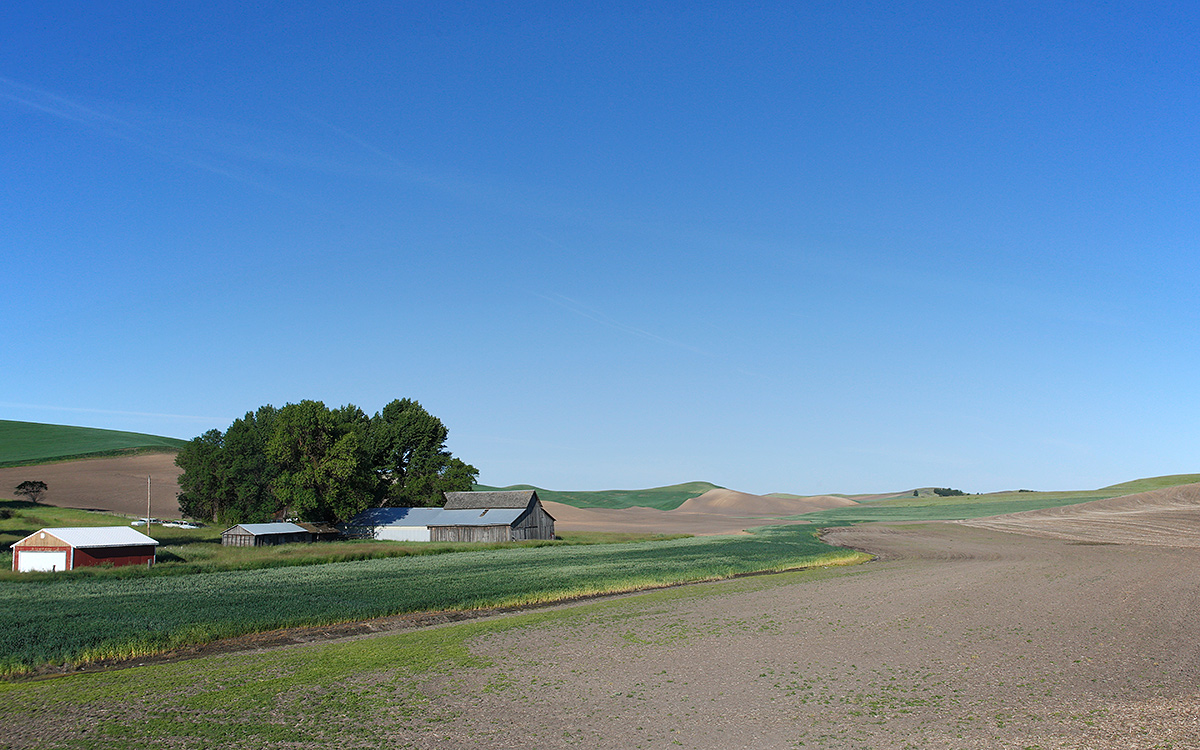
|
|
This 3-frame in-camera Natural HDR image was created on last spring’s Palouse exploratory trip with the Canon EF 24-70mm f/2.8L II USM lens (hand held at 25mm) and the Canon EOS 5D Mark III. ISO 400. Evaluative metering (+/- 2 stops around) +1 stop as framed yielded a base exposure of 1/500 sec. at f/14 in Av mode. Color temperature: AWB.
Central sensor/AI Servo/Surround Rear Focus AF on the grey barn and re-compose. Click here to see the latest version of the Rear Focus Tutorial. Click on the image to see a larger version.
s
|
The Challenge: Learning to Think and See Like a Pro
I made the image above as a teaching tool after we had spent about a half hour using longer lenses to extract various elements of the scene that we all had found interesting.
Here is the challenge: click on the image above to enlarge it. Examine it carefully. You have access to all focal lengths from 70mm to 784mm in the form of a 70-200 II and a 200-400 with Internal TC along with an external 1.4X III. The latter covers from 200-784mm in its various configurations. What catches your eye? What images would you extract from the scene? Please leave a comment and please be specific. I will share several of the images that I created that morning with you in this coming Saturday’s blog post. Suggestions for creating pleasing blurs are of course welcome.
Art Vivid/Natural In-camera HDR Exposure Tip
In the blog post of Tuesday August 5th, the featured image was an In-camera Art Vivid HDR. The 3 images in that HDR series were created +/- 2 stops around a base exposure that was created with an EC (exposure compensation) of +2 stops. The 3 images for today’s In-camera Natural HDR were created +/- 2 stops around a base exposure that was created with an EC (exposure compensation) of +2 stops. Note that both images were of similar overall tonality and were created in similar lighting conditions. Why +2 stop of EC for the base exposure of the ART Vivid HDR but only +1 stop of EC for the Natural HDR? While I do not know the technical reason or reasons for this, but experience has shown that you need to add a lot more light to an In-camera Art Vivid HDR than you do to an In-camera Natural HDR in order to wind up exposing to the right in the histogram for the final result, the 61mb JPEG.
|

|
|
Card and design by Denise Ippolito. Scroll down here to see lots more of Denise’s Palouse images. Note that the dates on Denise’s card are for the first Palouse IPT that is sold out with a long waiting list. The dates for the 2nd IPT are June 5-9, 2015. See below for complete details.
|
The Palouse A Creative Adventure/BIRDS AS ART Instructional Photo-Tour (IPT)/Eastern Washington State. May 29-June 2, 2015/5 Full Days: $1699/Limit 12 photographers/Sold Out with a long waiting list
As the trip above sold out quickly and now has a long waiting list we scheduled a second trip after giving ourselves 2 days to recover from the first one. We have already sold eight slots for the 2nd Palouse trip so please do not tarry if you wish to join us. There will not be a third trip. 🙂 See the details below.
|

|
|
Please note that there are two Palouse IPTs in place. Hope that you can join us 🙂 Card and design by Arthur Morris/BIRDS AS ART.
|
The Palouse A Creative Adventure/BIRDS AS ART Instructional Photo-Tour (IPT)/Eastern Washington State. June 5-9, 2015/5 Full Days: $1699/Limit 12 photographers/Openings 4; this trip is a go.
Rolling farmlands provide a magical patchwork of textures and colors, especially when viewed from the top of Steptoe Butte where we will likely enjoy spectacular sunrises and possibly a nice sunset or two. We will photograph grand landscapes and mini-scenics of the rolling hills and farm fields. We will take you to some really neat old abandoned barns and farmhouses in idyllic settings. There is no better way to improve your compositional and image design skills and to develop your creativity than to join us for this trip. Two great leaders: Denise Ippolito and Arthur Morris. Photoshop and image sharing sessions when we have the time and energy…. We get up early and stay out late and the days are long.
After 6 days of back-breaking scouting work in early June 2014 we found all of the iconic locations and, in addition, lots of spectacular new old barns and breath-taking landforms and views. We will teach you what makes one situation prime and another seemingly similar one a waste of your time.
What’s included: In-the-field instruction, guidance, lessons, and inspiration, our newfound but very extensive knowledge of the area, all lunches, motel lobby breakfasts, and Photoshop and image sharing sessions when possible.
You will learn and hone both basic and advanced compositional and image design skills. You will learn to get the right exposure every time. You will learn to develop your creative eye. You will learn the basics of HDR (high dynamic range) photography. You will learn a variety of in-camera creative techniques; Canon 5D Mark III bodies are a plus. And most importantly you will learn to see the situation and to create a variety of top-notch images. Do see both of our blogs for lots more on that in the coming weeks. You will learn how the quality and direction of light combine to determine the success of your images. And–please don’t gasp–we will be working quite a bit with sidelight when creating landscapes. Lastly, we will be touching on infrared photography.
A non-refundable $699 deposit is due now. The balance will be due on January 29, 2015. With the unpredictable nature of the photography business, I have not said this often lately, but it seems quite likely that this one will fill up very quickly. Please let me know via e-mail that you will be joining us. Then you can either call Jim or Jennifer at 863-692-0906 during business hours or send us a check; the latter is preferred.
Please send your deposit check made out to “Arthur Morris” to us at Arthur Morris/BIRDS AS ART, PO Box 7245, Indian Lake Estates, FL, 33855. If you have any questions, please feel free to contact me via e-mail. You can also contact denise via e-mail here
Facebook
Be sure to like and follow BAA on Facebook by clicking on the logo link upper right. Tanks a stack!
Support the BAA Blog. Support the BAA Bulletins: Shop B&H here!
We want and need to keep providing you with the latest free information, photography and Photoshop lessons, and all manner of related information. Show your appreciation by making your purchases immediately after clicking on any of our B&H or Amazon Affiliate links in this blog post. Remember, B&H ain’t just photography!
…..
Amazon Canada
Many kind folks from north of the border, ay, have e-mailed stating that they would love to help us out by using one of our affiliate links but that living in Canada and doing so presents numerous problems. Now, they can help us out by using our Amazon Canada affiliate link by starting their searches by clicking here. Many thanks to those who have written.
Typos
In all blog posts and Bulletins, feel free to e-mail or to leave a comment regarding any typos, wrong words, misspellings, omissions, or grammatical errors. Just be right. 🙂
August 6th, 2014 The Streak Continues: 249
This post was published at 6:38am from my home at Indian Lake Estates, FL. Yesterday, I enjoyed a nice swim, an ice bath, a productive but relaxing day of work, and another good night of sleep. This post, which took me about 2 hours to prepare, marks 249 consecutive days with a new enjoyable and educational blog post. Again, today’s post is quite educational. 🙂
With so many folks getting in the habit of using our B&H links and our Amazon logo-links, why quit now? April, May, and June were fantastic. July was good. Lots of folks are getting the message: using my affiliate links does not cost you a penny and helps support my efforts here. To show your appreciation, I do ask that you use our B&H and Amazon affiliate links on the right side of the blog for all of your purchases. Please check the availability of all photographic accessories in the BIRDS AS ART Online Store, especially Gitzo tripods, Wimberley tripod heads, and the like. We sell only what I have used and tested, and know that you can depend on. We will not sell you junk. We know the tools that you need to make creating great images easy and fun. And we are always glad to answer your gear questions via e-mail.
You can find the following items in the store: Gitzo tripods, Mongoose M3.6 and Wimberley heads, plates, low feet, and accessories, flash brackets, , Delkin e-film Pro Compact Flash Cards, LensCoat products, and our unique line-up of educational materials including ABP I & II, Digital Basics, Site and Set-up e-Guides, Canon and Nikon Camera Users and AF e-Guides, and MP-4 Photoshop video tutorials among others.
I would of course appreciate your using our B&H affiliate links for all of your major gear, video, and electronic purchases. For the photographic stuff mentioned in the paragraph above we, meaning BAA, would of course greatly appreciate your business. Here is a huge thank you to the many who have been using our links on a regular basis and visiting the BAA Online store as well.
|
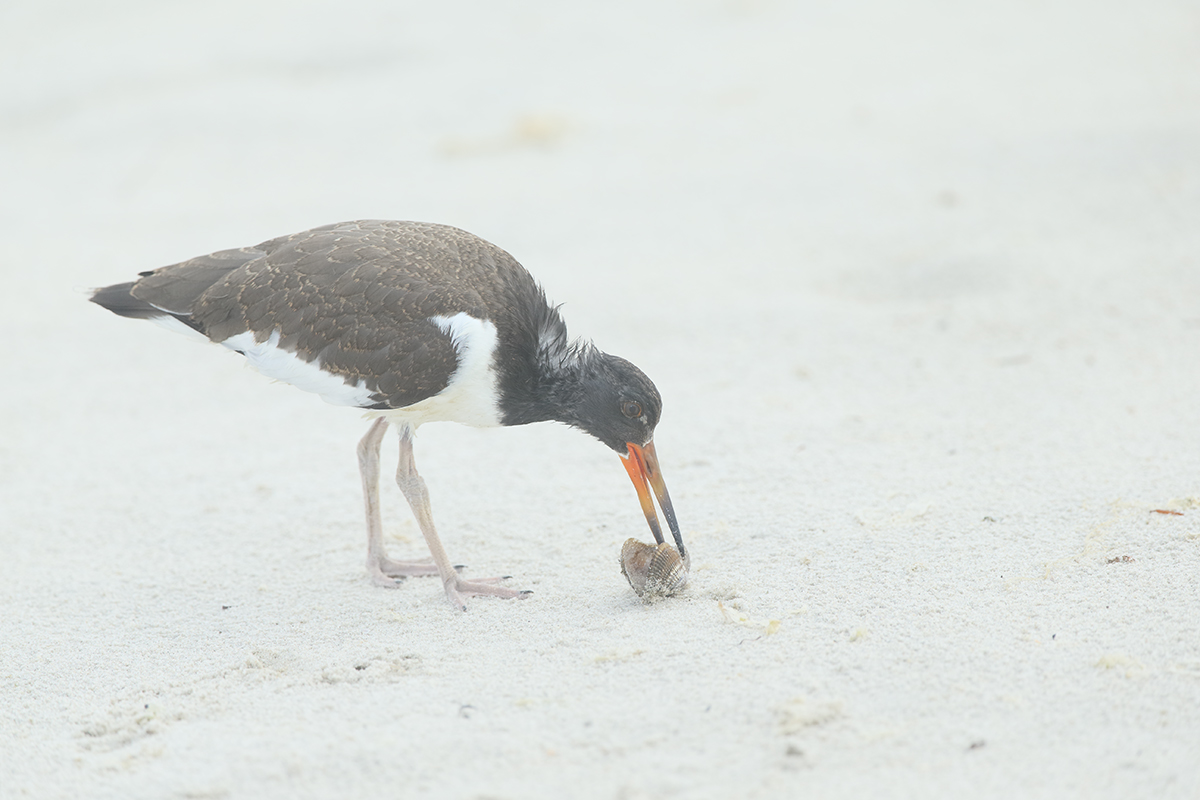
|
|
This image was created on first (very foggy) morning of this July’s Nickerson Beach IPT with the hand held Canon EF 300mm f/2.8L IS II USM lens, the Canon Extender EF 1.4X III, and the Canon EOS-1D X. ISO 400. Evaluative metering +2 stops off sand: 1/800 sec. at f/4.5 in Manual mode was a slight under-exposure. AWB.
One sensor to the left of the central sensor/AI Servo-Surround Rear Focus AF was active at the moment of exposure. Click on the image to see a larger version.
This JPEG represents the original image as it came out of camera.
|
The Image Optimization
The original image above was flat and a bit under-exposed. Note particularly the dull, dead look of the the bird’s face….After converting the image in DPP, I brought it into Photoshop CS-6. There, I did some beach clean-up with the Patch Tool, the Clone Stamp Tool, and the Spot Healing Brush. Next I selected the bird only (including the legs, feet, and bill) using the Quick Selection Tool, saved the selection, put the selection on a layer (Ctrl J), and ran my NIK 50-50 pre-set on the bird layer. (See below for detailed instructions on how to create your own pre-set recipes in NIK Color Efex Pro 4.) I flattened the image and still not happy with the pop, I duplicated my Background Copy layer, ran Auto Contrast on that layer, and reduced the opacity to about 30%. Next I re-loaded the selection, put it on its own layer, and applied a 15/65/0 Contrast Mask. To finish up I boosted the Vibrance, did just a bit of Eye Doctor work, did some Selective Color work on the whole image by adding 3 points of BLACK to the BLACKs and to the NEUTRALS, and finished the image off with some Tim Grey Dodge and Burn adjustments. You can see the optimized image below.
Image Capture Question
What could I/should I have done to create a more intimate image?
The DPP RAW Conversion Guide
To learn why I use Canon’s Digital Photo Professional (DPP) 3.14 to convert every image that I work on, click here.
Coming soon: the DPP 4.0 RAW Conversion Guide by Arash Hazeghi with Arthur Morris. I will be starting to use DPP 4.0 this week as I get into editing the new guide.
Digital Basics
Most everything that I did to optimize today’s image above is detailed in my Digital Basics File–written in my easy-to-follow, easy-to-understand style. Are you tired of making your images look worse in Photoshop? Digital Basics File is an instructional PDF that is sent via e-mail. It includes my complete digital workflow, dozens of great Photoshop tips, details on using all of my killer clean-up tools, the use of Contrast Masks, several different ways of expanding and filling in canvas, all of my time-saving Keyboard Shortcuts, Quick Masking, Layer Masking, and NIK Color Efex Pro basics, Digital Eye Doctor, Tim Grey Dodge and Burn, how to create time-saving actions, and lots more.
APTATS I & II
Learn the details of advanced Quick Masking techniques in APTATS I. Learn Advanced Layer Masking Techniques in APTATS I. Mention this blog post and apply a $5 discount to either with phone orders only. Buy both APTATS I and APTATS II and we will be glad to apply at $15 discount with phone orders only. Please call Jim or Jennifer at 863-692-0906 weekdays to order.
|
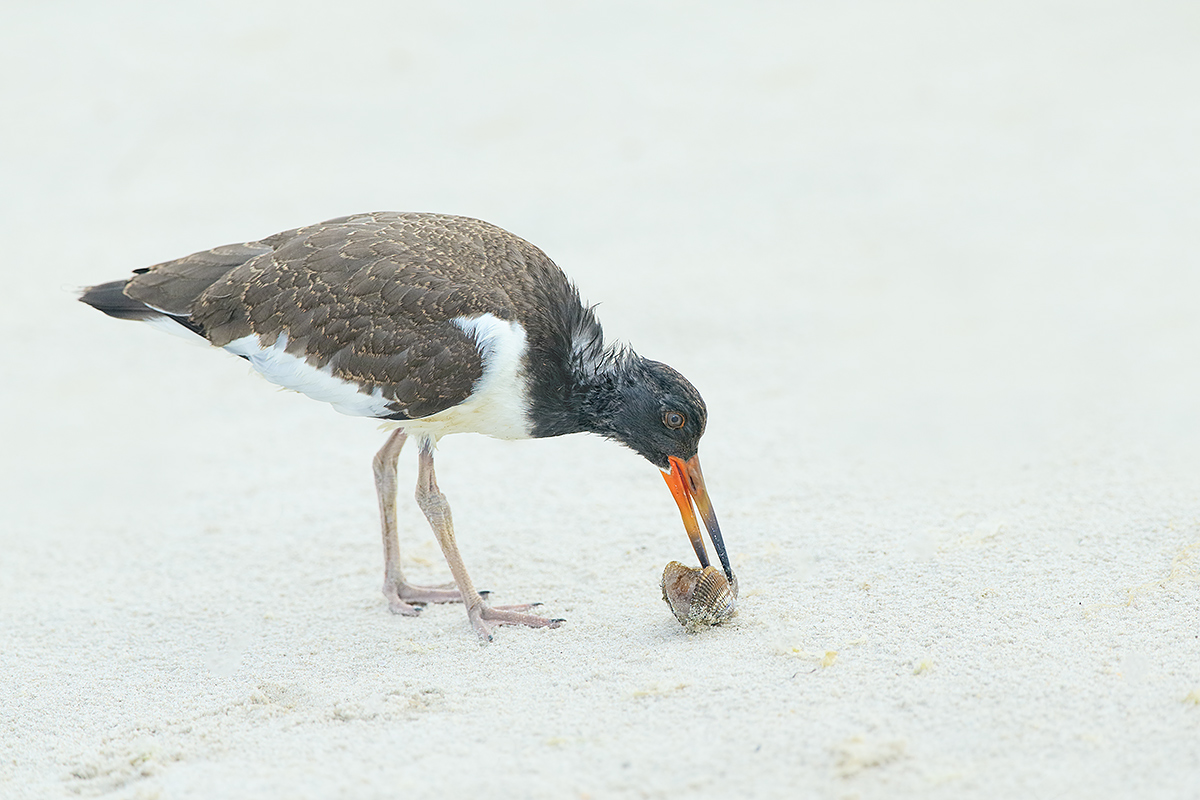
|
|
This, the optimized image, was created from the original image that opened this blog post. Note especially the pop of the optimized image as compared to the original image and note the improved look of the young American Oystercatcher’s face. There were more than a dozen young oystercatchers on the beach during the Nickerson Beach IPT–all of them were silly tame.
|
NIK Color Efex Pro 4
I began using NIK Color Efex Pro 4, my eyes opened as usual by Denise Ippolito. Simply put, there is nothing that can compare to Tonal Contrast and Detail Extractor in CEP4. Years ago, the entire NIK suite was quite expensive and most folks usually purchased only one or two the programs. Denise and I had a NIK affiliate account and we did very well for a few years. Then Google purchased NIK, drastically slashed the cost of the suite (all good), and eliminated the affiliate program (all bad :)). IAC, you can still save 15% by entering the code BAA at check-out.
From yesterday’s comments:
Jack Goodman
August 5, 2014 at 12:31 pm
Artie, I can’t seem to find a Nik 50-50 preset in my collection. Under which program will I find it.
Arthur Morris/BIRDS AS ART
August 5, 2014 at 6:08 pm
Jack, Please see tomorrow’s blog post for a tutorial. artie
So, this one’s for Jack:
NIK Color Efex Pro 4 Fifty-Fifty (50/50) Pre-set Tutorial
First use the Quick Selection Tool (my keyboard shortcut W) to select only the bird. Then place the selection on its own layer (Ctrl J). Then go to Filter/NIK/Color Efex Pro 4. Then Select Tonal Contrast from the list of Nature filters on the left. Now go to the right side of the NIK dialogue box. Click on the downward facing arrow just to the left of the words Control Points and then move the Opacity slider to 50%. Then click on Add Filter and select Detail Extractor from the list of Nature filters on the left. Again, click on the downward facing arrow just to the left of the words Control Points and then move the Opacity slider to 50%.
Now you are ready to save your recipe. Click on Save Recipe; it is right next to Add Filter. The program will prompt you to enter the name for your recipe. You can name it 50-50 TC/DE, TC for Tonal Contrast and DE for Detail Extractor. Then hit OK and your new recipe will be applied to the layer.
Whenever you would like to apply your 50-50 recipe simply click on the recipe on the side of the NIK dialogue box when the program opens. You may have to click on Recipes to see your recipe list or it may open to that. In most cases I reduce the opacity of the NIK 50-50 layer to about 50%. Rarely I leave it at 100% Opacity. With some landscape and flower images I apply my 50-50 pre-set to the whole image. You can always use a Regular Layer Mask to paint away the effect (at varying levels of opacity).
MP4 Photoshop Tutorial Videos
Some folks learn much better by seeing and listening than by reading the instructions. If you are in that group, you can learn a ton by watching me work in Photoshop by purchasing a few of our MP4 Photoshop Tutorial Videos. Click here to see the collection.
|

|
|
Images and card design by Denise Ippolito/A Creative Adventure
|
Denise Ippolito Nickerson Beach Workshop ~ Saturday & Sunday August 23-24th, $699.00 includes 4 photo sessions and 2 Image Review/ Photoshop sessions.
One great leader! Please let Denise know that you learned of this workshop through BIRDS AS ART. Click here and scroll down to register.
From Denise
There is just too much going on at Nickerson to stay away. I have decided to do a 2-day workshop at Nickerson Beach this August. By then lots of the Black Skimmer chicks will be hatched and there should also be plenty of action! The skimmers are lots of fun to photograph in flight, especially when they battle. We should also have good opportunities to photograph American Oystercatcher, Common Tern and maybe even some Least Terns and Piping Plovers. I will do my very best to get the group in position to capture great images. I will share with you my flight techniques and my techniques on getting you close to your subject. I will help you to recognize good situations and become a better bird photographer. This workshop needs 6 participants.
Saturday Schedule: 5:45am- 9:45am morning photography session, Lunch Break – Photoshop/Image Review, Gear and Camera settings session, Afternoon Break, 4:30pm- 7:30pm afternoon photography session.
Sunday Schedule: 5:45am- 9:45am morning photography session, Lunch Break- Photoshop/Image Review, Afternoon Break, 4:30pm- 7:30pm afternoon photography session.
We will photograph in the morning on Saturday, then break for an early lunch (included in the price). During lunch we will do image review and Photoshop lessons. After lunch I will go over gear handling tips and camera settings with the group. Then we will take an afternoon rest. This will give you time to download your images and have some time to yourself before we head back out in the late afternoon/early evening. Sunday we will wake up and have basically the same schedule as Saturday. This schedule is subject to change depending on conditions and wildlife. 🙂
Gear Suggestions:
I recommend that you bring your longest lens. If that is a 70-200mm lens than you will need a teleconvertor. You should have at the very least 400mm of focal length. A sturdy tripod- preferably w/o a center column. A complete list of gear recommendations as well as hotel recommendations and general information sheet will be provided at sign up.
Please contact Denise via e-mail with any questions.
Facebook
Be sure to like and follow BAA on Facebook by clicking on the logo link upper right. Tanks a stack!
Support the BAA Blog. Support the BAA Bulletins: Shop B&H here!
We want and need to keep providing you with the latest free information, photography and Photoshop lessons, and all manner of related information. Show your appreciation by making your purchases immediately after clicking on any of our B&H or Amazon Affiliate links in this blog post. Remember, B&H ain’t just photography!
…..
Amazon Canada
Many kind folks from north of the border, ay, have e-mailed stating that they would love to help us out by using one of our affiliate links but that living in Canada and doing so presents numerous problems. Now, they can help us out by using our Amazon Canada affiliate link by starting their searches by clicking here. Many thanks to those who have written.
Typos
In all blog posts and Bulletins, feel free to e-mail or to leave a comment regarding any typos, wrong words, misspellings, omissions, or grammatical errors. Just be right. 🙂
August 5th, 2014 The Streak Continues: 248
This post was published just before 8:00am from my home at Indian Lake Estates, FL. Though delayed close to 90 minutes, my flight to Orlando yesterday was otherwise uneventful. I enjoyed 8 hours of sleep last night. . This post, which took me about 2 hours to prepare, marks 248 consecutive days with a new enjoyable and educational blog post. Today’s post is quite educational. 🙂
With so many folks getting in the habit of using our B&H links and our Amazon logo-links, why quit now? April, May, and June were fantastic. July was good. Lots of folks are getting the message: using my affiliate links does not cost you a penny and helps support my efforts here. To show your appreciation, I do ask that you use our B&H and Amazon affiliate links on the right side of the blog for all of your purchases. Please check the availability of all photographic accessories in the BIRDS AS ART Online Store, especially Gitzo tripods, Wimberley tripod heads, and the like. We sell only what I have used and tested, and know that you can depend on. We will not sell you junk. We know the tools that you need to make creating great images easy and fun. And we are always glad to answer your gear questions via e-mail.
You can find the following items in the store: Gitzo tripods, Mongoose M3.6 and Wimberley heads, plates, low feet, and accessories, flash brackets, , Delkin e-film Pro Compact Flash Cards, LensCoat products, and our unique line-up of educational materials including ABP I & II, Digital Basics, Site and Set-up e-Guides, Canon and Nikon Camera Users and AF e-Guides, and MP-4 Photoshop video tutorials among others.
I would of course appreciate your using our B&H affiliate links for all of your major gear, video, and electronic purchases. For the photographic stuff mentioned in the paragraph above we, meaning BAA, would of course greatly appreciate your business. Here is a huge thank you to the many who have been using our links on a regular basis and visiting the BAA Online store as well.
|
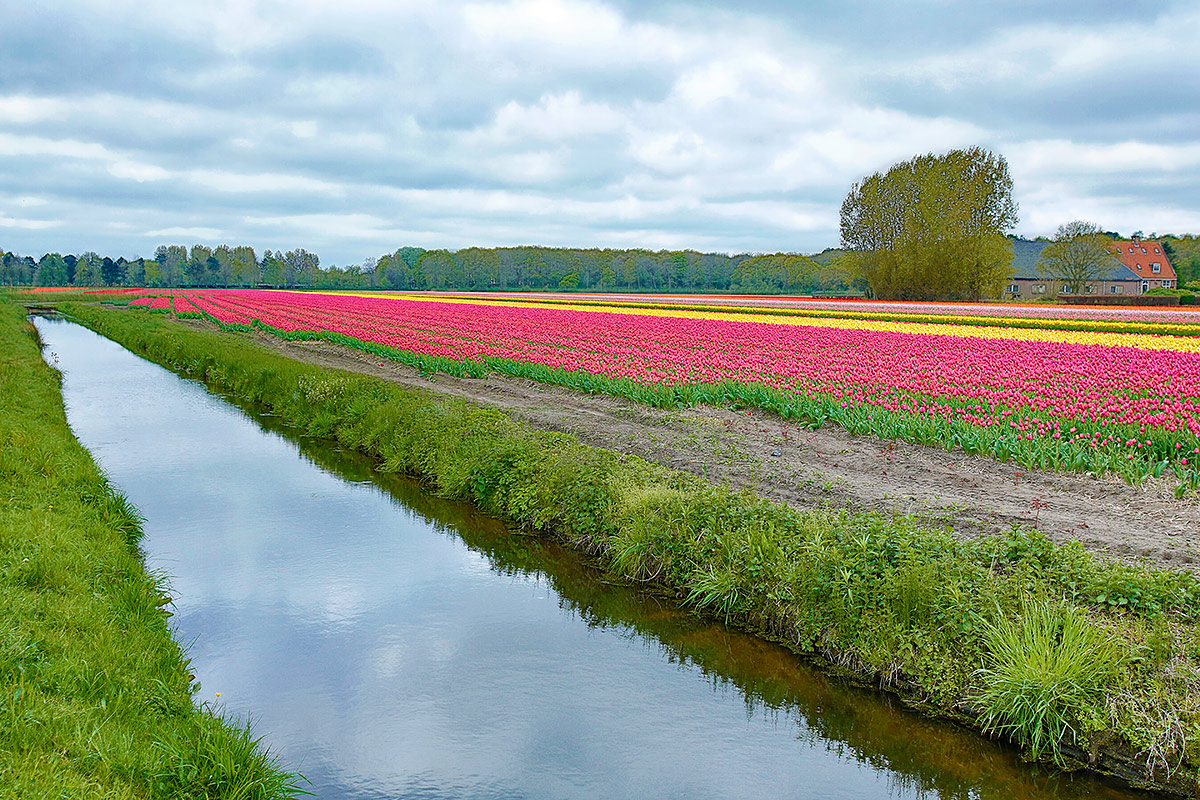
|
|
This 3-frame in-camera Art Vivid HDR image was created on last spring’s Tulips with a Touch of Holland IPT with the Canon EF 24-70mm f/2.8L II USM lens (hand held at 33mm) and the Canon EOS 5D Mark III. ISO 800. Evaluative metering (+/- 2 stops around) +2 stops as framed yielded a base exposure of 1/200 sec. at f/8 in Av mode. Color temperature: 5000K.
Central sensor/AI Servo/Surround Rear Focus AF 1/3 of the way into the frame and re-compose. Click here to see the latest version of the Rear Focus Tutorial. Click on the image to see a larger version.
Tulip Fields with Farmhouses
s
|
Compositional Care
Many photographers are quite lackadaisical when it comes to designing their images. “I’ll crop it later in Photoshop.” But coming up with a pleasingly composed image is much more about your choice of perspective than about cropping. At the NECCC Photography Conference where both Denise Ippolito and I presented in mid-July, I had the pleasure of attending a program by Ian Plant of Virginia entitled “Visual Flow: Mastering the Art of Composition.” With chagrin I will admit that I had never heard of Ian before. But oh my, what a talented photographer he is. And a very nice guy to boot. Yes, his program was quite professionally organized with lots of specials effects 🙂 (and a great sense of humor), but most special were his images. You can get a taste of those here.
Though Ian did not mention it during his program, I did tell him afterwards that one thing that struck me about most of his images aside from their beauty and impact was the fact no other photographer could have created the image that he had at that same moment? Why? Because his choice of perspective was always so impeccably perfect that even someone standing shoulder to shoulder with him would have had serious compositional flaws in their images….
Learning to improve your compositions does require study, thought, hard work, and a mastery of the many principles of image design. Ian covered most of those in his program. I cover most of them in the “Designing the Image” chapter in the original The Art of Bird Photography (ABP: 160 pages, 203 photos, soft-cover), in the chapter on “Advanced Composition and Image Design” in The Art of Bird Photography II (ABP II: 916 pages, 900+ images on CD only), here on the blog almost daily, at seminars and programs, in the field on IPTs, and in my critiques at BPN–Bird Photographers.Net; It Ain’t Just Birds, honest critiques done gently.
As photographers we peer through the viewfinder dozens, hundreds, or possibly thousands of times each and every day. Start taking more care each time that you do so. Start by looking for and avoiding merges, considering the compositional balance, and checking your backgrounds and frame edges for distracting elements.
Note: you can save $10 by purchasing ABP and ABP II together here.
Diagonally Speaking
I believe strongly that powerful diagonal lines can often be used to great effect by having them enter the frame exactly from one of the corners of the image. As in “Tulip Fields with Farmhouses” above. I shared this image on the rear LCD with several members of the group just outside of Keukenhoff. They all loved the image but–when I looked at their images on their rear LCDs, I saw that they had had trouble creating something similar, their problems all going back to the choice of perspective business. In addition to wanting the far edge of the canal from the lower right corner I wanted a small border of grass at the far end of the canal….
A Challenge
Please take a moment to leave a comment and mention as many of the principles of image design that you can. As soon as I publish this I will leave a comment mentioning the principles covered in the text of this blog post.
The Image Optimization
Aside from the image clean-up with my usual tools (Patch Tool, Spot Healing Brush, Clone Stamp Tool, and several small Quick Masks fine-tuned with regular Layer Masks), my 50-50 NIK pre-set at about 25% brought this image to life.
Image Optimization Question
Would you have done such an extensive cleanup of the light poles and the other hand of man stuff in the distant background? Why or why not?
Digital Basics
Everything that I did to optimize the image above is detailed in my Digital Basics File–written in my easy-to-follow, easy-to-understand style. Are you tired of making your images look worse in Photoshop? Digital Basics File is an instructional PDF that is sent via e-mail. It includes my complete digital workflow, dozens of great Photoshop tips, the use of Contrast Masks, several different ways of expanding and filling in canvas, all of my time-saving Keyboard Shortcuts, Quick Masking, Layer Masking, and NIK Color Efex Pro basics, my killer image clean-up techniques, Digital Eye Doctor, creating time-saving actions, and lots more.
APTATS I & II
Learn the details of advanced Quick Masking techniques in APTATS I. Learn Advanced Layer Masking Techniques in APTATS I. Mention this blog post and apply a $5 discount to either with phone orders only. Buy both APTATS I and APTATS II and we will be glad to apply at $15 discount with phone orders only. Please call Jim or Jennifer at 863-692-0906 weekdays to order.
Facebook
Be sure to like and follow BAA on Facebook by clicking on the logo link upper right. Tanks a stack!
|

|
|
Denise and artie hope that you can join them next spring in Holland and learn to improve both the technical and creative aspects of your flower (and street) photography.
|
7 1/2-Day/8-Night: A Creative Adventure/BIRDS AS ART/Tulips & A Touch of Holland Instructional Photo-Tour (IPT)
Keukenhof—Delft—Amsterdam–Flower Fields—Kinderdijk
April 9 -April 16, 2015: $4995. Limit: 12 photographers/Openings 10. Four more to make the trip a go.
This trip needs 6 registrants to run so please do not purchase your plane tickets until you hear from us that the trip is a go.
Join Denise Ippolito, the author of “Bloomin’ Ideas,” and Arthur Morris, Canon Explorer of Light Emeritus, for a great trip to Holland in mid-April 2015. Day 1 of the IPT will be April 9, 2015. We will have a short afternoon get-together and then our first photographic session at the justly-famed Keukenhof. Our last day, Day 8, April 16 will be a full day of photography.
The primary subjects will be tulips and orchids at Keukenhof and the spectacularly amazing tulip, hyacinth, and daffodil bulb fields around Lisse and points north. We will spend one full day in Amsterdam. There will be optional visits to the Van Gogh Museum, the Anne Frank House and/or the Rijk’s Museum. Street photography and sightseeing will be other options. We will spend a half day at Kinderdijk where we will be photographing the windmills and doing some creative photography. We will spend an afternoon in the lovely Dutch town of Delft where we will do some street photography and shopping. There is an optional church tower tour/climb. We will also enjoy a superb fine dining experience in a traditional restaurant.
Other than the arrival date: April 9, Day 1, and the date of our last day of photography on April 16, Day 8, there is no set itinerary. We will check the weather and play everything by ear to maximize the photographic opportunities. We will try to do Amsterdam, Delft, and especially Kinderdijik, on cloudy days.
There are several huge pluses to this trip. First off, denise is an amazingly skilled and caring instructor. Both her creativity and her willingness to share and to help beginning and intermediate photographers are unmatched. And though artie has learned a ton about flower photography from denise, their styles and techniques do vary considerably. You will have a chance to be counseled by and to learn from both of them. While denise will hunt you down to help you, artie’s teaching style is more “the closer you stay to me, the more you will learn.” Both leaders consistently inspire the participants. And each other. The sky, of course, is the limit.
You will learn to create tight abstracts, how best to use depth-of-field (or the lack thereof) to improve your flower photography, how to get the right exposure and make sharp images every time, how to see the best shot, and how to choose the best perspective for a given situation. And you will of course learn to create a variety of pleasingly blurred flower images. If you bring a long lens, you will learn to use it effectively for flower photography. Denise’s two favorite flower lenses are the Canon EF 100mm f/2.8L Macro IS USM lens and the Canon EF 24-105mm f/4L IS USM lens. Mine are the Canon 100mm f/2.8L IS macro , the Canon EF 180mm f/3.5L Macro USM lens ,and the Canon EF 300mm f/2.8L IS II USM lens, all almost always on a tripod. Often with extension tubes and/or either the 1.4X or the 2X (with the 300 II) teleconverters. Denise hand holds a great deal of the time. For flower field blurs denise uses the same lenses mentioned above along with her new 70-200mm f/2.8L IS III lens. Artie’s favorite is that same 70-200 often with a 1.4X TC but he uses both the new Canon EF 24-70mm f/2.8L II USM lens and the 300 II as well. Both of us use and love the Canon EOS 5D Mark IIIfor all of our flower photography. The in-camera HDR and Multiple Exposure features are a blast.
One of the great advantages of our trip is that we will be staying in a single, strategically located hotel that is quite excellent. Do note that all ground transfers to and from Schipol Airport will be via the free hotel shuttle bus.
What’s included: Eight hotel nights. All ground transportation except for airport transfers as noted above. In-the-field instruction and small group image review and Photoshop sessions. All meals from dinner on Day 1 through dinner on Day 8. There is good food at the hotel and we will be dining there on occasion; whenever you order off the menu be it at the hotel or at another restaurant only the cost of your main course is included. On these occasions the cost of soups, appetizers, salads, sodas and other beverages, alcoholic drinks and wine, bottled water, and desserts are not included. Snacks, personal items, phone calls, etc. are also not included. The cost of bus or train transportation to and from Amsterdam (about $20 US), museum entry, and tower and church entry fees (optional) are likewise not included.
Beware of seemingly longer, slightly less expensive tours that include travel days and days sitting in the hotel doing nothing as part of the tour. In addition, other similar trips have you changing hotels often and needlessly. One final note on other similar trips: the instructors on this trip actually instruct. On other similar trips the instructors, though usually imminently qualified, serve for the most part as van drivers and van door openers.
A non-refundable deposit of $1,000 per person is required to hold your spot. The second payment of $2,000 due by October 30, 2014. The balance is due on January 15, 2015. Payments in full are of course welcome at any time. All payments including the deposit must be by check made out to “Arthur Morris.” As life has a way of throwing an occasional curve ball our way, you are urged to purchase travel insurance within 15 days of our cashing your check. Artie uses and recommends Travel Insurance Services. All payments are non-refundable unless the trip fills to capacity. In that case, all payments but your deposit will be refunded. If the trip does not run every penny will of course be refunded. Again, please do not purchase your air tickets until you hear from us that the trip is a go. We are very confident that it will.
All checks should be made out to “Arthur Morris” and sent to: Arthur Morris, PO Box 7245, Indian Lake Estates, FL 33855. Call Jim or Jen in the BAA office with any additional registration questions: 863-692-0906.
For couples or friends signing up at the same time for the tulip trip, a $200/duo discount will be applied to the final payment.
When you send your deposit check, please print, sign, and include the paperwork here.
If you have any questions on the trip please contact artie by e-mail or denise by e-mail.
Support the BAA Blog. Support the BAA Bulletins: Shop B&H here!
We want and need to keep providing you with the latest free information, photography and Photoshop lessons, and all manner of related information. Show your appreciation by making your purchases immediately after clicking on any of our B&H or Amazon Affiliate links in this blog post. Remember, B&H ain’t just photography!
…..
Amazon Canada
Many kind folks from north of the border, ay, have e-mailed stating that they would love to help us out by using one of our affiliate links but that living in Canada and doing so presents numerous problems. Now, they can help us out by using our Amazon Canada affiliate link by starting their searches by clicking here. Many thanks to those who have written.
Typos
In all blog posts and Bulletins, feel free to e-mail or to leave a comment regarding any typos, wrong words, misspellings, omissions, or grammatical errors. Just be right. 🙂
August 4th, 2014 The Streak Continues: 247
This post was published just before 3:15am from my Mom’s home in Holbrook, NY. I need to get out of bed soon and pack. I am a late-packer :). I fly home today from ISP (Islip) on Southwest departing at 11:40am; right now the flight is showing on time despite the big flight delays in FL over the weekend. Jim will pick me up at MCO (Orlando) at about 2:30pm. This post, which took me about 1 1/2 hours to prepare, marks 247 consecutive days with a new enjoyable and educational blog post.
With so many folks getting in the habit of using our B&H links and our Amazon logo-links, why quit now? April, May, and June were fantastic. July was good. Lots of folks are getting the message: using my affiliate links does not cost you a penny and helps support my efforts here. To show your appreciation, I do ask that you use our B&H and Amazon affiliate links on the right side of the blog for all of your purchases. Please check the availability of all photographic accessories in the BIRDS AS ART Online Store, especially Gitzo tripods, Wimberley tripod heads, and the like. We sell only what I have used and tested, and know that you can depend on. We will not sell you junk. We know the tools that you need to make creating great images easy and fun. And we are always glad to answer your gear questions via e-mail.
You can find the following items in the store: Gitzo tripods, Mongoose M3.6 and Wimberley heads, plates, low feet, and accessories, flash brackets, , Delkin e-film Pro Compact Flash Cards, LensCoat products, and our unique line-up of educational materials including ABP I & II, Digital Basics, Site and Set-up e-Guides, Canon and Nikon Camera Users and AF e-Guides, and MP-4 Photoshop video tutorials among others.
I would of course appreciate your using our B&H affiliate links for all of your major gear, video, and electronic purchases. For the photographic stuff mentioned in the paragraph above we, meaning BAA, would of course greatly appreciate your business. Here is a huge thank you to the many who have been using our links on a regular basis and visiting the BAA Online store as well.
I Am Not Very Good At Mini-Landscapes/What’s Different?
In the I Am Not Very Good At Mini-Landscapes/What’s Different? post the four folks who responded pretty much nailed all the differences. Kudos to Doug West, David Policansky, Naveena, and Andrew McLachlan.
My Two Favorites From a 1362-Image Day on Great Gull Island…
In the My Two Favorites From a 1362-Image Day on Great Gull Island… post I like both images equally well. I love the splayed feathers of the braking tern with the green background and find the shade of blue in the taking flight image irresistible.
Image Questions:
What is the one thing that bugs me in one of the two images? What would I have preferred?
It would seem as if Paul Mckenzie were inside my head when he wrote, “The one thing I don’t like about the first image is the bird’s bill slightly protruding past the tail feathers – would have been better if the entire bill was framed within the tail feathers.” That is exactly what bugged me.
What are the strong points of each image? Any weaknesses?
Folks covered the strong points of each image quite well. As for the perceived weaknesses I disagreed with many of those. I have replied to each and every comment on this thread.
|
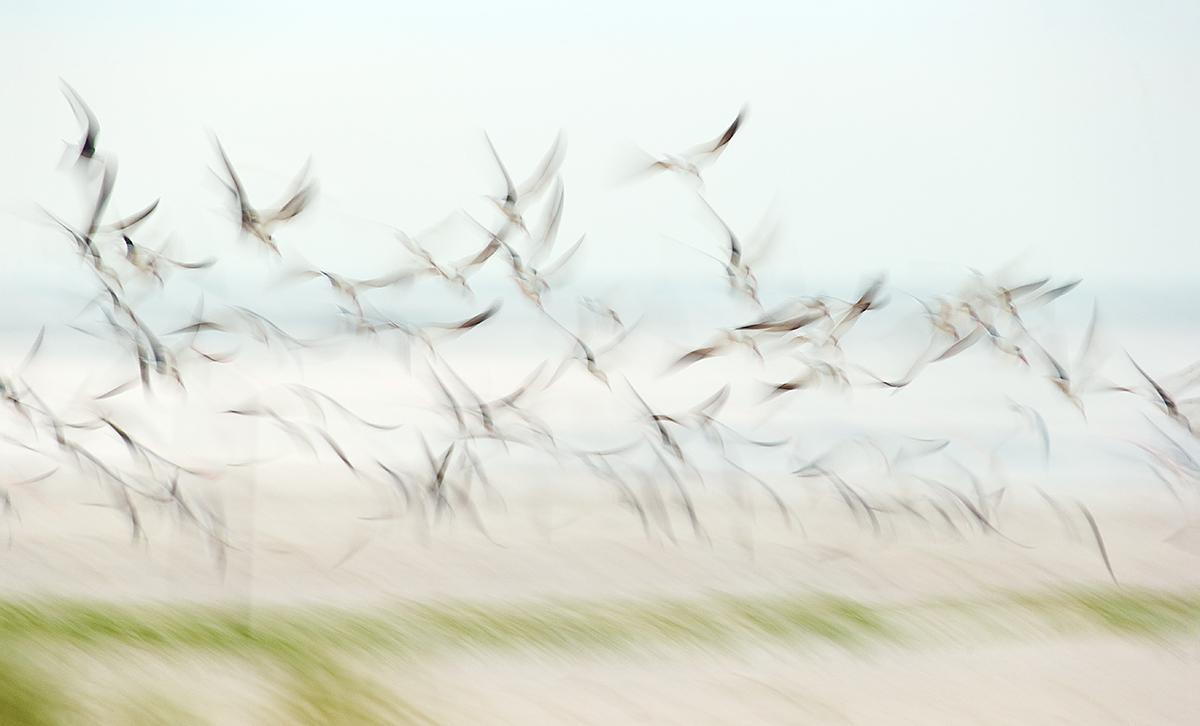
|
|
I preferred this image to the one with the read sky for its simplicity and child-like qualities. In the first image there were several really close, really blurred out-of-focus birds that were distracting. We teach that principle on the Bosque IPTs most every day.
|
What Can You Possibly Do When You Get Up at 2:07am?
In the What Can You Possibly Do When You Get Up at 2:07am? nobody took a crack at any of the questions. I guess I will have to go with easier ones…. 🙂
These two image were created just minutes apart: why is there such a big difference in the (effectively) auto ISO settings: ISO 250 for opening image, ISO 1600 for the second image?
For the first image the lens was pointed at the relatively bright eastern sky, at the spot where the sun would rise in less than 30 minutes. In the second image the lens was pointed in the opposite direction, 180 degrees away from the light sky thus the need for a much higher ISO setting.
What percentage of the available focal length range did I use to create today’s two images?
With the 2X TC in place the focal length range of the 70-200 is 140-400mm. Since one image was made at 140mm and the other at 400mm I used 100% of the focal length range.
Used Canon 70-200mm f/2.8L IS II Lens
Dale Lorenzen is offering a used Canon 70-200mm f/2.8L IS II USM Lens in nearly mint condition for $1850. It is like new with a small scratch on the hood. The sale includes the original box, the software CD, the carrying case, the tripod ring, and the front and rear caps. The seller will pay insured UPS shipping within continental US. The lens will ship after the check clears.
Please contact Dale via e-mail. At this give-away price, this lens should sell instantly.
As regular blog readers know full well, the Canon 70-200mm f/2.8L IS II USM lens is one of my very favorite lenses. It is often the only other lens that I take into the field with my tripod-mounted Canon EF 600mm f/4L IS II USM lens. As above, I use it often to create small-in-the-frame or habitat images. I use it for flocks in flight at Bosque with either TC. I use it often to photograph family groups of birds or birds interacting at close range. I use it a ton for scenic images as I did with great success in the Palouse. And I use it either alone (see here) or with either TC to photograph birds in flight at close range. In short, the 70-200 II is an incredibly versatile hand holdable intermediate telephoto lens that offers me a focal length range of from 70 to 400mm.
Used Photo Gear
Though we have sold a ton of great stuff in the last 2 weeks there are still several great buys like the one above. Click here to view all the current listings.
If you are a seller, be sure to read Mark’s helpful warning comments at the bottom of the page.
The 2015 UK Puffins and Gannets IPT
June 29 through July 5, 2015: $5499: Limit 10 photographers/Openings 7. Two great leaders: Denise Ippolito and Arthur Morris.
We now have 3 folks signed up with five others seriously interested not only in the IPT but in the possible 3-Day pre-trip to Ireland…, If you are seriously interested it would be best not to tarry. Click here for complete details.
The Question: Did Murphy’s Law Strike Again? Or Not?
In the image above Mr. Murphy did indeed strike again. That left me having to do some fancy work in Photoshop in what seemed at the time like a perfect set-up. When the chick peeked out from the adult’s breast I fired off a 25-frame burst without filling the buffer on my dependable Delkin 64GB 1000X Compact Flash Card.
For the first 13 frames the head angle for the adult was perfect but the head of the chick was turned well away. On the 14th frame, the one that served as the base image for the optimized image above, the chick–as you can see–turned nicely towards me. But no, could it be true? On that very frame the adult turned its head well to the right. So I painted a Quick Mask of the head of the adult in the 13th frame and placed that layer atop the head of the adult in the 14th frame. It took quite a bit of work getting everything lined up properly and fine tuning the added layer with a Regular Layer Mask. To further complicate things the background below the bird’s neck looked a bit phony in the original capture, frame 14…. No amount of work there could get that area to look natural to me.
Thanks
Thanks to Ted Wilcox for leaving a comment and pointing out that the image in the original post needed a good deal of clockwise rotation. The image above is a re-do with 1.5 degrees of clockwise rotation. I used the John Haedo technique for filling in the needed canvas (as detailed in Digital Basics.
The DPP RAW Conversion Guide
To learn why I use Canon’s Digital Photo Professional (DPP) 3.14 to convert every image that I work on, click here.
Digital Basics
Everything that I did to optimize the image above is detailed in my Digital Basics File–written in my easy-to-follow, easy-to-understand style. Are you tired of making your images look worse in Photoshop? Digital Basics File is an instructional PDF that is sent via e-mail. It includes my complete digital workflow, dozens of great Photoshop tips, the use of Contrast Masks, several different ways of expanding and filling in canvas, all of my time-saving Keyboard Shortcuts, Quick Masking, Layer Masking, and NIK Color Efex Pro basics, my killer image clean-up techniques, Digital Eye Doctor, creating time-saving actions, and lots more.
APTATS I & II
Learn the details of advanced Quick Masking techniques in APTATS I. Learn Advanced Layer Masking Techniques in APTATS I. Mention this blog post and apply a $5 discount to either with phone orders only. Buy both APTATS I and APTATS II and we will be glad to apply at $15 discount with phone orders only. Please call Jim or Jennifer at 863-692-0906 weekdays to order.
Facebook
Be sure to like and follow BAA on Facebook by clicking on the logo link upper right. Tanks a stack!
Support the BAA Blog. Support the BAA Bulletins: Shop B&H here!
We want and need to keep providing you with the latest free information, photography and Photoshop lessons, and all manner of related information. Show your appreciation by making your purchases immediately after clicking on any of our B&H or Amazon Affiliate links in this blog post. Remember, B&H ain’t just photography!
…..
Amazon Canada
Many kind folks from north of the border, ay, have e-mailed stating that they would love to help us out by using one of our affiliate links but that living in Canada and doing so presents numerous problems. Now, they can help us out by using our Amazon Canada affiliate link by starting their searches by clicking here. Many thanks to those who have written.
Typos
In all blog posts and Bulletins, feel free to e-mail or to leave a comment regarding any typos, wrong words, misspellings, omissions, or grammatical errors. Just be right. 🙂
August 3rd, 2014 The Streak Continues: 246
This post was published just before 7:00am from my Mom’s home in Holbrook, NY. I enjoyed another relaxing day here yesterday. And a nice swim in the rain. This post, which took me about 2 1/2 hours to prepare, marks 246 consecutive days with a new enjoyable and educational blog post. Tomorrow I pack for my flight home on Monday.
With so many folks getting in the habit of using our B&H links and our Amazon logo-links, why quit now? April, May, and June were fantastic. July was good. Lots of folks are getting the message: using my affiliate links does not cost you a penny and helps support my efforts here. To show your appreciation, I do ask that you use our B&H and Amazon affiliate links on the right side of the blog for all of your purchases. Please check the availability of all photographic accessories in the BIRDS AS ART Online Store, especially Gitzo tripods, Wimberley tripod heads, and the like. We sell only what I have used and tested, and know that you can depend on. We will not sell you junk. We know the tools that you need to make creating great images easy and fun. And we are always glad to answer your gear questions via e-mail.
You can find the following items in the store: Gitzo tripods, Mongoose M3.6 and Wimberley heads, plates, low feet, and accessories, flash brackets, , Delkin e-film Pro Compact Flash Cards, LensCoat products, and our unique line-up of educational materials including ABP I & II, Digital Basics, Site and Set-up e-Guides, Canon and Nikon Camera Users and AF e-Guides, and MP-4 Photoshop video tutorials among others.
I would of course appreciate your using our B&H affiliate links for all of your major gear, video, and electronic purchases. For the photographic stuff mentioned in the paragraph above we, meaning BAA, would of course greatly appreciate your business. Here is a huge thank you to the many who have been using our links on a regular basis and visiting the BAA Online store as well.
|
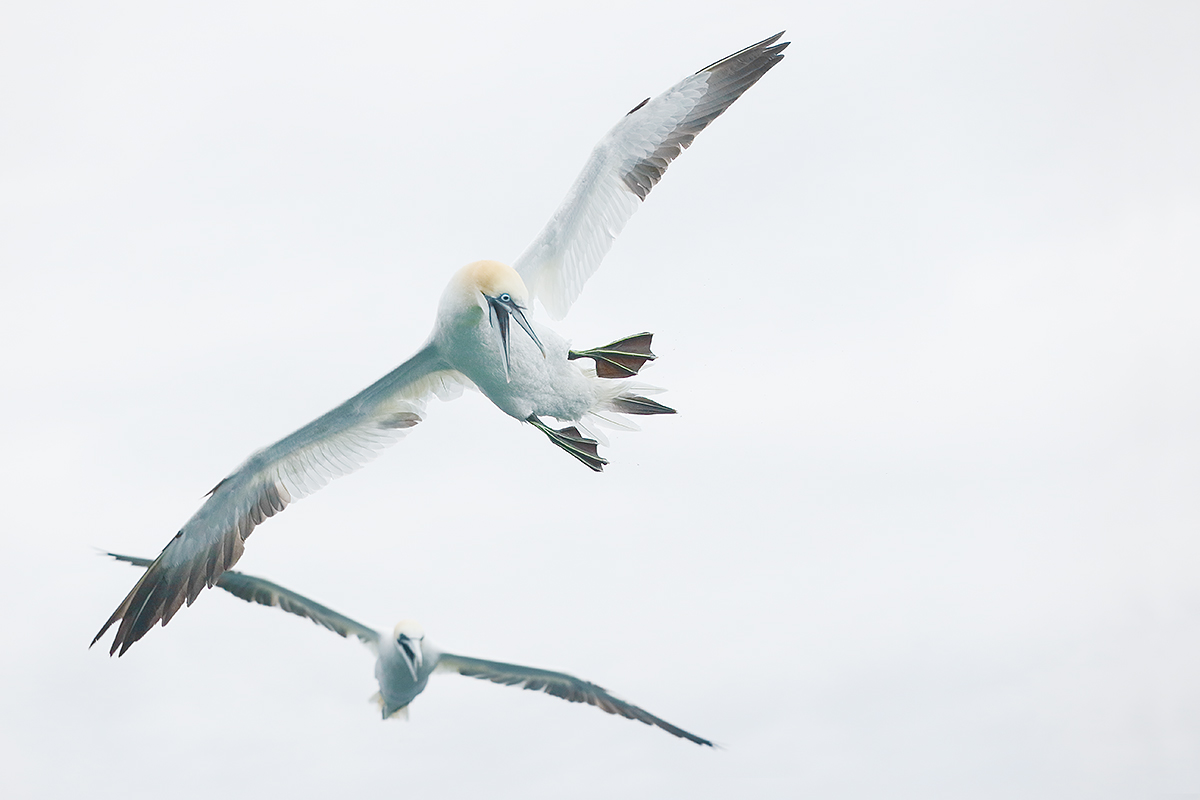
|
|
This image was created with the hand held Canon EF 70-200mm f/2.8L IS II lens (at 130mm) and the Canon EOS-1D X. ISO 800. Evaluative metering + 2 1/3 stops off the dreary grey sky: 1/2000 sec. at f/4.5 in Manual mode was a significant under-exposure.
Central sensor/AI Servo Surround/Shutter Button Focus AF on the bird’s rear belly was active at the moment of exposure. Be sure to click on the image to see a larger version.
Image #1: Gannets Crossing
|
The Impetus for Change…
On our first trip on the gannet boat the action was so fast and furious that after the first half hour of our two hour session lactic acid began to build up in my right thumb from too much rear focusing. So I decided to turn off Rear Focus and go with Shutter Button AF. Doing that is super-simple with both the 1D X and the 5D III. Learn how immediately below. IAC, it was good-bye to the muscle strain and fatigue. And I got dozens of great keepers like the one above…. That got me to thinking….
|
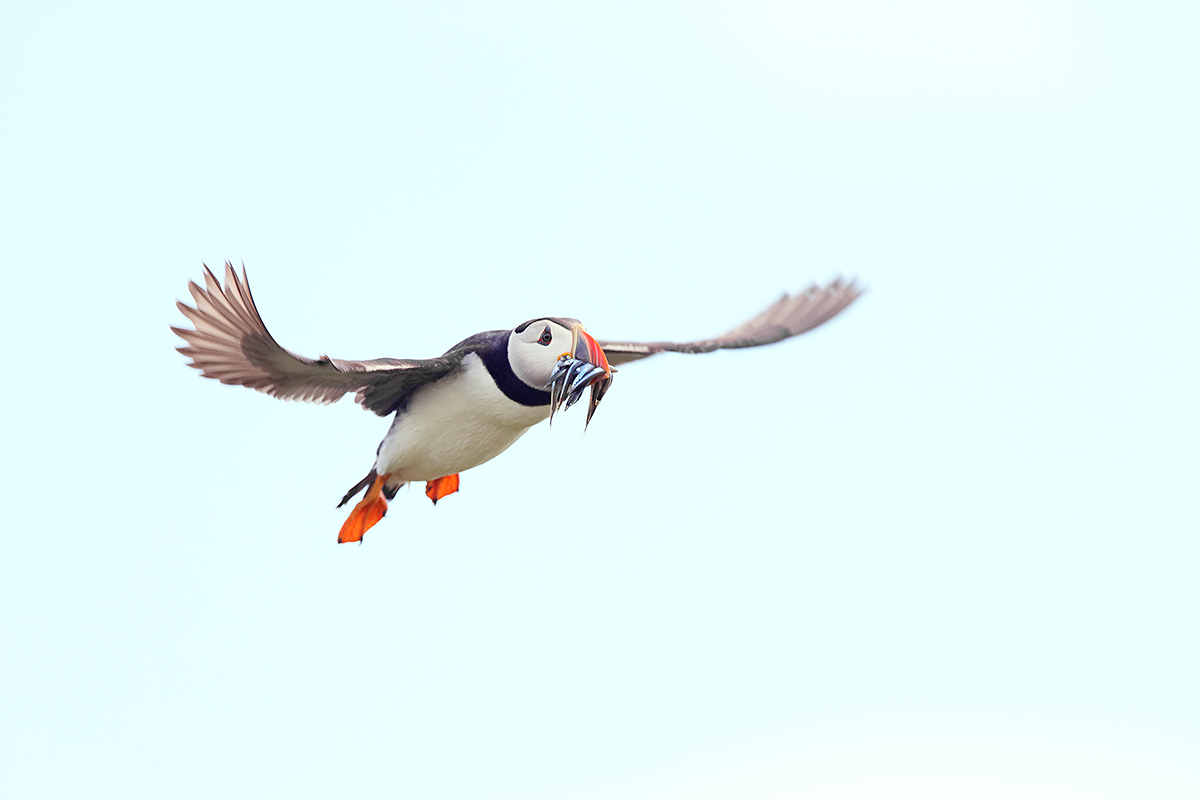
|
|
This image was created with the hand held Canon EF 300mm f/2.8L IS II USM lens, the Canon Extender EF 1.4X III, and the Canon EOS-1D X. ISO 400. Evaluative metering +1 2/3 stops off the cloudy bright sky: 1/1600 sec. at f/4.5 in Manual mode. AWB.
Central sensor/AI Servo-Expand Shutter Button AF barely caught the head of a tiny fish as originally framed and was of course active at the moment of exposure. Click on the image to see a larger version.
Image #2: Puffin Carrying Fish
|
Here’s How
Switching from Rear Focus to Shutter Button focus and back again is actually a snap as long as you know how to use the Q button on the back of your 1D X or 5D III. Let’s say that you are set up for Rear Focus. First press the Q button. This brings up the Custom Controls screen on the rear LCD. Now scroll with the joystick to the camera body symbol in the lower right corner and press the Set button. The first item in the left hand list just happens to be the one that we need to access: “shutter button. half press”. Since you are set up for Rear Focus the 2nd line will read “Metering start”. Now press Set again. The symbol in the middle, “Metering start” will be highlighted in aqua. To switch to Shutter Button AF simply turn the thumb wheel one click counter-clockwise so that the “Metering and AF Start” symbol is highlighted.
Although it took me more than 5 minutes to carefully craft the how-to text above actually switching from Rear Focus to Shutter Button AF takes less than 3 seconds with a modicum of practice. To go back to Rear Focus, simply reverse the last step.
|
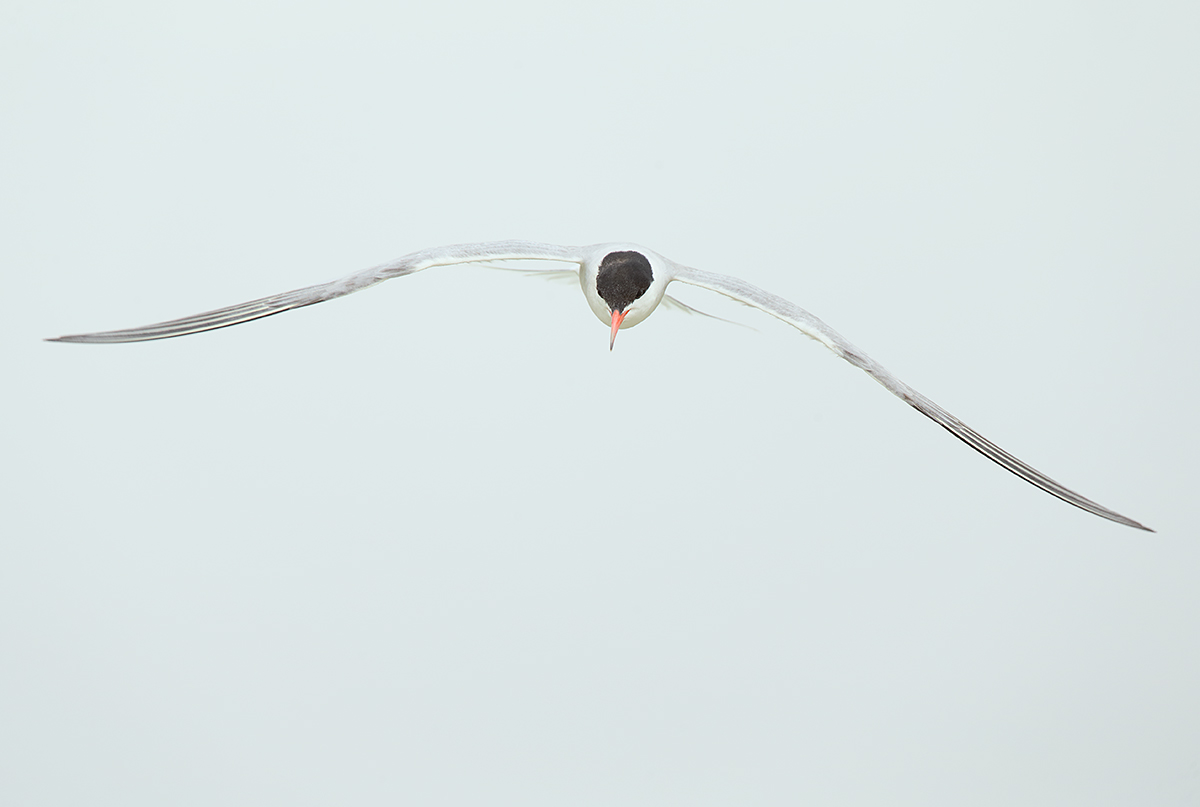
|
|
This image was created on the Nickerson Baby Beach Nesting Birds IPT at 3:46pm on a rare foggy afternoon with the Gitzo 3532 LS carbon fiber tripod, the Mongoose M3.6 head, the Canon EF 600mm f/4L IS II USM lens and the Canon EOS-1D X. ISO 400. Evaluative metering +3 stops off the very light grey sky: 1/1000 sec. at f/5.6 in Av mode. AWB.
One sensor above and one sensor to the left of the central sensor/AI Servo/Surround shutter button AF just caught the right side of the tern’s body and was active at the moment of exposure. Click on the image to see a larger version.
Image #3: Common Tern in Fog
|
The Rear Focus Confession
By the time that we got to Nickerson Beach I decided that in flight-only situations I would go with shutter button AF. Gasp! By flight-only situations I mean periods of time when I will be concentrating on photographing birds in flight to the virtual exclusion of all else. On Great Gull Island I began doing the same thing. Please do not think that I have forsaken Rear Focus/AI Servo AF for my general bird, wildlife, nature, and scenic photography. There are huge advantages to using Rear Focus in those areas. I now go to shutter button AF only when I will be doing pure flight photography. In all other situations I simply switch back to Rear Focus AF. If a bird happens to fly by then, I will use Rear Focus AF for flight.
Over the past few weeks one or two careful readers have noticed that the familiar “Rear Focus AF” text was on occasion missing in action from our legendary BAA educational captions… In fact, many of the quite excellent flight photographs that I have posted fairly recently were created with shutter Button AF. The most spectacular of those was the diving Common Tern in the blog post here.
|
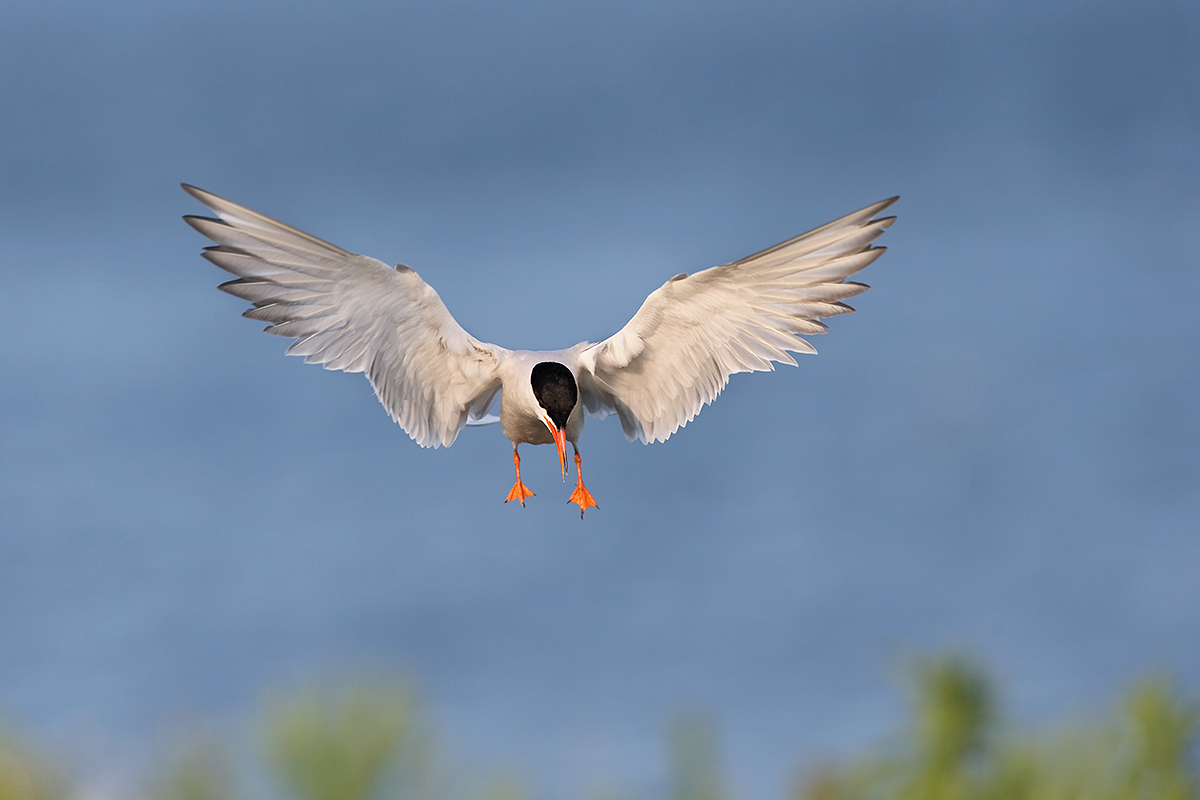
|
|
This image was created on Great Gull Island with the hand held Canon EF 300mm f/2.8L IS II USM lens, the Canon Extender EF 1.4X III, and the Canon EOS-1D X. ISO 400: 1/3200 sec. at f/4.5 in Manual mode was set inadvertently; I meant to be at 1/1600 sec. at f4.5…. The result was a 1 stop under-exposure. AWB.
Central sensor/AI Servo-Manual Selection Shutter Button AF just to our right of the top of the bird’s head was of course active at the moment of exposure. Click on the image to see a larger version.
Image #4: Common Tern Landing
|
Please Remember…
As far back as the the original The Art of Bird Photography I wrote something to this effect: “If you run into me in the field and see me doing something differently please remember that that would just show that I am getting smarter and that I am always trying to learn and to improve. As above.
Your Favorite?
Please take a moment to leave a comment and let us know which of the two images here is your favorite. And do let us know why you made your choice.
|
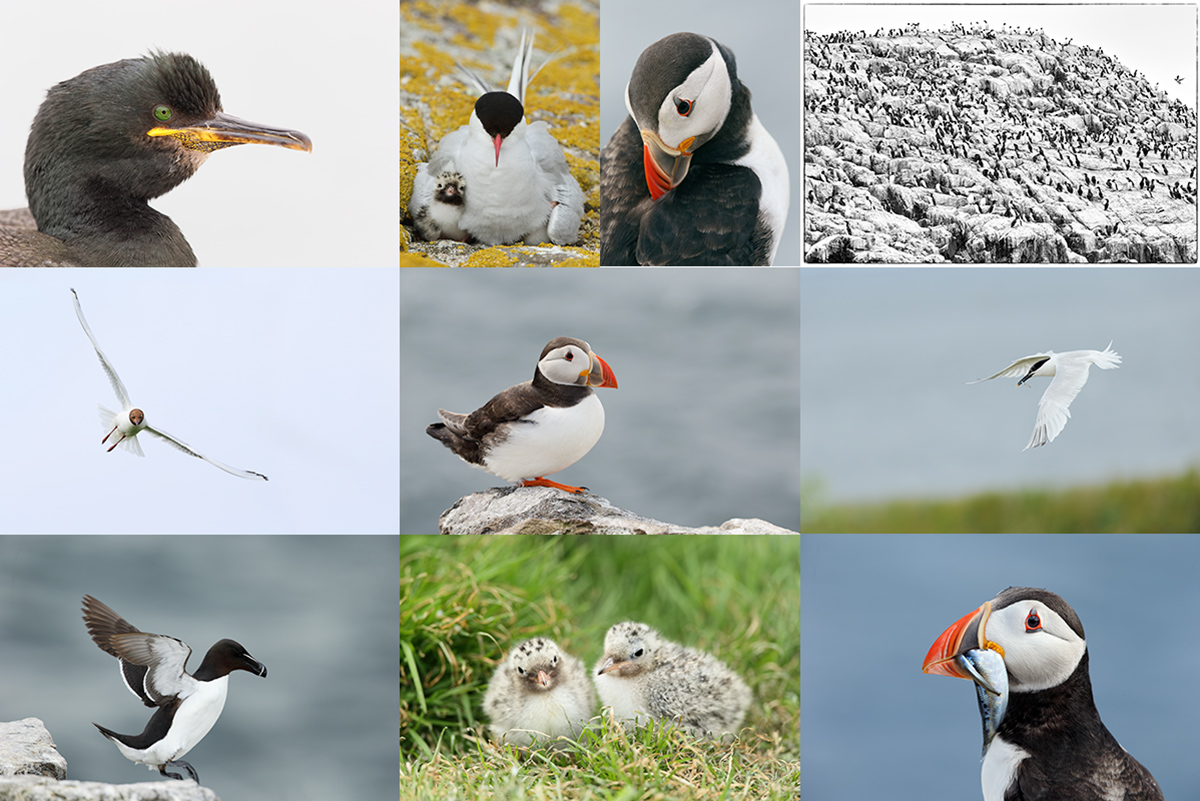
|
|
Images and card design copyright 2014: Arthur Morris/BIRDS AS ART. Click on the card to enjoy a spectacular larger version.
|
The 2015 UK Puffins and Gannets IPT
June 29 through July 5, 2015: $5499: Limit 10 photographers/Openings 8. Two great leaders: Denise Ippolito and Arthur Morris.
Here are the plans for next year: take a red eye from the east coast of the US on 28 June arriving in Edinburgh, Scotland on the morning of Monday 29 June (or simply meet us then either at the Edinburgh Airport (EDI) or later in the day at our cottages if you are driving your own vehicle either from the UK or from somewhere in Europe. Stay 7 nights in two gorgeous modern country cottages.
There are 5 days of planned puffin/seabird trips—weather permitting, and 1 full day of gannet photography with 2 sessions on the boat.
|
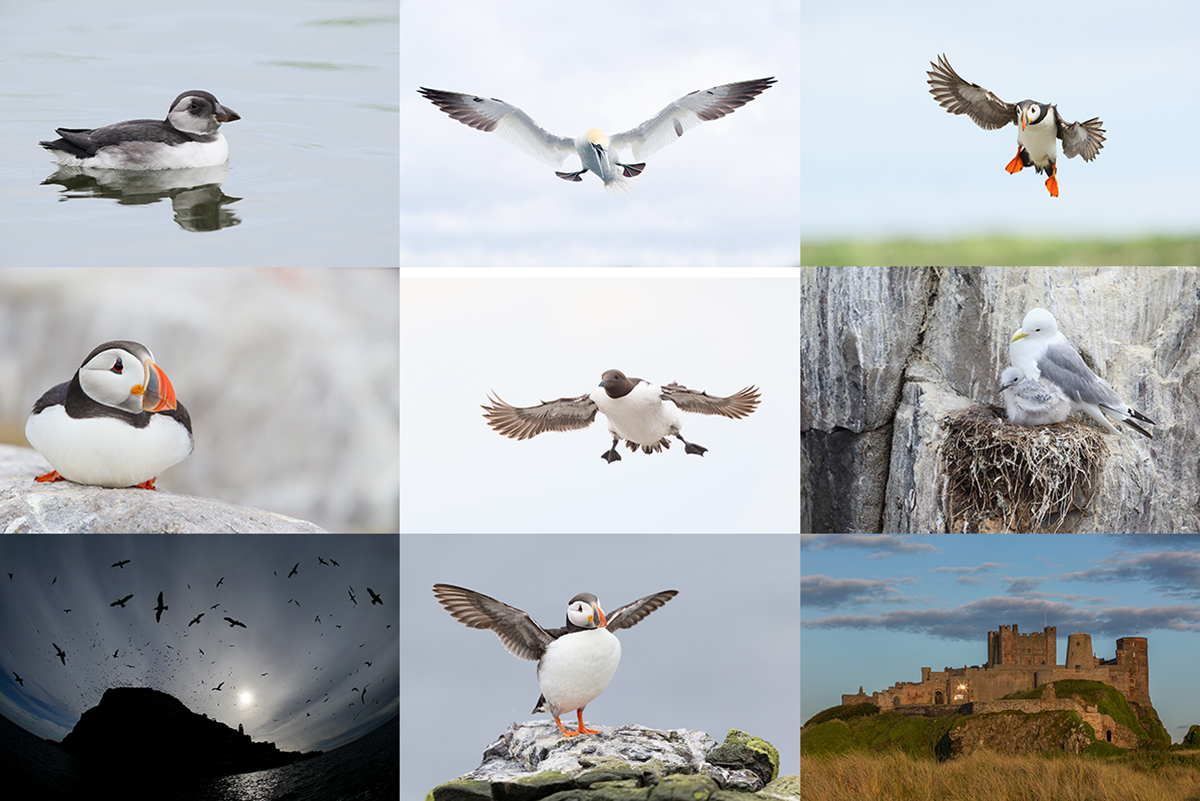
|
|
Images and card design copyright 2014: Arthur Morris/BIRDS AS ART. Click on the card to enjoy a spectacular larger version.
|
The Details
All breakfasts, lunches and dinners are included. All 5 puffins boat lunches will need to be prepared in advance, taken with, and consumed at your leisure. I usually eat mine on the short boat trip from one island to the other. Also included is a restaurant lunch on the gannet boat day and a farewell fine dining thank you dinner. The cost of your National Heritage Trust is also included; that covers the twice a day landing fees.
Plan to fly home on the early morning of Monday 6 July or to continue your stay or travels.
We are planning this as double-occupancy only but we should be able to arrange for singles by renting a 3rd cottage. We would need to know well in advance, i.e., soon, and it would be pricey and would need to be paid with your non-refundable deposit of $2,000. The shared rooms are decent-sized, each with two roomy single beds and a private bathroom. There are two king rooms available for couples. The upscale country-side cottages are beyond lovely with large living areas and lots of open space for image sharing and Photoshop lessons.
The single supplement is $1475. As we will be renting a third cottage the $1475 is due with your deposit and is also non-refundable.
If you are good to go please send your $2,000 deposit check now to save a spot. We do expect this workshop to sell out very quickly as we have already sold 2 slots even though the trip has not yet been formally announced till right now. Not to mention that everyone loves puffins. Please make your check out to “Arthur Morris” and send it to Arthur Morris/BIRDS AS ART, PO Box 7245, Indian Lake Estates, FL, 33855.
We do hope that you can join us.
|
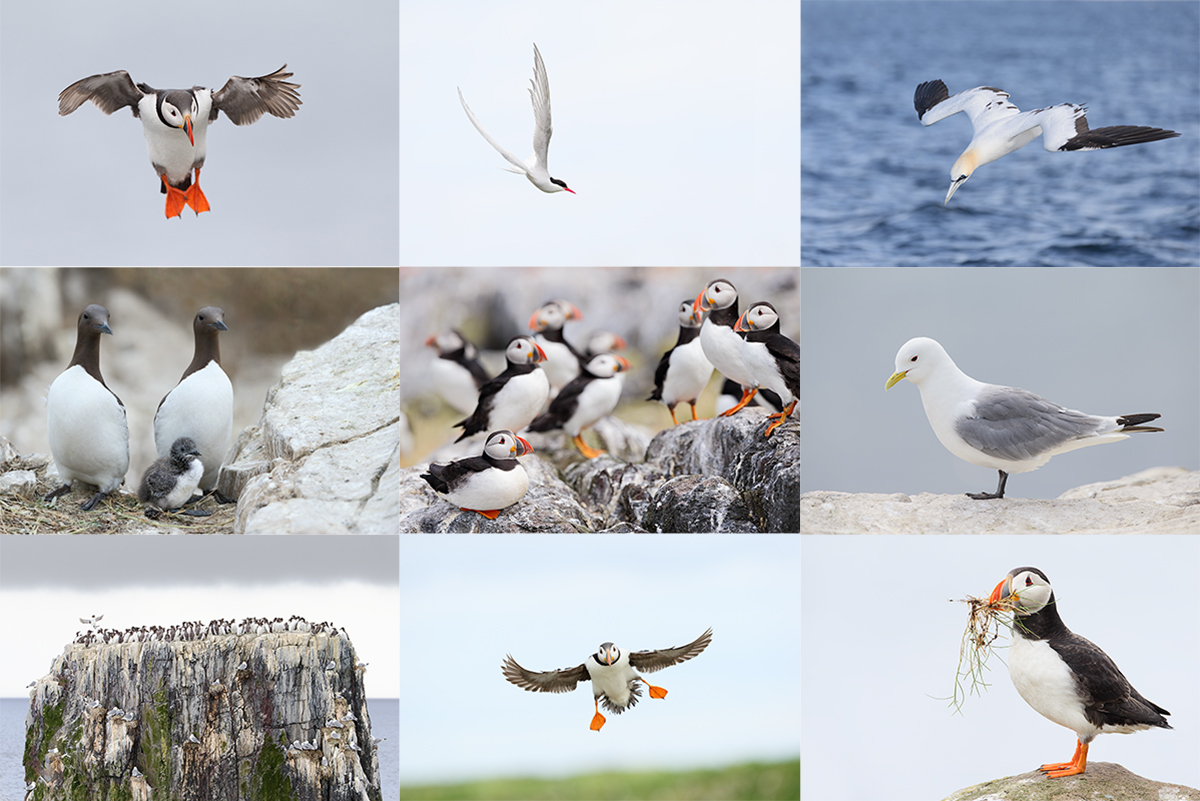
|
|
Images and card design copyright 2014: Arthur Morris/BIRDS AS ART. Click on the card to enjoy a spectacular larger version.
|
Facebook
Be sure to like and follow BAA on Facebook by clicking on the logo link upper right. Tanks a stack!
Support the BAA Blog. Support the BAA Bulletins: Shop B&H here!
We want and need to keep providing you with the latest free information, photography and Photoshop lessons, and all manner of related information. Show your appreciation by making your purchases immediately after clicking on any of our B&H or Amazon Affiliate links in this blog post. Remember, B&H ain’t just photography!
…..
Amazon Canada
Many kind folks from north of the border, ay, have e-mailed stating that they would love to help us out by using one of our affiliate links but that living in Canada and doing so presents numerous problems. Now, they can help us out by using our Amazon Canada affiliate link by starting their searches by clicking here. Many thanks to those who have written.
Typos
In all blog posts and Bulletins, feel free to e-mail or to leave a comment regarding any typos, wrong words, misspellings, omissions, or grammatical errors. Just be right. 🙂
August 2nd, 2014 The Streak Continues: 245
This post was published just after 8:00am from my Mom’s home in Holbrook, NY. I enjoyed another relaxing day here yesterday. I had a wonderful evening with long-time friend and Long Island photo buddy Tom Pfeifer. See “An Evening with the Bluebeats” immediately below. This post, which took me more than 3 hours to prepare, marks 245 consecutive days with a new enjoyable and educational blog post.
With so many folks getting in the habit of using our B&H links and our Amazon logo-links, why quit now? April, May, and June were fantastic. July was good. Lots of folks are getting the message: using my affiliate links does not cost you a penny and helps support my efforts here. To show your appreciation, I do ask that you use our B&H and Amazon affiliate links on the right side of the blog for all of your purchases. Please check the availability of all photographic accessories in the BIRDS AS ART Online Store, especially Gitzo tripods, Wimberley tripod heads, and the like. We sell only what I have used and tested, and know that you can depend on. We will not sell you junk. We know the tools that you need to make creating great images easy and fun. And we are always glad to answer your gear questions via e-mail.
You can find the following items in the store: Gitzo tripods, Mongoose M3.6 and Wimberley heads, plates, low feet, and accessories, flash brackets, , Delkin e-film Pro Compact Flash Cards, LensCoat products, and our unique line-up of educational materials including ABP I & II, Digital Basics, Site and Set-up e-Guides, Canon and Nikon Camera Users and AF e-Guides, and MP-4 Photoshop video tutorials among others.
I would of course appreciate your using our B&H affiliate links for all of your major gear, video, and electronic purchases. For the photographic stuff mentioned in the paragraph above we, meaning BAA, would of course greatly appreciate your business. Here is a huge thank you to the many who have been using our links on a regular basis and visiting the BAA Online store as well.
An Evening with the Bluebeats
Tom Pfeifer invited me to join him for an evening of music and fun and somewhat amazingly, I accepted. The evening began with a fine dinner at Skipper’s Pub down by the harbor in the quaint town of Northport, Long Island. We were joined by Tom’s wife Carleen, bird photographer Melissa Hahn & Joe Schmiemann, Tom and Carleen’s younger daughter Audrey & her friend Jess. Both of the fresh-faced young ladies are headed off to college next year.
The main course for the evening was the Ska/Rocksteady/Soul band, The Bluebeats. They were playing at a free event as part of the great Happenings on Main Street/Village of Northport program produced by Susan & Fred Richtberg. I had the pleasure of meeting the artistic directors Sandy & Steve Edwards. Ska, for those who like me never heard the term, is style of fast popular music having a strong offbeat and originating in Jamaica in the 1960s, a forerunner of reggae.
In short, the band was great. Lead vocalist and band leader Michael Drance was dynamic and sensational. His energy seemed limitless. Steve Prisco rocked on guitar. Mike and Steve go way back with Tom. The drummer Glenn Hackett got every number off to a great start and kept everyone in attendance either dancing or tapping their feet. His brother Jason Hackett on guitar was second in energy only to Mike. In third place was his very young daughter, perhaps 3 years old; she danced every number right up on stage with the band. Too cute. On keyboards were Ben Klingberg and the gorgeous Alison Tramontana whose smile and vocals lit up the entire park. Tom McGee, fabulous on bass guitar rounded out the group.
The band, from nearby Huntington, Long Island, is a local one. After the program I went up and thanked each member of the band for putting on such a great show. Each was genuinely appreciative. As Tom had said, “Just a bunch of good people having fun.” Amazed at the professional presentation I asked Mike’s son after the more than two hour show (in two sets) how often the band practiced. His answer, “Not as often as my Dad would like.”
In addition to the great music I was struck be the wonderful sense of community; it seemed as if everyone in attendance knew everyone else. Hugs and chatting ruled the evening. All in all I am glad that Tom invited me and even more glad that I went! You can hear some of The Bluebeats songs and learn a lot more about the band on their Reverb Nation page here.
|

|
|
This image was created on the Nickerson Baby Beach Nesting Birds IPT. I used the Gitzo 3532 LS carbon fiber tripod, the Mongoose M3.6 head, the Canon EF 600mm f/4L IS II USM lens, the Canon 1.4x EF Extender III (Teleconverter), and the Canon EOS-1D X. ISO 400. Evaluative metering +1 stop off the light blue sky 30 degrees up from the horizon at 6:37pm on a sunny afternoon with a touch of haze: 1/1600 sec. at f/6.3 in Manual mode. AWB.
Though 61-point/AI Servo Rear Focus AF selected the sensor one to the left of the central sensor and that sensor was nowhere near the bird the image was sharp on the eye; Go figure? AF was of course active at the moment of exposure. Click on the image to see a larger version.
Image #1: Black Skimmer On Final Approach
|
Sit or Stand?
In situations like the one above where beach nesting birds are landing near their nests in rather tall beach grass, the very best option is to sit behind your lowered tripod. Why? Acquiring focus with the subject against a sky background and then tracking the bird as the grass enters the bottom of the frame is far easier than acquiring focus with a grass background. While seated, the bird will be set against the sky far longer than when you are standing. In addition, if you do attempt to acquire focus with a grass background while seated the background will be that much farther from the subject than when standing thus making it easier to acquire focus and track the incoming subject.
To sum up, to photograph landing birds it is almost always best to sit on your butt. Make sure that the camera is right at face level and that you are comfortably seated close to your rig.
In situations like the one below where you are trying to photograph battling birds the very best option is to stand at full height behind your tripod. Why? Pointing the lens up while seated is far more difficult than pointing it up while standing tall. Make sure that the camera is at face level so that you do not have to stoop or bend over and make sure to take a comfortable stance close to your rig.
Summing up: in general it is best to sit for landing birds and to stand for battling birds (or for birds in flight above the horizon). A note on the latter: unless a bird is directly overhead it is almost always best not to photograph birds that are more than 30 degrees above the horizon…. Learn more on that on either of the Bosque IPTs.
Vast Contrast in Getting the Right Exposure
When working at ISO 400 and photographing skimmers in flight right on light angle in full sunny conditions, that is, with the birds no more than 15 degrees on either side of your shadow, meter the sky 30 degrees above the horizon and add 1/3 or 2/3 stop, set that exposure manually, check and evaluate the histogram, and then go with one or the other until the light levels change. This method of determining a good exposure will usually result in the following settings: 1/2500 or 1/2000 sec. at f/8 in very bright sunlight, or 1/2000 or 1/1600 sec in bright sunlight. Again, all at ISO 400.
With image #1 a bit of haze led me to add one full stop of light to the reading off the sky in the less than full sunny conditions. A check of the histogram revealed a perfect exposure.
With image #2, I needed to add 3 full stops of light to the meter reading of the very light grey sky in order to reveal detail in the BLACKs while maintaining detail in the WHITEs. Adding either 2 2/3 or 3 full stops in white sky conditions works like a charm but only 100% of the time….
The Exposure Question!
Why do you add only as little as 1/3 stop of light when working with blue skies but need to add as much as 3 stops of light when working with white skies?
The sky is blue only when the sun is out at full strength. The sky is light grey or white only when it is cloudy or overcast. Here is what you need to know: when the sun is out at full strength the meters in our cameras are pretty smart. When it is cloudy or overcast, the meters in our cameras are very dumb; if you do not learn to add a ton of light in the latter conditions your images will be severely underexposed. Your image files will be smaller and will contain less detail. And when you lighten the images either during conversion or in Photoshop you will be increasing noise. That is why we learn to expose to the right.
The Photoshop Question!
One of the two images presented here is pretty right out of camera. The other is a digital fabrication. Which is which? Please let us know why you made your choice and what type of alterations I made to the doctored image.
Your Favorite?
Please take a moment to leave a comment and let us know which of the two images here is your favorite. And do let us know why you made your choice.
Mastering Digital Exposure
Learning to master digital exposure is easy. Simply study the chapter on Exposure in the original The Art of Bird Photography (soft cover) and then follow that up by learning the material in the “Exposure Simplified” section of The Art of Bird Photography II (ABP II: 916 pages, 900+ images on CD only) and you will be able to come up with a very good exposure 100% of the time when you have a subject in the same light for more than 10 seconds…. It’s that simple.
Best news: buy both and save $10 here.
Join Denise Ippolito and me for four great days of photography and learning at one of our soul places. Please click on the card to enjoy a larger version.
Bosque del Apache 2014 BIRDS AS ART/A Creative Adventure Instructional Photo-Tour (IPT). NOV 29 (afternoon photo session)-DEC 3 (morning session), 2014. Totaling 4 FULL-DAYS: $1449. Leaders: Arthur Morris and Denise Ippolito. Introductory Slide program: 7:00pm on Saturday 11/29.
1 opening due to a recent cancellation
Tens of thousands of Snow Geese, 10,000 Sandhill Cranes, ducks, amazing sunrises, sunsets, and blast-offs. Live, eat, and breathe photography with two of the world’s premier photographic educators at one of their very favorite photography locations on the planet. Top-notch in-the-field and Photoshop instruction. This will make 21 consecutive Novembers at Bosque for artie. This will be denise’s 6th workshop at the refuge. Nobody knows the place better than artie does. Join us to learn to think like a pro, to recognize situations and to anticipate them based on the weather, especially the sky conditions, the light, and the wind direction. Every time we make a move we will let you know why. When you head home being able to apply what you’ve learned on your home turf will prove to be invaluable.
This workshop includes 4 afternoon (11/29 through 12/2), 4 morning (11/30 to 12/3) photography sessions, an inspirational introductory slide program after dinner on your own on Saturday, 11/29, all lunches, and after-lunch digital workflow, Photoshop, and image critiquing sessions.
There is never a strict itinerary on a Bosque IPT as each day is tailored to the local conditions at the time and to the weather. We are totally flexible in order to maximize both the photographic and learning opportunities. We are up early each day leaving the hotel by 5:30 am to be in position for sunrise. We usually photograph until about 10:30am. Then it is back to Socorro for lunch and then a classroom session with the group most days. We head back to the refuge at about 3:30pm each day and photograph until sunset. We will be photographing lots of Snow Geese and lots of Sandhill Cranes with the emphasis on expanding both your technical skills and your creativity.
A $449 non-refundable deposit is required to hold your slot for this IPT. Your balance, payable only by check, will be due on 7/25/2014. If the trip fills, we will be glad to apply a credit applicable to a future IPT for the full amount less a $100 processing fee. If we do not receive your check for the balance on or before the due date we will try to fill your spot from the waiting list. If your spot is filled, you will lose your deposit. If not, you can secure your spot by paying your balance.
Please print, complete, and sign the form that is linked to here and shoot it to us along with your deposit check (made out to “Arthur Morris.”) You can also leave your deposit with a credit card by calling the office at 863-692-0906. If you register by phone, please print, complete and sign the form as noted above and either mail it to us or e-mail the scan. If you have any questions, please feel free to contact me via e-mail.
Join Denise Ippolito and me for two great days of photography, fun, and learning at one of our soul places. We will surely be taking you out of the box on this workshop. Please click on the card to enjoy a larger version.
Bosque del Apache 2014 A Creative Adventure/BIRDS AS ART “Creative Photography Instructional Photo-Tour.” (IPT). NOV 24-25, 2014. 2-FULL DAYS: $729. Leaders: Denise Ippolito & Arthur Morris. Introductory Slide program: 7:00pm on Sunday 11/23.
Get Out of Your Box!
The Creative Bosque IPT is perfect for folks who want to learn to think outside the box, to create new and different images. This workshop is the perfect add-on for folks who are planning on attending the Festival of the Cranes. Learn to unleash your creative juices at the wondrous Bosque del Apache National Wildlife Refuge in San Antonio, New Mexico with two great leaders including the amazingly talented and creative Denise Ippolito. In-the-field instruction will include tips on gear set-up, on creating a variety of pleasing blurs, on getting the right exposure, and on designing pleasing images. And lots more. From vertical pan blurs to subject motion blurs to zoom blurs to multiple exposures we will cover it all. If conditions are perfect, we will not hesitate to take advantage of them to do some traditional bird photography. This workshop will include an inspirational introductory slide program on Sunday evening, 11/23, after dinner on your own, two morning and two afternoon photography sessions, all lunches, a digital workflow and Photoshop session after lunch on Monday, and an image critiquing session after lunch on Tuesday.
A $329 non-refundable deposit is required to hold your slot for this IPT. Your balance, payable only by check, will be due on 7/25/2014. If the trip fills, we will be glad to apply a credit applicable to a future IPT for the full amount less a $100 processing fee. If we do not receive your check for the balance on or before the due date we will try to fill your spot from the waiting list. If your spot is filled, you will lose your deposit. If not, you can secure your spot by paying your balance.
Please print, complete, and sign the form that is linked to here and shoot it to us along with your deposit check (made out to “Arthur Morris.”) You can also leave your deposit with a credit card by calling the office at 863-692-0906. If you register by phone, please print, complete and sign the form as noted above and either mail it to us or e-mail the scan. If you have any questions, please feel free to contact me via e-mail.
Facebook
Be sure to like and follow BAA on Facebook by clicking on the logo link upper right. Tanks a stack!
Support the BAA Blog. Support the BAA Bulletins: Shop B&H here!
We want and need to keep providing you with the latest free information, photography and Photoshop lessons, and all manner of related information. Show your appreciation by making your purchases immediately after clicking on any of our B&H or Amazon Affiliate links in this blog post. Remember, B&H ain’t just photography!
…..
Amazon Canada
Many kind folks from north of the border, ay, have e-mailed stating that they would love to help us out by using one of our affiliate links but that living in Canada and doing so presents numerous problems. Now, they can help us out by using our Amazon Canada affiliate link by starting their searches by clicking here. Many thanks to those who have written.
Typos
In all blog posts and Bulletins, feel free to e-mail or to leave a comment regarding any typos, wrong words, misspellings, omissions, or grammatical errors. Just be right. 🙂
August 1st, 2014 The Streak Continues: 244
This post was published just before 8:00am from my Mom’s home in Holbrook, NY. I had a relaxing day yesterday and spent a lot of time watching multiple episodes of American Pickers with my Mom. That made her very happy. I enjoyed a nice swim in the community pool just before dinner. My Mom mentioned a hankering for some calves liver so I ran down to King Cullen to get some. I had not partaken in many years and neither had she. Sauteed medium rare with vidalia onions we enjoyed a sumptuous feast. This post, which took me more than 3 hours to prepare, marks 244 consecutive days with a new enjoyable and educational blog post.
With so many folks getting in the habit of using our B&H links and our Amazon logo-links, why quit now? April, May, June, and July have been fantastic as lots of folks are getting the message; using my affiliate links does not cost you a penny and helps support my efforts here. To show your appreciation, I do ask that you use our B&H and Amazon affiliate links on the right side of the blog for all of your purchases. Please check the availability of all photographic accessories in the BIRDS AS ART Online Store, especially Gitzo tripods, Wimberley tripod heads, and the like. We sell only what I have used and tested, and know that you can depend on. We will not sell you junk. We know the tools that you need to make creating great images easy and fun. And we are always glad to answer your gear questions via e-mail.
You can find the following items in the store: Gitzo tripods, Mongoose M3.6 and Wimberley heads, plates, low feet, and accessories, flash brackets, , Delkin e-film Pro Compact Flash Cards, LensCoat products, and our unique line-up of educational materials including ABP I & II, Digital Basics, Site and Set-up e-Guides, Canon and Nikon Camera Users and AF e-Guides, and MP-4 Photoshop video tutorials among others.
I would of course appreciate your using our B&H affiliate links for all of your major gear, video, and electronic purchases. For the photographic stuff mentioned in the paragraph above we, meaning BAA, would of course greatly appreciate your business. Here is a huge thank you to the many who have been using our links on a regular basis and visiting the BAA Online store as well.
Denise Ippolito Nickerson Beach Workshop ~ Saturday & Sunday August 23-24th, $699.00
One great leader! See below for details. Please let Denise know that you learned of this workshop through BIRDS AS ART. Click here and scroll down to register.
Used Canon 400 DO IS USM Lens
Price slashed $450!
Joe Messina is offering a used Canon 400 DO IS USM lens in very good ++ condition for 3750! There are some minor cosmetic scratches to the finish. The lens hood is slightly out of round and is difficult to install. The sale includes an AquaTech flexible strap-on hood, a $150 value. The sale also includes the lens trunk (with key), the original leather hood, and a hard plastic lens cap. The seller will pay insured UPS shipping within continental US. The lens will ship after the check clears.
Please contact Joe via e-mail or by phone at 415-563-6577.
If you are looking for a fast, lightweight, hand holdable telephoto lens, this is the lens for you. Learn a ton more about the 400 DO here and see lots of 400 DO images by visiting the “The Canon 400mm f/4 IS DO Lens: Fourteen Images that Prove that the Internet Experts are (As Usual) Idiots” blog post here. The lens sells new at B&H for $6499.00.
See more great used gear deals here.
|
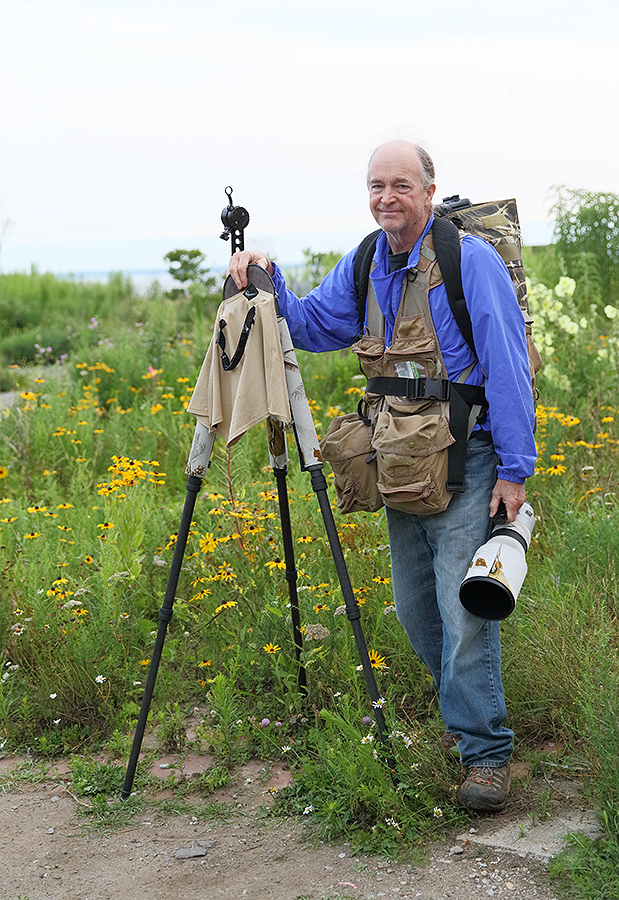
|
|
This image was created on July 30, 2014 at Great Gull Island, NY with the Canon EF 24-70mm f/2.8L II USM lens (hand held at 50mm) and the Canon EOS-1D X. ISO 400. Evaluative metering -1/3 stop (was an intentional under-exposure): 1/250 sec. at f/3.5 in Tv mode. AWB.
Three sensors above and 1 to the right of the central sensor/AI Servo/Single Point AF (as originally framed) was active at the moment of exposure. Click on the image to see a larger version and see how old and grizzled I am looking. 🙂
Image courtesy of and copyright 2014: GGI tern radar research assistant Maria Andersen.
|
The Root of My Right Shoulder Problems
This coming August 7 will mark 31 years with a long lens; I purchased my first telephoto, the Canon 400mm f/4.5 FD (manual focus) lens on August 7, 1983. I still have that receipt. For many of those years I carried a big heavy lens–some weighing 14 pounds–on my right shoulder on a tripod that weighed as much as 8 pounds along with a 3-4 pound camera body. That with my right arm in the stress position, parallel to the ground. When the range of motion in my shoulder joint became severely restricted about 10 years ago and my shoulder began to ache, I learned that the “classic” way of carrying a big lens on a tripod was the worst possible way to do it, a way designed to inflict serious damage to your right shoulder.
After that, I began switching shoulders every now and then (even though it seemed much more natural to use the right shoulder than to use the left shoulder). And in time, I came up with a slightly improved method that I will share with you here at some point. In the meantime, the damage had been done: impingement and atrophy of various rotator cuff muscles, adhesive capsulitis, arthritis–call it what you like, it still hurts. After the first shoulder episode I rehabbed the shoulder with Aaron Mattes’ Isolated Active Stretching techniques. My shoulder was fine but I continued to punish my shoulder by carrying the tripod with a big lens on my shoulders. After the next major episode–at worst I could not raise my right arm above my waist, I started Active Release chiropracty and had a good deal of relief. I am currently employing a variety of alternative techniques to keep the wolf at the door….
I Could Not Have Survived Great Gull…
I simply could not have survived Great Gull without my 4Xpandable Long Lens Bag from LensCoat. For the most part at GGI I needed to get my gear to a given location, usually one about 1/4 mile from headquarters, and then set up shop by finding a good spot in the rocks, erecting the tripod, mounting the 600 II/1D X rig, and covering up with my Kwik-Camo Summer Weight Throw-over Blind (see photo next).
A while back, I asked my friend and health guru, the brilliant Dr. Cliff Oliver of the Center for Balance in San Diego, CA, “Would it be best for me to carry the big lens in one hand and the tripod in the other?” He answered, “It would be better than what you have been doing for the past 3 decades but would still be less than ideal. Perfect would be some sort of lens bag or backpack with shoulder straps and a waist harness. On Great Gull I had my first chance to try out Scott Elowitz’s 4Xpandable Long Lens Bag. In short, the results of this experiment were miraculous. Continue reading for additional details and for tips on using this great new LensBag.
|
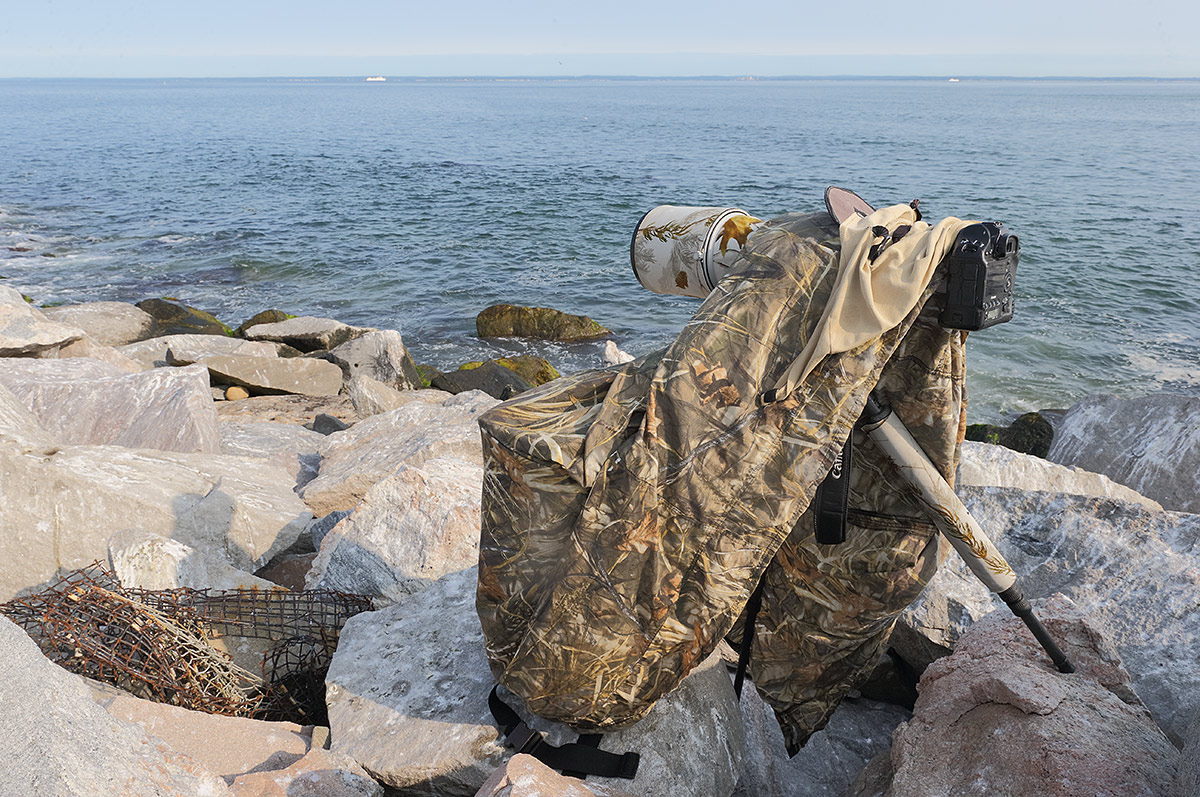
|
|
This image was also created on July 30, 2014 (sidelit in full, harsh sun at 8:40am) at Great Gull Island, NY with the Canon EF 24-70mm f/2.8L II USM lens (this time hand held at 24mm) and the Canon EOS-1D X. ISO 400. Evaluative metering +2/3 stop: 1/1250 sec. at f/13 in Tv mode. AWB.
Four sensors to the right of the central sensor AI Servo Surround/Rear Focus AF as framed was active at the moment of exposure. Click here to see the latest version of the Rear Focus Tutorial. Click on the image to see a larger version and see how old I am looking. 🙂
Note that I stood the 4X Lens Bag up inside the Kwik-Camo Blind to support the left side of the blind.
|
Once I figured out the best way to get the bag with the 600 II and the 1D X on my back and adjusted the various harness straps to perfection carrying the rig around Great Gull was a dream. As Dr. Dr. (my long time nickname for Cliff Oliver) had stated, there was no stress at all on either shoulder. (Once I began switching shoulders I began to have some problems with my left shoulder; the left is fine right now….) Be sure to fasten and snug up the waist belt; the one time that I forgot to do that my load seemed a lot heavier. Yes, your big lens will not be available instantly should something great happen right in front of you but at this stage of my career carrying the lens on a tripod on my shoulder is no longer a viable option.
On most forays into the field I opted not wear my Xtrahand Vest from Vested Interest. (Please e-mail for more info on my Custom designed Magnum vest.) For most sessions I carried the big lens with the camera body attached on my back and had the 300 II with my 2nd 1D X on slung over my left shoulder via an RS-7 Black Rapid Strap. My teleconverters were always in a fanny pack. The tripod with my beloved Mongoose M3.6 was always carried in one hand. Toward the end of the trip I began carrying the 24-70mm/1D X on the RS-7 Black Rapid Strap, the tripod in one hand, and the 300 II alone in the other hand. If large groups of terns took flight in front of me I was able to quickly put the tripod and the 300 II on the ground and begin photographing. On what turned out to be my last morning I wanted to bring a few extra lenses along including the 24-70, the 15mm fisheye, and the 100 macro so I wore the vest. The vest works well in conjunction with the 4Xpandable Long Lens Bag as long as you do not put anything substantial in the rear pouch.
Observant readers might have noticed in the opening image that I was not using the top cover of the LensBag; I had inadvertently left it in my Mom’s garage. That actually turned out to be a plus as I was able to get the big rig out of the bag quickly. I would of course want the top cover in place if there was a chance of rain. After placing the big rig in the bag I would stuff the Kwik-Camo Summer Weight Throw-over Blind into the bag around the lens; this served as additional protective padding and left the blind easily accessible. On occasion, I would place a small lens or two into the LensBag each in a woolen watch cap before I stuffed in the blind.
It is important to shorten the straps so that the LensBag fits you snugly. I shortened the shoulder straps to the point where it was a slight struggle to get my left arm into the left shoulder strap. In addition, I shortened the straps at the top of the shoulder harnesses where they attached to the LensBag; this prevented the bag from wiggling about. As I mentioned above, with everything set up just right carrying the big lens with the 1D X in place was a dream.
In short, the 4Xpandable Long Lens Bag will lengthen my career by years.
Learn lots more about the 4Xpandable Long Lens Bag it’s smaller cousin, the 3Xpandable Long Lens Bag, and the various straps and harnesses by clicking here and scrolling down.
Important Request
If you are inspired to order one of the Xpandable LensBags after reading this post, please, please pretty please purchase yours through the BIRDS AS ART Online Store (and NOT from our friends at B&H) by using the following links/same great gear, same low prices:
The Two New Expandable LensBags/please scroll down for details
3Xpandable Long Lens Bag
4Xpandable Long Lens Bag
Expandable Bag Accessories/please scroll down for details
Universal Harness for either Expandable Long Lens Bag
The Lenscoat Waistbelt
The DPP RAW Conversion Guide
I tried something new when converting the opening image in DPP. I moved the Highlight slider 3 clicks to the left and the Shadow slider 2 clicks to the right; this reduced the contrast nicely without greying out the highlights and opened up the shadows without adding much noise. In addition, checking the box for Distortion under Lens aberration correction completely eliminated the curved horizon due to barrel distortion. To learn why I use Canon’s Digital Photo Professional (DPP) 3.14 to convert every image that I work on, click here.
Coming soon: the DPP 4.0 RAW Conversion Guide by Arash Hazeghi with Arthur Morris. I will be starting to use DPP 4.0 this week as I get into editing the new guide.
|

|
|
Images and card design by Denise Ippolito/A Creative Adventure
|
Denise Ippolito Nickerson Beach Workshop ~ Saturday & Sunday August 23-24th, $699.00 includes 4 photo sessions and 2 Image Review/ Photoshop sessions.
One great leader! Please let Denise know that you learned of this workshop through BIRDS AS ART. Click here and scroll down to register.
From Denise
There is just too much going on at Nickerson to stay away. I have decided to do a 2-day workshop at Nickerson Beach this August. By then lots of the Black Skimmer chicks will be hatched and there should also be plenty of action! The skimmers are lots of fun to photograph in flight, especially when they battle. We should also have good opportunities to photograph American Oystercatcher, Common Tern and maybe even some Least Terns and Piping Plovers. I will do my very best to get the group in position to capture great images. I will share with you my flight techniques and my techniques on getting you close to your subject. I will help you to recognize good situations and become a better bird photographer. This workshop needs 6 participants.
Saturday Schedule: 5:45am- 9:45am morning photography session, Lunch Break – Photoshop/Image Review, Gear and Camera settings session, Afternoon Break, 4:30pm- 7:30pm afternoon photography session.
Sunday Schedule: 5:45am- 9:45am morning photography session, Lunch Break- Photoshop/Image Review, Afternoon Break, 4:30pm- 7:30pm afternoon photography session.
We will photograph in the morning on Saturday, then break for an early lunch (included in the price). During lunch we will do image review and Photoshop lessons. After lunch I will go over gear handling tips and camera settings with the group. Then we will take an afternoon rest. This will give you time to download your images and have some time to yourself before we head back out in the late afternoon/early evening. Sunday we will wake up and have basically the same schedule as Saturday. This schedule is subject to change depending on conditions and wildlife. 🙂
Gear Suggestions:
I recommend that you bring your longest lens. If that is a 70-200mm lens than you will need a teleconvertor. You should have at the very least 400mm of focal length. A sturdy tripod- preferably w/o a center column. A complete list of gear recommendations as well as hotel recommendations and general information sheet will be provided at sign up.
Please contact Denise via e-mail with any questions.
Facebook
Be sure to like and follow BAA on Facebook by clicking on the logo link upper right. Tanks a stack!
Support the BAA Blog. Support the BAA Bulletins: Shop B&H here!
We want and need to keep providing you with the latest free information, photography and Photoshop lessons, and all manner of related information. Show your appreciation by making your purchases immediately after clicking on any of our B&H or Amazon Affiliate links in this blog post. Remember, B&H ain’t just photography!
…..
Amazon Canada
Many kind folks from north of the border, ay, have e-mailed stating that they would love to help us out by using one of our affiliate links but that living in Canada and doing so presents numerous problems. Now, they can help us out by using our Amazon Canada affiliate link by starting their searches by clicking here. Many thanks to those who have written.
Typos
In all blog posts and Bulletins, feel free to e-mail or to leave a comment regarding any typos, wrong words, misspellings, omissions, or grammatical errors. Just be right. 🙂
July 31st, 2014 The Streak Continues: 243
This post was published just after 7:00am from my Mom’s home in Holbrook, NY. I had the chance to leave Great Gull Island a day early and having done so well there, I hit the road. I made the 4:00pm New London/Orient Point ferry without a reservation with one minute to spare. I was the last car on the boat. Lucky, lucky! This post, which took me more than 2 hours to prepare, marks 243 consecutive days with a new enjoyable and educational blog post.
With so many folks getting in the habit of using our B&H links and our Amazon logo-links, why quit now? April, May, June, and July have been fantastic as lots of folks are getting the message; using my affiliate links does not cost you a penny and helps support my efforts here. To show your appreciation, I do ask that you use our B&H and Amazon affiliate links on the right side of the blog for all of your purchases. Please check the availability of all photographic accessories in the BIRDS AS ART Online Store, especially Gitzo tripods, Wimberley tripod heads, and the like. We sell only what I have used and tested, and know that you can depend on. We will not sell you junk. We know the tools that you need to make creating great images easy and fun. And we are always glad to answer your gear questions via e-mail.
You can find the following items in the store: Gitzo tripods, Mongoose M3.6 and Wimberley heads, plates, low feet, and accessories, flash brackets, , Delkin e-film Pro Compact Flash Cards, LensCoat products, and our unique line-up of educational materials including ABP I & II, Digital Basics, Site and Set-up e-Guides, Canon and Nikon Camera Users and AF e-Guides, and MP-4 Photoshop video tutorials among others.
I would of course appreciate your using our B&H affiliate links for all of your major gear, video, and electronic purchases. For the photographic stuff mentioned in the paragraph above we, meaning BAA, would of course greatly appreciate your business. Here is a huge thank you to the many who have been using our links on a regular basis and visiting the BAA Online store as well.
Used Photography Gear
Sales continue at a ridiculous pace. After selling two 300 IIs and a 500 II over the weekend, Steve Ellis’s used Nikkor 28-300mm 3.5-5.6 G ED VR lens sold yesterday. There are still some great lenses and an EOS-1D Mark III listed. You can see what is available by clicking here. I will be adding a new item or two later today and there is a chance that there will be a 400 II coming up soon….
New Listing: Used Canon EF 100-400 f 4.5-5.6 L IS Lens
Bruce Boswell is offering a used Canon EF 100-400 f 4.5-5.6 L IS lens in very good condition for $999 plus insured shipping via UPS Ground to US Continental addresses only. The tripod and zoom rings have a few minor blemishes. The sale includes: the original case, the front and rear caps, the lens hood, and the lens manual. Your gear will be shipped only after your check clears.
Please contact Bruce via e-mail ourpals5@msn.com or by phone at (309) 451-1506 or (309) 530-8493 (cell) (Central).
The 100-400 is a versatile intermediate telephoto zoom lens with 1,000+ uses. This one is priced to sell.
I Am Not Very Good At Mini-Landscapes…
Though I like the optimized image above, I must admit to not being very good at creating mini-landscapes at Keukenhoff Gardens in Lisse, Holland, The Netherlands. We arrive very early and get right into the gardens so that we can lessen the chance of having people in the images. Another problem that we all face is the fact that there may be signs, benches, or lampposts in your images. At times you can hide such distractions behind a cooperative tree by moving your tripod left or right a bit, that is, by choosing the very best perspective…. I also find it hard to know just where to cut the inevitable tree trunks….
What Do You Think?
Do you like this image? Why or why not?
What’s Different?
Take a close look at the animated GIF above. How many differences can you see in the original images and the optimized image? As almost always I used the Clone Stamp Tool, the Spot Healing Brush, and a series of small Quick Masks for the image clean-up. I did extensive work with the Clone Stamp Tool (S) always using Denise Ippolito’s Protective Cloning on a Layer technique where you add a Layer Mask to touch up the Clone Stamp Work that you did on a new layer.
Can you find the person that was cloned out? Can you find the sign that was cloned out? What other changes can you spot? There are lots of them?
The DPP RAW Conversion Guide
To learn why I use Canon’s Digital Photo Professional (DPP) 3.14 to convert every image that I work on, click here.
Digital Basics
Everything that I did to optimize today’s images are detailed in my Digital Basics File–written in my easy-to-follow, easy-to-understand style. Are you tired of making your images look worse in Photoshop? Digital Basics File is an instructional PDF that is sent via e-mail. It includes my complete digital workflow, dozens of great Photoshop tips, the use of Contrast Masks, several different ways of expanding and filling in canvas, all of my time-saving Keyboard Shortcuts, Quick Masking, Layer Masking, and NIK Color Efex Pro basics, my killer image clean-up techniques, Digital Eye Doctor, creating time-saving actions, and lots more.
APTATS I & II
Learn the details of advanced Quick Masking techniques in APTATS I. Learn Advanced Layer Masking Techniques in APTATS I. Mention this blog post and apply a $5 discount to either with phone orders only. Buy both APTATS I and APTATS II and we will be glad to apply at $15 discount with phone orders only. Please call Jim or Jennifer at 863-221-2372 on Tuesday to order.
Facebook
Be sure to like and follow BAA on Facebook by clicking on the logo link upper right. Tanks a stack!
|

|
|
Denise and artie hope that you can join them next spring in Holland and learn to improve both the technical and creative aspects of your flower (and street) photography.
|
7 1/2-Day/8-Night: A Creative Adventure/BIRDS AS ART/Tulips & A Touch of Holland Instructional Photo-Tour (IPT)
Keukenhof—Delft—Amsterdam–Flower Fields—Kinderdijk
April 9 -April 16, 2015: $4995. Limit: 12 photographers/Openings 10. Four more to make the trip a go.
This trip needs 6 registrants to run so please do not purchase your plane tickets until you hear from us that the trip is a go.
Join Denise Ippolito, the author of “Bloomin’ Ideas,” and Arthur Morris, Canon Explorer of Light Emeritus, for a great trip to Holland in mid-April 2015. Day 1 of the IPT will be April 9, 2015. We will have a short afternoon get-together and then our first photographic session at the justly-famed Keukenhof. Our last day, Day 8, April 16 will be a full day of photography.
The primary subjects will be tulips and orchids at Keukenhof and the spectacularly amazing tulip, hyacinth, and daffodil bulb fields around Lisse and points north. We will spend one full day in Amsterdam. There will be optional visits to the Van Gogh Museum, the Anne Frank House and/or the Rijk’s Museum. Street photography and sightseeing will be other options. We will spend a half day at Kinderdijk where we will be photographing the windmills and doing some creative photography. We will spend an afternoon in the lovely Dutch town of Delft where we will do some street photography and shopping. There is an optional church tower tour/climb. We will also enjoy a superb fine dining experience in a traditional restaurant.
Other than the arrival date: April 9, Day 1, and the date of our last day of photography on April 16, Day 8, there is no set itinerary. We will check the weather and play everything by ear to maximize the photographic opportunities. We will try to do Amsterdam, Delft, and especially Kinderdijik, on cloudy days.
There are several huge pluses to this trip. First off, denise is an amazingly skilled and caring instructor. Both her creativity and her willingness to share and to help beginning and intermediate photographers are unmatched. And though artie has learned a ton about flower photography from denise, their styles and techniques do vary considerably. You will have a chance to be counseled by and to learn from both of them. While denise will hunt you down to help you, artie’s teaching style is more “the closer you stay to me, the more you will learn.” Both leaders consistently inspire the participants. And each other. The sky, of course, is the limit.
You will learn to create tight abstracts, how best to use depth-of-field (or the lack thereof) to improve your flower photography, how to get the right exposure and make sharp images every time, how to see the best shot, and how to choose the best perspective for a given situation. And you will of course learn to create a variety of pleasingly blurred flower images. If you bring a long lens, you will learn to use it effectively for flower photography. Denise’s two favorite flower lenses are the Canon EF 100mm f/2.8L Macro IS USM lens and the Canon EF 24-105mm f/4L IS USM lens. Mine are the Canon 100mm f/2.8L IS macro , the Canon EF 180mm f/3.5L Macro USM lens ,and the Canon EF 300mm f/2.8L IS II USM lens, all almost always on a tripod. Often with extension tubes and/or either the 1.4X or the 2X (with the 300 II) teleconverters. Denise hand holds a great deal of the time. For flower field blurs denise uses the same lenses mentioned above along with her new 70-200mm f/2.8L IS III lens. Artie’s favorite is that same 70-200 often with a 1.4X TC but he uses both the new Canon EF 24-70mm f/2.8L II USM lens and the 300 II as well. Both of us use and love the Canon EOS 5D Mark IIIfor all of our flower photography. The in-camera HDR and Multiple Exposure features are a blast.
One of the great advantages of our trip is that we will be staying in a single, strategically located hotel that is quite excellent. Do note that all ground transfers to and from Schipol Airport will be via the free hotel shuttle bus.
What’s included: Eight hotel nights. All ground transportation except for airport transfers as noted above. In-the-field instruction and small group image review and Photoshop sessions. All meals from dinner on Day 1 through dinner on Day 8. There is good food at the hotel and we will be dining there on occasion; whenever you order off the menu be it at the hotel or at another restaurant only the cost of your main course is included. On these occasions the cost of soups, appetizers, salads, sodas and other beverages, alcoholic drinks and wine, bottled water, and desserts are not included. Snacks, personal items, phone calls, etc. are also not included. The cost of bus or train transportation to and from Amsterdam (about $20 US), museum entry, and tower and church entry fees (optional) are likewise not included.
Beware of seemingly longer, slightly less expensive tours that include travel days and days sitting in the hotel doing nothing as part of the tour. In addition, other similar trips have you changing hotels often and needlessly. One final note on other similar trips: the instructors on this trip actually instruct. On other similar trips the instructors, though usually imminently qualified, serve for the most part as van drivers and van door openers.
A non-refundable deposit of $1,000 per person is required to hold your spot. The second payment of $2,000 due by October 30, 2014. The balance is due on January 15, 2015. Payments in full are of course welcome at any time. All payments including the deposit must be by check made out to “Arthur Morris.” As life has a way of throwing an occasional curve ball our way, you are urged to purchase travel insurance within 15 days of our cashing your check. Artie uses and recommends Travel Insurance Services. All payments are non-refundable unless the trip fills to capacity. In that case, all payments but your deposit will be refunded. If the trip does not run every penny will of course be refunded. Again, please do not purchase your air tickets until you hear from us that the trip is a go. We are very confident that it will.
All checks should be made out to “Arthur Morris” and sent to: Arthur Morris, PO Box 7245, Indian Lake Estates, FL 33855. Call Jim or Jen in the BAA office with any additional registration questions: 863-692-0906.
For couples or friends signing up at the same time for the tulip trip, a $200/duo discount will be applied to the final payment.
When you send your deposit check, please print, sign, and include the paperwork here.
If you have any questions on the trip please contact artie by e-mail or denise by e-mail.
Support the BAA Blog. Support the BAA Bulletins: Shop B&H here!
We want and need to keep providing you with the latest free information, photography and Photoshop lessons, and all manner of related information. Show your appreciation by making your purchases immediately after clicking on any of our B&H or Amazon Affiliate links in this blog post. Remember, B&H ain’t just photography!
…..
Amazon Canada
Many kind folks from north of the border, ay, have e-mailed stating that they would love to help us out by using one of our affiliate links but that living in Canada and doing so presents numerous problems. Now, they can help us out by using our Amazon Canada affiliate link by starting their searches by clicking here. Many thanks to those who have written.
Typos
In all blog posts and Bulletins, feel free to e-mail or to leave a comment regarding any typos, wrong words, misspellings, omissions, or grammatical errors. Just be right. 🙂
July 30th, 2014 The Streak Continues: 242
This post was published just before 5:45am from Great Gull Island Project, NY. As noted yesterday, strong NW winds in the morning found me at work at my laptop all morning before heading for another wonderful midday swim. The afternoon was again quite excellent but I lost the last hour of golden light and blue water that I had enjoyed on Tuesday. It is still this morning with a gentle breeze from the east northeast, in other words, perfect for bird photography. I am going to head for the western end of the island in an attempt to photograph some of the large flocks of terns feeding. This post, which took me more than 2 1/2 hours to prepare, marks 242 consecutive days with a new enjoyable and educational blog post.
With so many folks getting in the habit of using our B&H links and our Amazon logo-links, why quit now? April, May, June, and July have been fantastic as lots of folks are getting the message; using my affiliate links does not cost you a penny and helps support my efforts here. To show your appreciation, I do ask that you use our B&H and Amazon affiliate links on the right side of the blog for all of your purchases. Please check the availability of all photographic accessories in the BIRDS AS ART Online Store, especially Gitzo tripods, Wimberley tripod heads, and the like. We sell only what I have used and tested, and know that you can depend on. We will not sell you junk. We know the tools that you need to make creating great images easy and fun. And we are always glad to answer your gear questions via e-mail.
You can find the following items in the store: Gitzo tripods, Mongoose M3.6 and Wimberley heads, plates, low feet, and accessories, flash brackets, , Delkin e-film Pro Compact Flash Cards, LensCoat products, and our unique line-up of educational materials including ABP I & II, Digital Basics, Site and Set-up e-Guides, Canon and Nikon Camera Users and AF e-Guides, and MP-4 Photoshop video tutorials among others.
I would of course appreciate your using our B&H affiliate links for all of your major gear, video, and electronic purchases. For the photographic stuff mentioned in the paragraph above we, meaning BAA, would of course greatly appreciate your business. Here is a huge thank you to the many who have been using our links on a regular basis and visiting the BAA Online store as well.
|
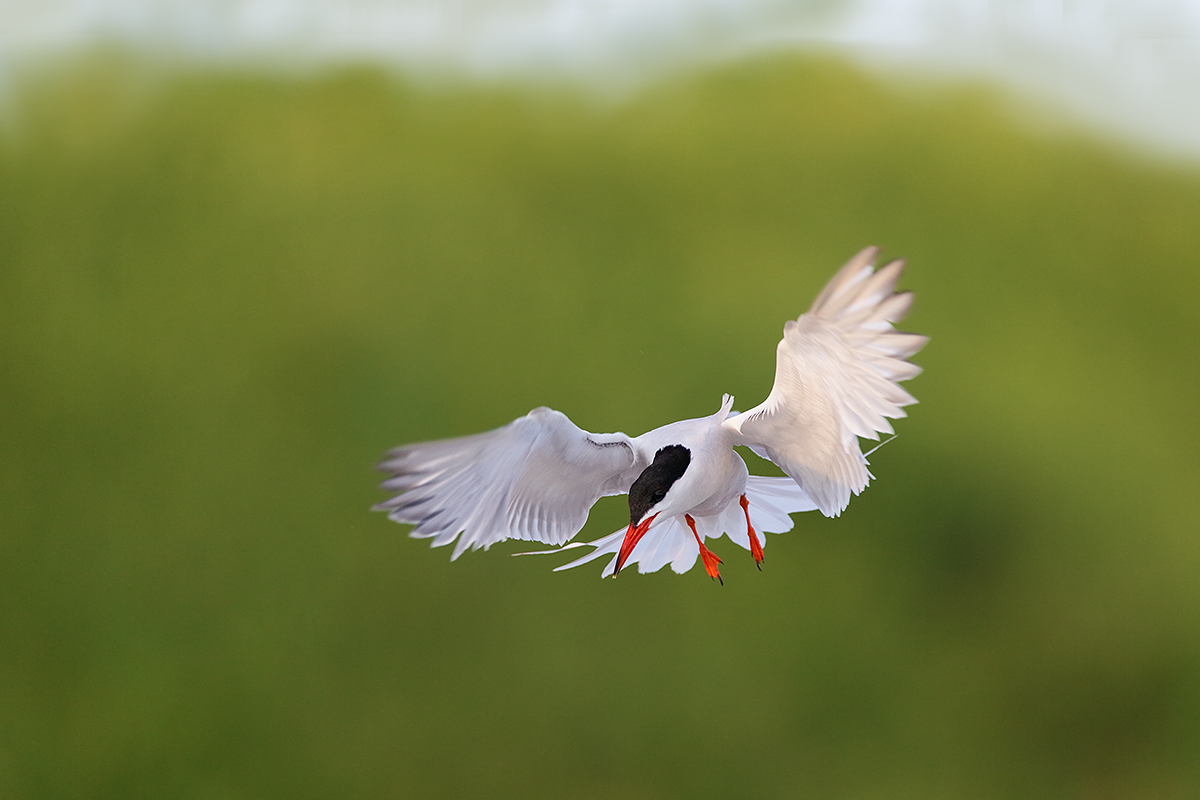
|
|
This image was created on the evening of July 28 at 7:20pm on Great Gull Island when a huge dark cloud covered the sun. I used the hand held Canon EF 300mm f/2.8L IS II USM lens, Canon Extender EF 1.4X III, and the Canon EOS-1D X. ISO 800. Evaluative metering +2 2/3 stops off the very light blue sky: 1/1600 sec. at f/4 in Manual mode. AWB.
One sensor below the central sensor AI Servo/Center Zone AF caught the bird’s right foot and again the eye was very sharp. Again, AF was active at the moment of exposure. Click on the image to see a larger version.
|
My Two Favorite Images From a 1362 Image Day on Great Gull Island…
As I mentioned yesterday, Monday afternoon past was positively magical. I did a lot of flight photography and with the last half hour of golden light, tried a new spot at the eastern end of the island that proved to be fantastic as I had imagined the previous evening. I started at abut 5:00pm, earlier than I had previously; that gave me time to explore some new areas that panned out quite nicely.
Seeing the Situation
Each of these images was made possible only because I recognized the potential of the two completely different situations and realized the possibilities. While it is possible to learn to do that by studying the blog every day, the very best way to do that is to join an IPT. Learn more and commit to become a better photographer today by clicking here.
|
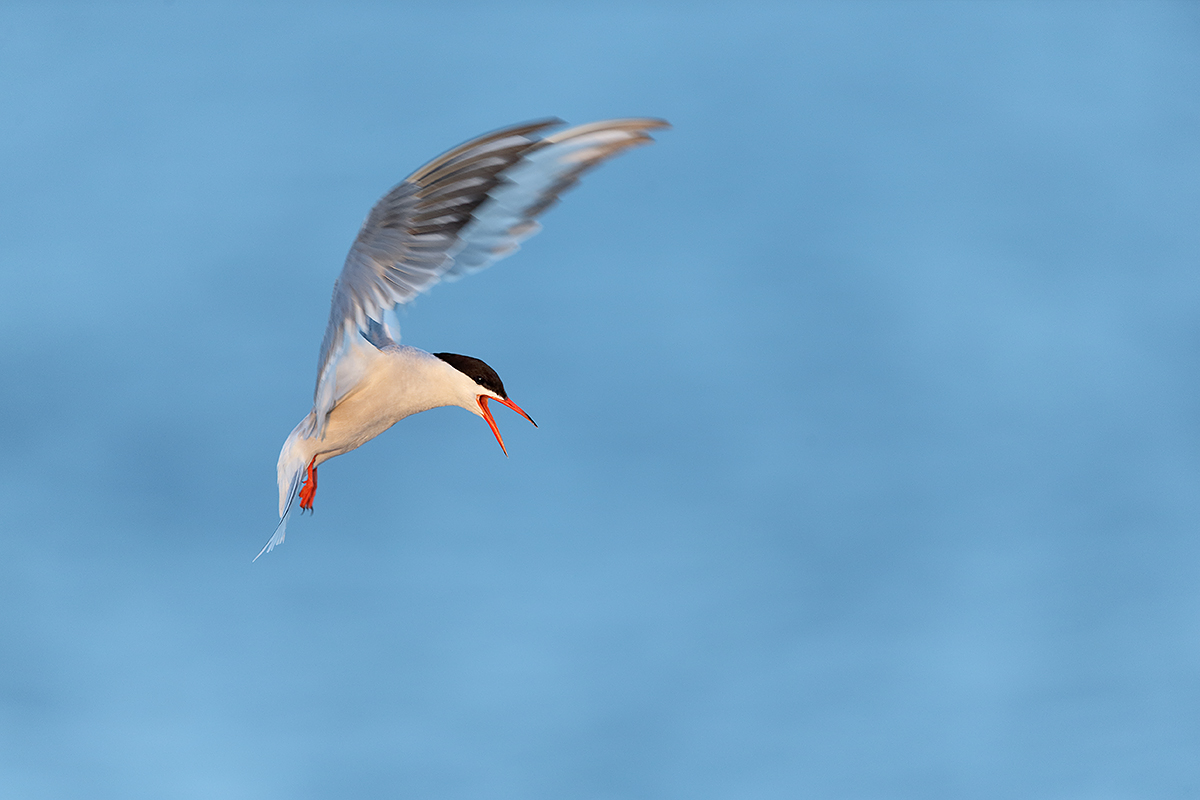
|
|
This image was created with the Gitzo 3532 LS carbon fiber tripod, the Mongoose M3.6 head, the Canon EF 600mm f/4L IS II USM lens and the Canon EOS-1D X. ISO 800. Evaluative metering +2/3 stop as originally framed (this is a small crop): 1/1000 sec. at f/4 in Av mode. AWB.
Though 61-Point Automatic Selection/AI Servo/Rear Focus AF activated a single point well below the bird’s neck the image was very sharp on the eye. AF was of course active at the moment of exposure. Learn everything that I know about the great AF systems of the 1D X and 5D III including how to manage the various AF Area Selection Modes, when to use which one, and several ways to move the AF sensor around in the 1D X AF Guide and the 5D Mark III User’s Guide. Click here to see the latest version of the Rear Focus Tutorial. Click on the image to see a larger version.
|
Funny How Some Things Never Change…
In The original The Art of Bird Photography I wrote something to the effect that my two favorite backgrounds were distant out-of-focus green vegetation and still blue water lit by richly colored light….
Av Mode
I was in Av mode for the second image because some of the rock perches were in the shade while others were lit by warm evening light. Working in Av mode let me adjust quickly by adding 2/3 stop of light for the birds in the sun or 1 or 1 1/3 stop of light for the birds in the shade among the white rocks. As I have said many times, sometimes Av mode is faster and more efficient.
Image Questions
What is the one thing that bugs me in one of the two images? What would I have preferred?
What are the strong points of each image? Any weaknesses?
Which is the two images is your favorite and why?
Selling Your Used Photo Gear Through BIRDS AS ART
Selling your used (or like-new) photo gear through the BAA Blog or via a BAA Online Bulletin is a great idea. We charge only a 5% commission. One of the more popular used gear for sale sites charges a minimum of 20% plus assorted fees! Yikes. The minimum item price here is $500 (or less for a $25 fee). If you are interested please e-mail with the words Items for Sale Info Request cut and pasted into the Subject line :). Stuff that is priced fairly–I offer free pricing advise, usually sells in no time flat.
In the past few days BAA has sold two 300mm f/2.8L IS lenses and a 500mm f/4L IS II, all in near mint condition. No matter your budget or your focal length needs there is a great lens for you below.
Used Gear Caution
Though I am not in a position to post images of gear for sale here or elsewhere, prospective buyers are encouraged to request for photos of the gear that they are interested in purchasing via e-mail. Doing so will help to avoid any misunderstandings as to the condition of the gear.
Used Canon 800mm f/56L IS USM Lens
Multiple IPT veteran and good friend Mike Gotthelf, is offering a used Canon EF 800mm f/5.6L IS USM lens in excellent + condition for $8850. The lens is like new except for some very minor wear on the finish. The sale includes the leather hood, the original hard case and key, a low foot, a LensCoat, and insured shipping via UPS Ground to US addresses only. Personal checks only; your new lens will be shipped only after your check clears.
This great lens, my favorite for 3 years, sells new at B&H for $13,999.00. B&H is asking $11,399.95 for a used one here in the same condition as Mike’s. They recently dropped their price for this lens from $11,999.90…. Buy Mike’s lens and save $2456.95 right now! It will save you a ton of dough and you will have a super-sharp lens with lots of reach. And it works great with a 1.4X TC too with all pro bodies and with the 5D Mark III.
Interested folks can contact Mike via e-mail or by phone at (978)-407-0679 (eastern time).
Used Canon 300mm f/4L IS USM Lens
Chris Callahan is offering a used Canon 300mm f/4L IS USM Lens in good to very good condition for $900. There is some wear on the finish. The sale includes the heavy duty fabric carrying case that is moderately worn, the tripod ring (tripod collar), and the rear cap. The seller will pay insured UPS shipping within continental US. The lens will ship after the check clears.
Please contact Chris via e-mail or by phone at 1-850-516-7155 (eastern time).
I have long recommended this lens as the best Canon bird photography starter lens, a clear choice over my old “toy lens,” the 400mm f/5.6L. Why? It is faster at f/4. It has IS. And it autofocuses with a 7D and a 1.4X teleconverter. The 300 f/4 L IS has great close focus making it great for frogs, butterflies, medium-sized and large flowers, and large insects like dragonflies. It is a great flight lens either alone or with the 1.4X TC. And it is deadly sharp. It is great on a tripod with the Mongoose M3.6.
Used Nikkor 28-300mm 3.5-5.6 G ED VR Lens
Steve Ellis is offering a used Nikkor 28-300mm 3.5-5.6 G ED VR lens in excellent condition for $699. The lens has some very minor wear on the finish. The sale includes the original box, soft case, manual, lens hood, front and rear caps a Hoya HMC UV filter, and insured shipping via UPS Ground to US addresses only. Personal checks only; the lens will be shipped only after your check clears.
Contact Steve via e-mail or call him at 203-292-3101 (EST time zone).
The 28-300 focal length range makes this lens very versatile. It is a great travel and B roll lens and a great lens to have at Bosque. It sells new at B&H for $1,046.95.
Used Canon 70-200mm f/2.8L IS II Lens
Dale Lorenzen is offering a used Canon 70-200mm f/2.8L IS II USM Lens in nearly mint condition for $1850. It is like new with a small scratch on the hood. The sale includes the original box, the software CD, the carrying case, the tripod ring, and the front and rear caps. The seller will pay insured UPS shipping within continental US. The lens will ship after the check clears.
Please contact Dale via e-mail. At this give-away price, this lens should sell instantly.
As regular blog readers know full well, the Canon 70-200mm f/2.8L IS II USM lens is one of my very favorite lenses. It is often the only other lens that I take into the field with my tripod-mounted Canon EF 600mm f/4L IS II USM lens. As above, I use it often to create small-in-the-frame or habitat images. I use it for flocks in flight at Bosque with either TC. I use it often to photograph family groups of birds or birds interacting at close range. I use it a ton for scenic images as I did with great success in the Palouse. And I use it either alone (see here) or with either TC to photograph birds in flight at close range. In short, the 70-200 II is an incredibly versatile hand holdable intermediate telephoto lens that offers me a focal length range of from 70 to 400mm.
Used Canon 400 DO IS USM Lens
Joe Messina is offering a used Canon 400 DO IS USM lens in very good ++ condition for $4200. There are some minor cosmetic scratches to the finish. The lens hood is slightly out of round and is difficult to install. The sale includes an AquaTech flexible strap-on hood, a $150 value. The sale also includes the lens trunk (with key), the original leather hood, and a hard plastic lens cap. The seller will pay insured UPS shipping within continental US. The lens will ship after the check clears.
Please contact Joe via e-mail or by phone at 415-563-6577.
If you are looking for a fast, lightweight, hand holdable telephoto lens, this is the lens for you. Learn a ton more about the 400 DO here and see lots of 400 DO images by visiting the “The Canon 400mm f/4 IS DO Lens: Fourteen Images that Prove that the Internet Experts are (As Usual) Idiots” blog post here. The lens sells new at B&H for $6499.00.
Used Canon EOS-1D Mark III
Michael Zajac is offering a Canon EOS-1D Mark III professional digital camera body in Excellent condition for $1250. The sale includes the battery charger, one battery, the original paperwork, the camera strap, the original box, and shipping to the continental US.
Please contact Michael via e-mail or by phone at 732-979 -6644. Photos are available upon request.
Some EOS-1D Mark III bodies originally had AF problems. Michael’s did not. I have seen his great flight images made with this camera. This body features a 1.3X crop factor sensor and is a great step-up for someone who wants to take a big step up from a 7D. It’s powerful battery drives AF much faster than the pro-sumer bodies especially with either a 1.4X or 2X teleconverter in place.
Used Canon EF 600mm f/4L IS USM Lens, the “old six”
An Amazing Package for Someone Young and Strong. Or Old and Strong.
Chuck Pettis is offering a Canon EF 600mm f/4L IS USM lens for $6199 with an amazing package of extras, extras that I used and depend on. The lens is in excellent condition used only a dozen times. The sale includes the Lens Trunk (one latch on the case was damaged by the TSA on a trip to Bosque but the latch still functions fine), the leather lens hood, and the rear cap. Amazingly Chuck is also including more than $30 in extras: a Canon 52mm Drop-in Circular Polarizing Filter PL-C, also in excellent condition and an extra Canon 52mm Drop-in Filter Holder in excellent condition. I put a 3-stop ND in my extra filter draw for creating blurs on sunny days.
The seller will also pay insured UPS shipping within the continental US.
Interested folks can contact Chuck via e-mail or try him at 360-331-6667 or on his cell at 206-930-2623.
The old six was my workhorse super-telephoto for too many years….
Facebook
Be sure to like and follow BAA on Facebook by clicking on the logo link upper right. Tanks a stack!
Support the BAA Blog. Support the BAA Bulletins: Shop B&H here!
We want and need to keep providing you with the latest free information, photography and Photoshop lessons, and all manner of related information. Show your appreciation by making your purchases immediately after clicking on any of our B&H or Amazon Affiliate links in this blog post. Remember, B&H ain’t just photography!
…..
Amazon Canada
Many kind folks from north of the border, ay, have e-mailed stating that they would love to help us out by using one of our affiliate links but that living in Canada and doing so presents numerous problems. Now, they can help us out by using our Amazon Canada affiliate link by starting their searches by clicking here. Many thanks to those who have written.
Typos
In all blog posts and Bulletins, feel free to e-mail or to leave a comment regarding any typos, wrong words, misspellings, omissions, or grammatical errors. Just be right. 🙂
July 29th, 2014 The Streak Continues: 241
This post was published just before 5:30am am from Gull Island Project, NY. Winter has returned early to GGI: it is cold and windy, from the NW at about 25mph. With clear skies, that pretty much puts the kibosh on most bird photography this morning. I enjoyed a great day of photography on GGI yesterday. And I had a wonderful midday swim without any jellyfish. The afternoon was one of my best ever and most exciting ever, surely in the top ten of the past 31 years. And I say that without having looked a single image…. Magic kept happening right in front of me. Pictures soon.
This post, which took me more than 2 hours to prepare, marks 241 consecutive days with a new enjoyable and educational blog post. Thanks a stack to Denise Ippolito who patiently guided me through the creation of the animated GIF in CS-6. I had that technique mastered a while ago but you know what happens when you don’t write it down and you don’t practice….
With so many folks getting in the habit of using our B&H links and our Amazon logo-links, why quit now? April, May, June, and July have been fantastic as lots of folks are getting the message; using my affiliate links does not cost you a penny and helps support my efforts here. To show your appreciation, I do ask that you use our B&H and Amazon affiliate links on the right side of the blog for all of your purchases. Please check the availability of all photographic accessories in the BIRDS AS ART Online Store, especially Gitzo tripods, Wimberley tripod heads, and the like. We sell only what I have used and tested, and know that you can depend on. We will not sell you junk. We know the tools that you need to make creating great images easy and fun. And we are always glad to answer your gear questions via e-mail.
You can find the following items in the store: Gitzo tripods, Mongoose M3.6 and Wimberley heads, plates, low feet, and accessories, flash brackets, , Delkin e-film Pro Compact Flash Cards, LensCoat products, and our unique line-up of educational materials including ABP I & II, Digital Basics, Site and Set-up e-Guides, Canon and Nikon Camera Users and AF e-Guides, and MP-4 Photoshop video tutorials among others.
I would of course appreciate your using our B&H affiliate links for all of your major gear, video, and electronic purchases. For the photographic stuff mentioned in the paragraph above we, meaning BAA, would of course greatly appreciate your business. Here is a huge thank you to the many who have been using our links on a regular basis and visiting the BAA Online store as well.
|
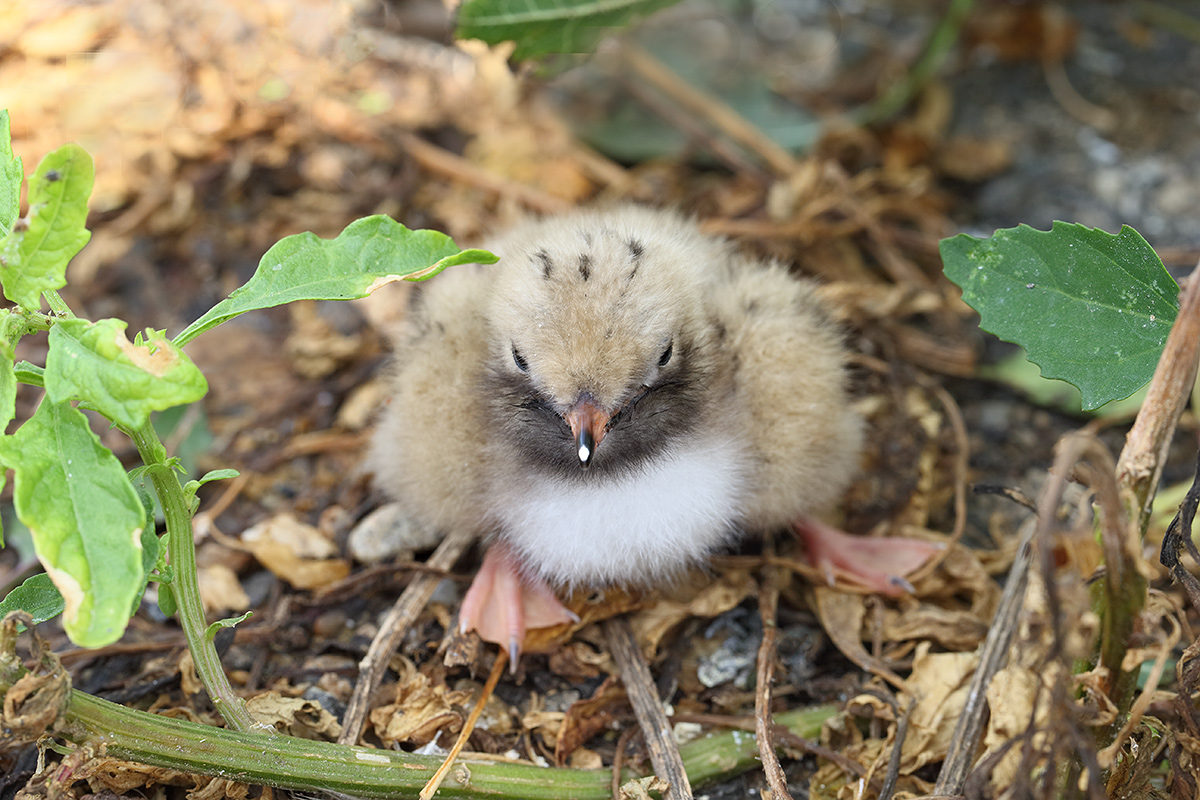
|
|
This image was created at 10:42 am on a partly cloudy morning with the hand held Canon EF 100mm f/2.8L IS macro lens and the and the Canon EOS-1D X. ISO 400. Evaluative metering +2/3 as framed: 1/125 sec. at f/10 in Av mode.
One sensor above and one to the right of the Central Sensor/AI Servo/Rear Focus Single Point AF on the bird’s left eye was active at the moment of exposure. Click here if you missed the Rear Focus Tutorial. Click on the image to see a larger version.
|
Thanks Ian!
Thanks to GGI tern researcher Ian Putnam who found this blonde Common Tern chick and shared it with me this morning. It was one of two blonde chicks in the same nest. This one was 3 days old when I created this image. I shaded the chick with my body and went to f/10 in hopes of sharpening up the egg tooth. It worked!
The Image Optimization
Note the bill and BKGR clean-up. I used the ULC. I also used Tim Grey Dodge and Burn to darken the ULC. Then I put the whole image on a new layer and de-saturated that layer 50 points. Then I added a Hide-All (Black or Inverse) Layer Mask and painted in the desaturation, again in the ULC.
The DPP RAW Conversion Guide
To learn why I use Canon’s Digital Photo Professional (DPP) 3.14 to convert every image that I work on, click here.
Digital Basics
Everything that I did to optimize today’s images are detailed in my Digital Basics File–written in my easy-to-follow, easy-to-understand style. Are you tired of making your images look worse in Photoshop? Digital Basics File is an instructional PDF that is sent via e-mail. It includes my complete digital workflow, dozens of great Photoshop tips, the use of Contrast Masks, several different ways of expanding and filling in canvas, all of my time-saving Keyboard Shortcuts, Quick Masking, Layer Masking, and NIK Color Efex Pro basics, my killer image clean-up techniques, Digital Eye Doctor, creating time-saving actions, and lots more.
APTATS I & II
Learn the details of advanced Quick Masking techniques in APTATS I. Learn Advanced Layer Masking Techniques in APTATS I. Mention this blog post and apply a $5 discount to either with phone orders only. Buy both APTATS I and APTATS II and we will be glad to apply at $15 discount with phone orders only. Please call Jim or Jennifer at 863-221-2372 on Tuesday to order.
|

|
|
Images and card design copyright 2014: Arthur Morris/BIRDS AS ART. Click on the card to enjoy a spectacular larger version.
|
The 2015 UK Puffins and Gannets IPT
June 29 through July 5, 2015: $5499: Limit 10 photographers/Openings 8. Two great leaders: Denise Ippolito and Arthur Morris.
Here are the plans for next year: take a red eye from the east coast of the US on 28 June arriving in Edinburgh, Scotland on the morning of Monday 29 June (or simply meet us then either at the Edinburgh Airport (EDI) or later in the day at our cottages if you are driving your own vehicle either from the UK or from somewhere in Europe. Stay 7 nights in two gorgeous modern country cottages.
There are 5 days of planned puffin/seabird trips—weather permitting, and 1 full day of gannet photography with 2 sessions on the boat.
|

|
|
Images and card design copyright 2014: Arthur Morris/BIRDS AS ART. Click on the card to enjoy a spectacular larger version.
|
The Details
All breakfasts, lunches and dinners are included. All 5 puffins boat lunches will need to be prepared in advance, taken with, and consumed at your leisure. I usually eat mine on the short boat trip from one island to the other. Also included is a restaurant lunch on the gannet boat day and a farewell fine dining thank you dinner. The cost of your National Heritage Trust is also included; that covers the twice a day landing fees.
Plan to fly home on the early morning of Monday 6 July or to continue your stay or travels.
We are planning this as double-occupancy only but we should be able to arrange for singles by renting a 3rd cottage. We would need to know well in advance, i.e., soon, and it would be pricey and would need to be paid with your non-refundable deposit of $2,000. The shared rooms are decent-sized, each with two roomy single beds and a private bathroom. There are two king rooms available for couples. The upscale country-side cottages are beyond lovely with large living areas and lots of open space for image sharing and Photoshop lessons.
The single supplement is $1475. As we will be renting a third cottage the $1475 is due with your deposit and is also non-refundable.
If you are good to go please send your $2,000 deposit check now to save a spot. We do expect this workshop to sell out very quickly as we have already sold 2 slots even though the trip has not yet been formally announced till right now. Not to mention that everyone loves puffins. Please make your check out to “Arthur Morris” and send it to Arthur Morris/BIRDS AS ART, PO Box 7245, Indian Lake Estates, FL, 33855.
We do hope that you can join us.
Facebook
Be sure to like and follow BAA on Facebook by clicking on the logo link upper right. Tanks a stack!
Support the BAA Blog. Support the BAA Bulletins: Shop B&H here!
We want and need to keep providing you with the latest free information, photography and Photoshop lessons, and all manner of related information. Show your appreciation by making your purchases immediately after clicking on any of our B&H or Amazon Affiliate links in this blog post. Remember, B&H ain’t just photography!
…..
Amazon Canada
Many kind folks from north of the border, ay, have e-mailed stating that they would love to help us out by using one of our affiliate links but that living in Canada and doing so presents numerous problems. Now, they can help us out by using our Amazon Canada affiliate link by starting their searches by clicking here. Many thanks to those who have written.
Typos
In all blog posts and Bulletins, feel free to e-mail or to leave a comment regarding any typos, wrong words, misspellings, omissions, or grammatical errors. Just be right. 🙂
July 28th, 2014
|

|
|
Images and card design copyright 2014: Arthur Morris/BIRDS AS ART. Click on the card to enjoy a spectacular larger version. Scroll down to join us in the UK in 2015.
|
The Streak Continues: 240
This post was published just before 6:00am from Gull Island where it is cloudy and drizzling this morning with lightning. I slept late till about 6am this morning and it looks like wind against sun so I am not sure whether I will be doing much photography this morning with lightning and drizzle. And a big thunder clap just shook the 118 year old headquarters building to its foundation. Fort Michie was built in 1896 as part of the Harbor Defense of Long Island Sound.
I enjoyed a great day of photography on GGI yesterday with the afternoon really shining in the late afternoon light. Though it had been overcast for much of the day I took a 2nd swim (as there is no running water on the island….) For my first swim it was clear and sunny and the visibility was great. Yesterday the water had gotten much colder, probably about 75 degrees, and there was no visibility. Everything was going great until I swam face first into a jellyfish and was stung on the face and the shoulders. I got out of the water as quickly as possible but the stinging was mild and dissipated within about 40 minutes.
This post, which took me 3 hours to prepare, marks 240 consecutive days with a new enjoyable and educational blog post. With so many folks getting in the habit of using our B&H links and our Amazon logo-links, why quit now? April, May, June, and July have been fantastic as lots of folks are getting the message; using my affiliate links does not cost you a penny and helps support my efforts here. To show your appreciation, I do ask that you use our B&H and Amazon affiliate links on the right side of the blog for all of your purchases. Please check the availability of all photographic accessories in the BIRDS AS ART Online Store, especially Gitzo tripods, Wimberley tripod heads, and the like. We sell only what I have used and tested, and know that you can depend on. We will not sell you junk. We know the tools that you need to make creating great images easy and fun. And we are always glad to answer your gear questions via e-mail.
You can find the following items in the store: Gitzo tripods, Mongoose M3.6 and Wimberley heads, plates, low feet, and accessories, flash brackets, , Delkin e-film Pro Compact Flash Cards, LensCoat products, and our unique line-up of educational materials including ABP I & II, Digital Basics, Site and Set-up e-Guides, Canon and Nikon Camera Users and AF e-Guides, and MP-4 Photoshop video tutorials among others.
I would of course appreciate your using our B&H affiliate links for all of your major gear, video, and electronic purchases. For the photographic stuff mentioned in the paragraph above we, meaning BAA, would of course greatly appreciate your business. Here is a huge thank you to the many who have been using our links on a regular basis and visiting the BAA Online store as well.
|
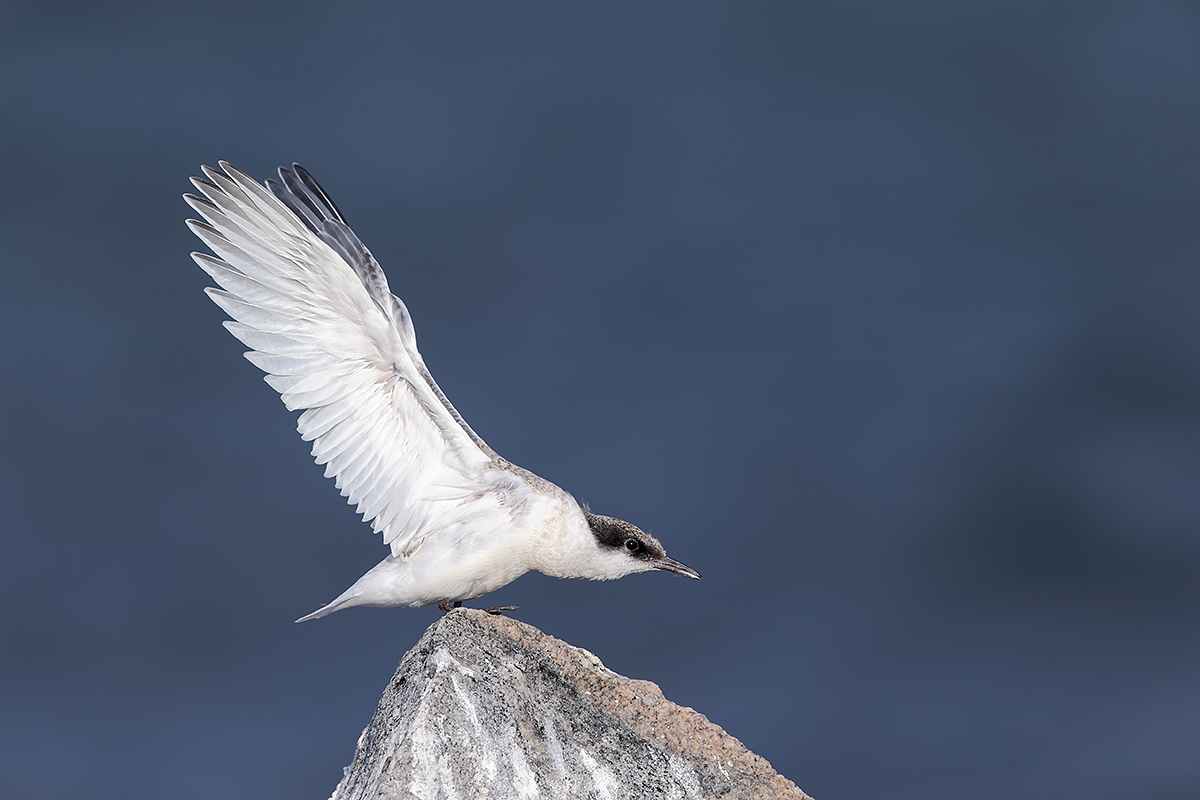
|
|
This image was created at 4:18pm just as the sun peeked out from behind the clouds with the Gitzo 3532 LS carbon fiber tripod, the Canon EF 600mm f/4L IS II USM lens, and the Canon EOS-1D X. ISO 400. Evaluative metering +1/3 as framed before the wingstretch and before the fun came out: 1/2500 sec. at f/5 in Manual mode.
61-Point/AI Servo/Rear Focus AF activated an array of 5 sensors on the base of and the leading edge of the wing and were of course active at the moment of exposure. Click here if you missed the Rear Focus Tutorial. Click on the image to see a larger version.
|
The Situation
It was a mostly cloudy afternoon. I had set up on the triangular tip of a handsome rock, the perfect spot for a tern to land. And what should land there right off the bat but a lovely juvenile Roseate Tern. I photographed it first with the 600 II and the 2X TC and then, hoping that an adult would fly in with a big sand eel to feed its young, I removed the TC and went wide with the 600 alone. As I say here often, the tighter that you work the less chance that you have to create great images of action or behavior. Well, neither of the parents ever came in but I was rewarded by the lovely double overhead wingstretch that you see above.
The problem was twofold: 1-just as the bird began to stretch the sun came out at full force. 2-like most sandpipers, the underwings were a bright white, much brighter than I expected. I was worried that I had toasted the WHIEs beyond saving. And there were plenty of blinkies….
|
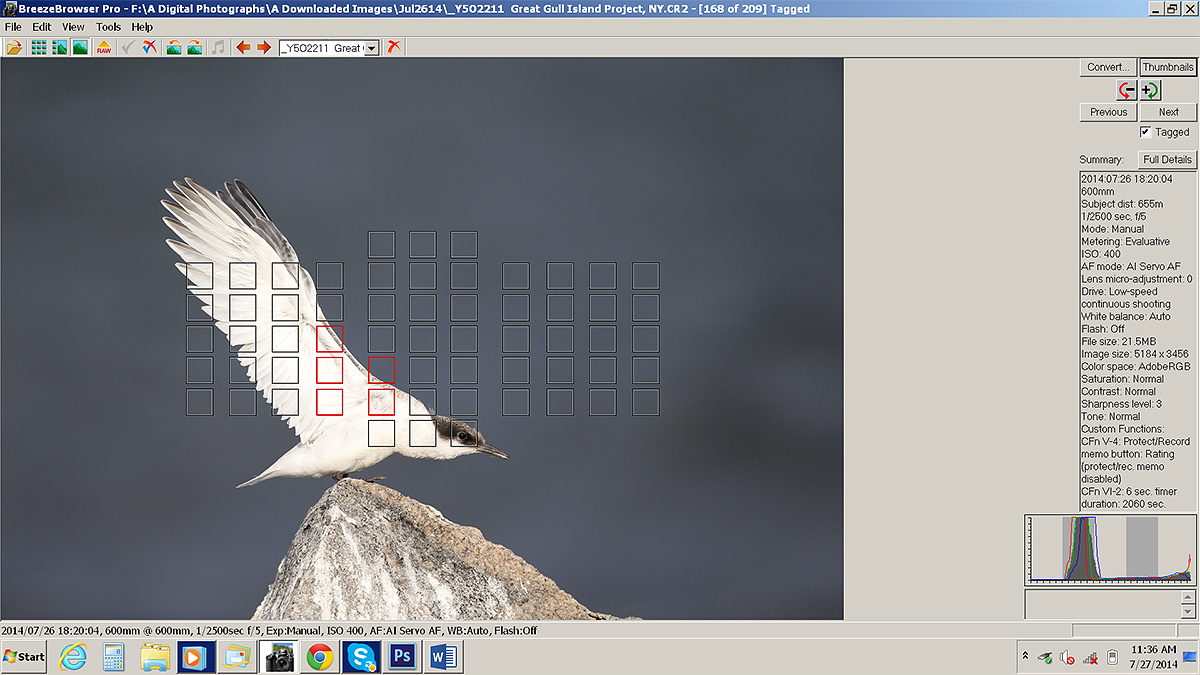
|
|
The BreezeBrowser Main View Screen Capture
|
BreezeBrowser Main View Screen Capture
Above is the BreezeBrowser Main View screen capture for today’s image. Note that the illuminated red squares shows the AF points that had been selected by 61-Point AF. They indicate which AF points were active at the moment of exposure. I have been using 61-point more and more in recent weeks, even for flight photography. Note also the clipping of the red channel on the right edge of the histogram….
Note: in Breezebrowser you need to check “Show Focus Points” under View to activate this feature. To see the focus points in DPP check “AF Point” under View or hit Alt L. Hit Alt M to see Highlight Alert. To learn how and why I use DPP (Canon Digital Photo Professional) to convert my RAW files, see the info on our DPP RAW Conversion Guide here.
Regular readers know that I use and depend on BreezeBrowser every day of the year. It allows me to sort my keepers and delete the rejects faster than any other Windows browsing program. We use it on the main computer in the home office to catalog our images file-drawer style. And the companion program, Downloader Pro allows me to download my images quickly and conveniently. It automatically adds my IPTC data and the shooting location. I have it set up to create a folder named by the Month/date/year. The Breezebrowser/Downloader Pro combo saves me many hours each week. To learn more or to purchase this great PC only program, click here. As far as the BreezeBrowser/Downloader Pro Combo goes, if you are using a Windows platform and are not using these two great programs you are at best, wasting your valuable time. My understanding is that Photo Mechanic is best for Mac-users who do not opt to run Parallels or VM Ware fusion on their Macs so that they can enjoy the many advantages of BreezeBrowser. See BreezeBrowswer on a Mac for details.
|
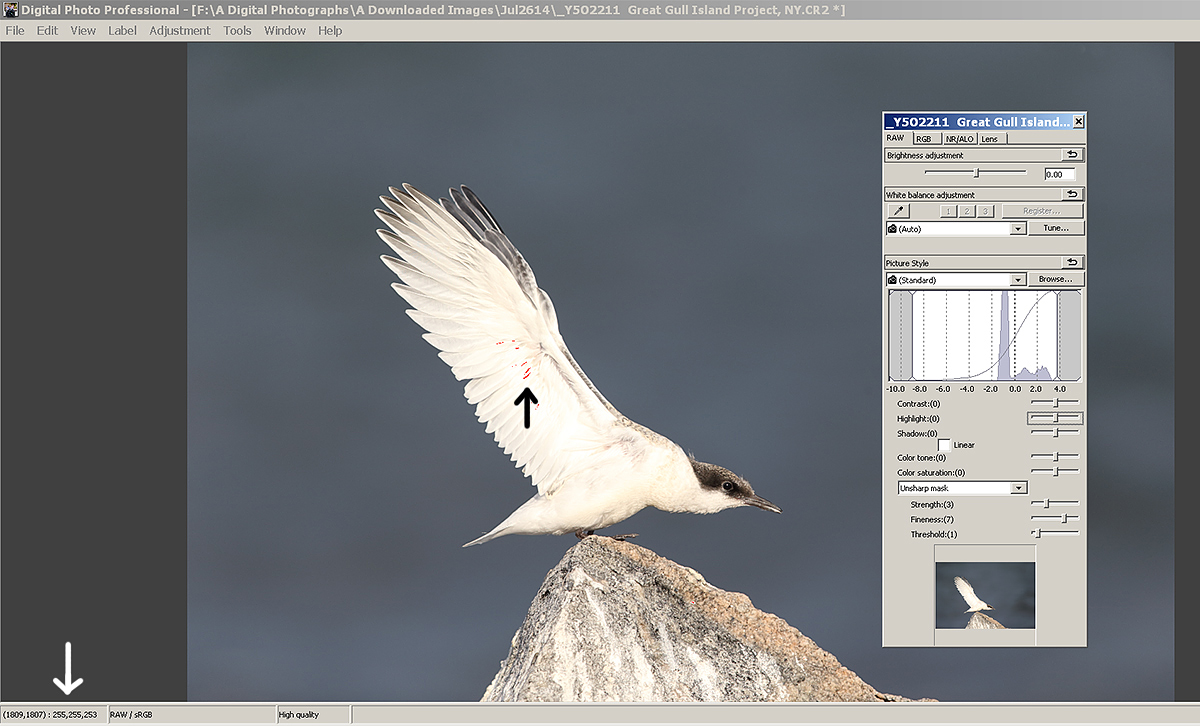
|
|
Opening the image in DPP
|
Bringing the Image Into DPP
The highlight alerts in DPP are set to show red. I was glad to see only a very few right where I expected them. Chances were that they could be easily recovered. If you enlarge the image by clicking on it, you can see them just above the upward pointing black arrow. Take a look at the the RBG numbers in the lower left corner of the frame note, just below the downward facing white arrow; they read 255, 255, 253. Those were less encouraging as totally blown WHITEs will read 255, 255, 255. In addition, there was very little detail to be seen in the brightest areas of WHITE. But knowing digital as I do I knew that the chance to recover detail in the WHITEs and save this image were high.
If you can read the fine print you will see that the settings shown in this screen capture are all at the defaults. Of note are the Brightness adjustment at 0.00, the White Balance on Auto, and the Highlight slider at 0.
|
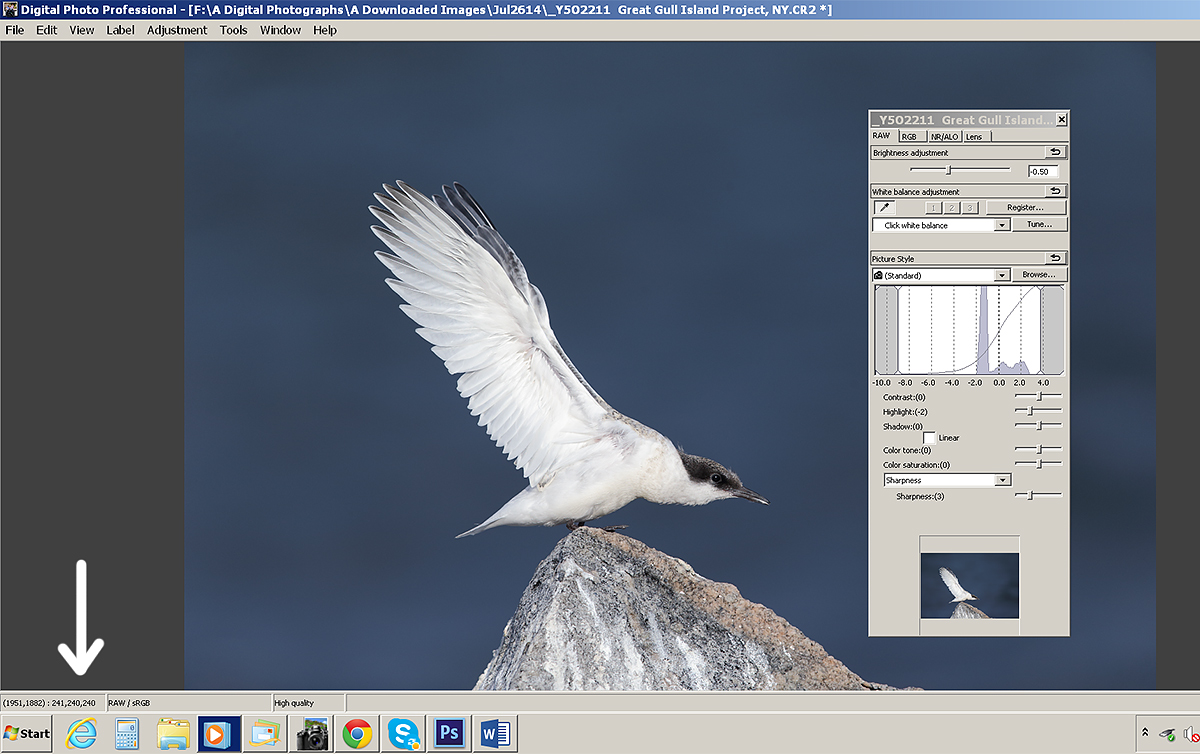
|
|
Saving the WHITEs
|
Saving the WHITEs in DPP 3.14
Saving the WHITEs during the RAW conversion turned out to be easy. I reduced the exposure 1/2 stop by moving the Brightness adjustment slider to -0.50. I moved the Highlight slider to -2. And I used the great Click White Balance feature. Note the new RGB numbers in the lower left hand corner: 241, 240, 240. Though I generally prefer to bring my images into Photoshop with no RGB values greater than 235, I knew that the image had been saved. My 50/50 NIK Color Efex Pro pre-set did a great job of bringing up the detail in the WHITEs while keeping them WHITE.
Whether you convert your RAW files in DPP, in Photoshop or Lightroom with ACR, or in Aperture, you can use the methods detailed above to save the WHITEs in the event of accidental over-exposure. Providing of course that you use RAW capture….
|

|
|
Images and card design copyright 2014: Arthur Morris/BIRDS AS ART. Click on the card to enjoy a spectacular larger version.
|
The 2015 UK Puffins and Gannets IPT
June 29 through July 5, 2015: $5499: Limit 10 photographers/Openings 8. Two great leaders.
Here are the plans for next year: take a red eye from the east coast of the US on 28 June arriving in Edinburgh, Scotland on the morning of Monday 29
June (or simply meet us then either at the Edinburgh Airport (EDI) or later in the day at our cottages if you are driving your own vehicle either from the UK or from somewhere in Europe. Stay 7 nights in two gorgeous modern country cottages.
There are 5 days of planned puffin/seabird trips—weather permitting, and 1 full day of gannet photography with 2 sessions on the boat.
|

|
|
Images and card design copyright 2014: Arthur Morris/BIRDS AS ART. Click on the card to enjoy a spectacular larger version.
|
The Details
All breakfasts, lunches and dinners are included. All 5 puffins boat lunches will need to be prepared in advance, taken with, and consumed at your leisure. I usually eat mine on the short boat trip from one island to the other. Also included is a restaurant lunch on the gannet boat day and a farewell fine dining thank you dinner. The cost of your National Heritage Trust is also included; that covers the twice a day landing fees.
Plan to fly home on the early morning of Monday 6 July or to continue your stay or travels.
We are planning this as double-occupancy only but we should be able to arrange for singles by renting a 3rd cottage. We would need to know well in advance, i.e., soon, and it would be pricey and would need to be paid with your non-refundable deposit of $2,000. The shared rooms are decent-sized, each with two roomy single beds and a private bathroom. There are two king rooms available for couples. The upscale country-side cottages are beyond lovely with large living areas and lots of open space for image sharing and Photoshop lessons.
The single supplement is $1475. As we will be renting a third cottage the $1475 is due with your deposit and is also non-refundable.
If you are good to go please send your $2,000 deposit check now to save a spot. We do expect this workshop to sell out very quickly as we have already sold 2 slots even though the trip has not yet been formally announced till right now. Not to mention that everyone loves puffins. Please make your check out to “Arthur Morris” and send it to Arthur Morris/BIRDS AS ART, PO Box 7245, Indian Lake Estates, FL, 33855.
We do hope that you can join us.
Facebook
Be sure to like and follow BAA on Facebook by clicking on the logo link upper right. Tanks a stack!
Support the BAA Blog. Support the BAA Bulletins: Shop B&H here!
We want and need to keep providing you with the latest free information, photography and Photoshop lessons, and all manner of related information. Show your appreciation by making your purchases immediately after clicking on any of our B&H or Amazon Affiliate links in this blog post. Remember, B&H ain’t just photography!
…..
Amazon Canada
Many kind folks from north of the border, ay, have e-mailed stating that they would love to help us out by using one of our affiliate links but that living in Canada and doing so presents numerous problems. Now, they can help us out by using our Amazon Canada affiliate link by starting their searches by clicking here. Many thanks to those who have written.
Typos
In all blog posts and Bulletins, feel free to e-mail or to leave a comment regarding any typos, wrong words, misspellings, omissions, or grammatical errors. Just be right. 🙂
July 27th, 2014
|

|
|
Images and card design copyright 2014: Arthur Morris/BIRDS AS ART. Click on the card to enjoy a spectacular larger version. Scroll down to join us in the UK in 2015.
|
The Streak Continues: 239
This post was published just before 6am from Gull Island. I slept late till about 6am this morning and it looks like wind against sun so I am not sure whether I will be doing much photography this morning.
This post, which took me 1 1/2 hours to prepare, marks 239 consecutive days with a new enjoyable and educational blog post. With so many folks getting in the habit of using our B&H links and our Amazon logo-links, why quit now? April, May, June, and July have been fantastic as lots of folks are getting the message; using my affiliate links does not cost you a penny and helps support my efforts here. To show your appreciation, I do ask that you use our B&H and Amazon affiliate links on the right side of the blog for all of your purchases. Please check the availability of all photographic accessories in the BIRDS AS ART Online Store, especially Gitzo tripods, Wimberley tripod heads, and the like. We sell only what I have used and tested, and know that you can depend on. We will not sell you junk. We know the tools that you need to make creating great images easy and fun. And we are always glad to answer your gear questions via e-mail.
You can find the following items in the store: Gitzo tripods, Mongoose M3.6 and Wimberley heads, plates, low feet, and accessories, flash brackets, , Delkin e-film Pro Compact Flash Cards, LensCoat products, and our unique line-up of educational materials including ABP I & II, Digital Basics, Site and Set-up e-Guides, Canon and Nikon Camera Users and AF e-Guides, and MP-4 Photoshop video tutorials among others.
I would of course appreciate your using our B&H affiliate links for all of your major gear, video, and electronic purchases. For the photographic stuff mentioned in the paragraph above we, meaning BAA, would of course greatly appreciate your business. Here is a huge thank you to the many who have been using our links on a regular basis and visiting the BAA Online store as well.
|
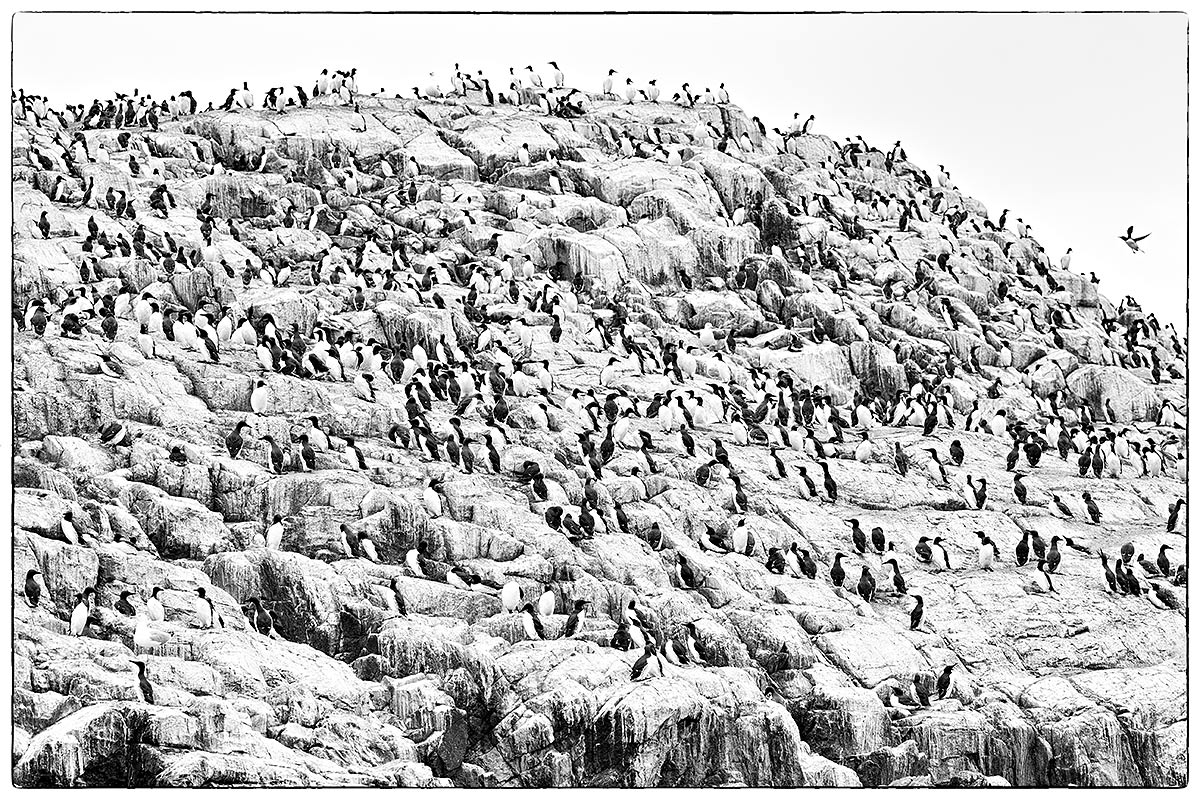
|
|
This image was created on recently concluded UK Puffins and Gannets IPT with the Canon EF 200-400mm f/4L IS USM Lens with Internal 1.4x Extender that I borrowed from Jean-Luc Vaillant for the day (hand held at 200mm) and the Canon EOS-1D X. ISO 800. Evaluative metering +1 2/3 stops of the light grey sky: 1/800 sec. at f/6.3 in Manual mode. AWB.
Two sensors below the Central Sensor/AI Servo-Surround/Rear Focus was active at the moment of exposure. Click here to see the latest version of the Rear Focus Tutorial. Click on the image to see a larger version.
|
Do Your Tastes Run to Black and White?
Though I don’t do much black and white, I thought of converting this image even as I was creating it from the boat. I brought the image into NIK Silver Efex Pro and tried my favorite pre-sets but none of them grabbed me. Then I tried “Pro Fine Art High Key” and bingo, that was it for me. I did not even notice that this pre-set included ragged edges until I viewed the image full screen in BreezeBrowser.
WDYT?
A lot more went into creating the final image then the B&W conversion. See the original below along with the info on the image clean-up and optimization.
|
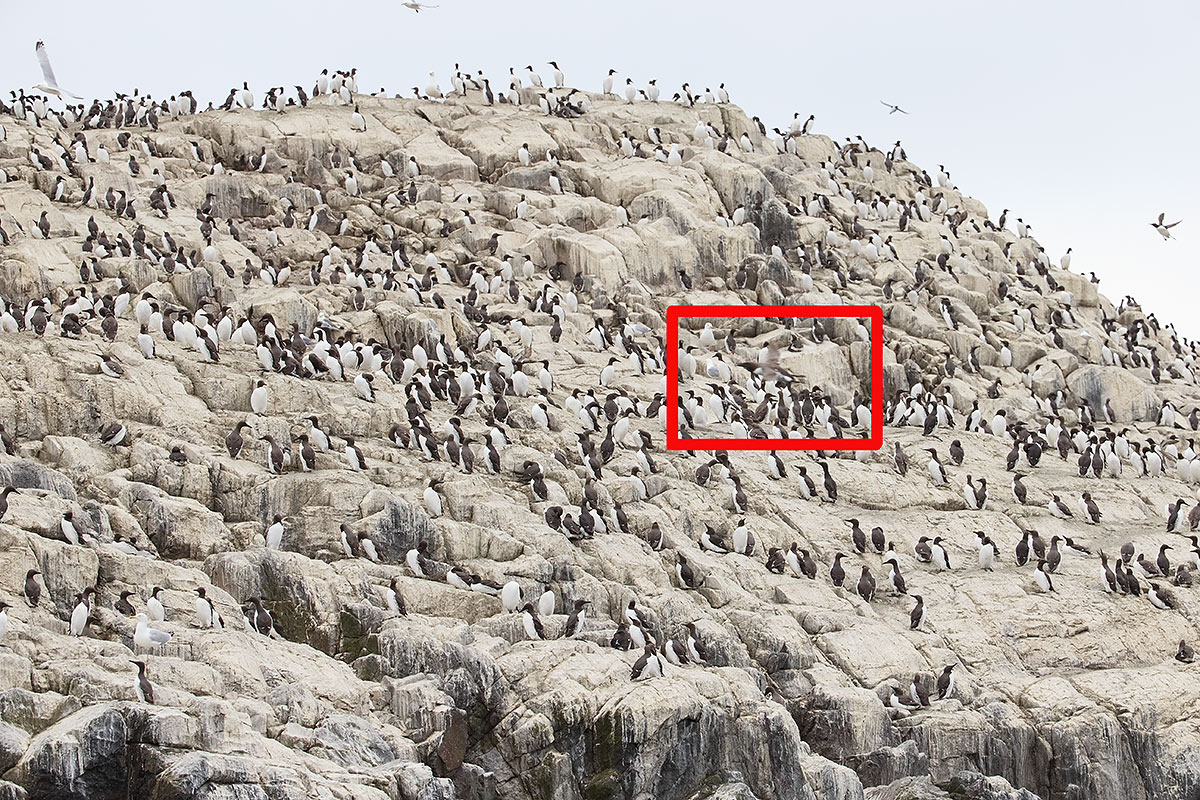
|
|
This is one of the two original images from which the optimized image that opened this blog post was created.
|
The Image Clean-up and Optimization
As is usually the case when I am photographing single birds or somewhat static bird-scapes as with today’s image, I almost always create bursts of 3-4 images when I see something that I like in the viewfinder. That is a great habit to develop. With single birds there is always the risk that the nictitating membrane–a bird’s translucent 2nd eyelid–might be in place to ruin the image. Brief subject movement can ruin many shots as well.
With bird-scapes creating multiple similar images can save the day in a variety of ways. First off, they can provide source material that may be useful during the image clean-up and optimization process. As here. And also as here–with the Common Murre in the URC–multiple frames increase the chance of capturing a bird in flight with a decent wing position that just might add to the scene….
In the original image above note the out-of-focus Common Murre (Guillemot on the other side of the pond) in flight; it is in the red box. I painted a quick mask of the area behind the o-o-f flying bird from the next frame in the series and used that layer to cover the offending and distracting bird. Eliminating the gull in the upper left corner along with a few other stray birds in flight and cleaning the left frame-edge was done as usual with a series of small warped Quick Masks, the Clone Stamp Tool, and the Spot Healing Brush. I moved the murre in flight with two Quick Masks, one to move the bird to a new position, the other to cover the “original” bird.
The DPP RAW Conversion Guide
To learn why I use Canon’s Digital Photo Professional (DPP) 3.14 to convert every image that I work on, click here.
Digital Basics
Everything that I did to optimize today’s images are detailed in my Digital Basics File–written in my easy-to-follow, easy-to-understand style. Are you tired of making your images look worse in Photoshop? Digital Basics File is an instructional PDF that is sent via e-mail. It includes my complete digital workflow, dozens of great Photoshop tips, the use of Contrast Masks, several different ways of expanding and filling in canvas, all of my time-saving Keyboard Shortcuts, Quick Masking, Layer Masking, and NIK Color Efex Pro basics, my killer image clean-up techniques, Digital Eye Doctor, creating time-saving actions, and lots more.
APTATS I & II
Learn the details of advanced Quick Masking techniques in APTATS I. Learn Advanced Layer Masking Techniques in APTATS I. Mention this blog post and apply a $5 discount to either with phone orders only. Buy both APTATS I and APTATS II and we will be glad to apply at $15 discount with phone orders only. Please call Jim or Jennifer at 863-221-2372 on Tuesday to order.
|

|
|
Images and card design copyright 2014: Arthur Morris/BIRDS AS ART. Click on the card to enjoy a spectacular larger version.
|
The 2015 UK Puffins and Gannets IPT
June 29 through July 5, 2015: $5499: Limit 10 photographers/Openings 8. Two great leaders.
Here are the plans for next year: take a red eye from the east coast of the US on 28 June arriving in Edinburgh, Scotland on the morning of Monday 29
June (or simply meet us then either at the Edinburgh Airport (EDI) or later in the day at our cottages if you are driving your own vehicle either from the UK or from somewhere in Europe. Stay 7 nights in two gorgeous modern country cottages.
There are 5 days of planned puffin/seabird trips—weather permitting, and 1 full day of gannet photography with 2 sessions on the boat.
|

|
|
Images and card design copyright 2014: Arthur Morris/BIRDS AS ART. Click on the card to enjoy a spectacular larger version.
|
The Details
All breakfasts, lunches and dinners are included. All 5 puffins boat lunches will need to be prepared in advance, taken with, and consumed at your leisure. I usually eat mine on the short boat trip from one island to the other. Also included is a restaurant lunch on the gannet boat day and a farewell fine dining thank you dinner. The cost of your National Heritage Trust is also included; that covers the twice a day landing fees.
Plan to fly home on the early morning of Monday 6 July or to continue your stay or travels.
We are planning this as double-occupancy only but we should be able to arrange for singles by renting a 3rd cottage. We would need to know well in advance, i.e., soon, and it would be pricey and would need to be paid with your non-refundable deposit of $2,000. The shared rooms are decent-sized, each with two roomy single beds and a private bathroom. There are two king rooms available for couples. The upscale country-side cottages are beyond lovely with large living areas and lots of open space for image sharing and Photoshop lessons.
The single supplement is $1475. As we will be renting a third cottage the $1475 is due with your deposit and is also non-refundable.
If you are good to go please send your $2,000 deposit check now to save a spot. We do expect this workshop to sell out very quickly as we have already sold 2 slots even though the trip has not yet been formally announced till right now. Not to mention that everyone loves puffins. Please make your check out to “Arthur Morris” and send it to Arthur Morris/BIRDS AS ART, PO Box 7245, Indian Lake Estates, FL, 33855.
We do hope that you can join us.
Facebook
Be sure to like and follow BAA on Facebook by clicking on the logo link upper right. Tanks a stack!
Support the BAA Blog. Support the BAA Bulletins: Shop B&H here!
We want and need to keep providing you with the latest free information, photography and Photoshop lessons, and all manner of related information. Show your appreciation by making your purchases immediately after clicking on any of our B&H or Amazon Affiliate links in this blog post. Remember, B&H ain’t just photography!
…..
Amazon Canada
Many kind folks from north of the border, ay, have e-mailed stating that they would love to help us out by using one of our affiliate links but that living in Canada and doing so presents numerous problems. Now, they can help us out by using our Amazon Canada affiliate link by starting their searches by clicking here. Many thanks to those who have written.
Typos
In all blog posts and Bulletins, feel free to e-mail or to leave a comment regarding any typos, wrong words, misspellings, omissions, or grammatical errors. Just be right. 🙂
July 26th, 2014 The Streak Continues: 238
This post was published at about 5:30am from Great Gull Island. I photographed early and late yesterday on GGI and did well but not great. I did get to photograph some recently fledged Roseate Terns but most were banded. Again, I am online with my cell phone in the middle of nowhere–no electricity and no running water. I depend on one of two generators to keep the cell phone and the laptop charged enough to keep the streak going….
This post, which took me 1 1/2 hours to prepare, marks 238 consecutive days with a new enjoyable and educational blog post. With so many folks getting in the habit of using our B&H links and our Amazon logo-links, why quit now? April, May, June, and July have been fantastic as lots of folks are getting the message; using my affiliate links does not cost you a penny and helps support my efforts here. To show your appreciation, I do ask that you use our B&H and Amazon affiliate links on the right side of the blog for all of your purchases. Please check the availability of all photographic accessories in the BIRDS AS ART Online Store, especially Gitzo tripods, Wimberley tripod heads, and the like. We sell only what I have used and tested, and know that you can depend on. We will not sell you junk. We know the tools that you need to make creating great images easy and fun. And we are always glad to answer your gear questions via e-mail.
You can find the following items in the store: Gitzo tripods, Mongoose M3.6 and Wimberley heads, plates, low feet, and accessories, flash brackets, , Delkin e-film Pro Compact Flash Cards, LensCoat products, and our unique line-up of educational materials including ABP I & II, Digital Basics, Site and Set-up e-Guides, Canon and Nikon Camera Users and AF e-Guides, and MP-4 Photoshop video tutorials among others.
I would of course appreciate your using our B&H affiliate links for all of your major gear, video, and electronic purchases. For the photographic stuff mentioned in the paragraph above we, meaning BAA, would of course greatly appreciate your business. Here is a huge thank you to the many who have been using our links on a regular basis and visiting the BAA Online store as well.
|
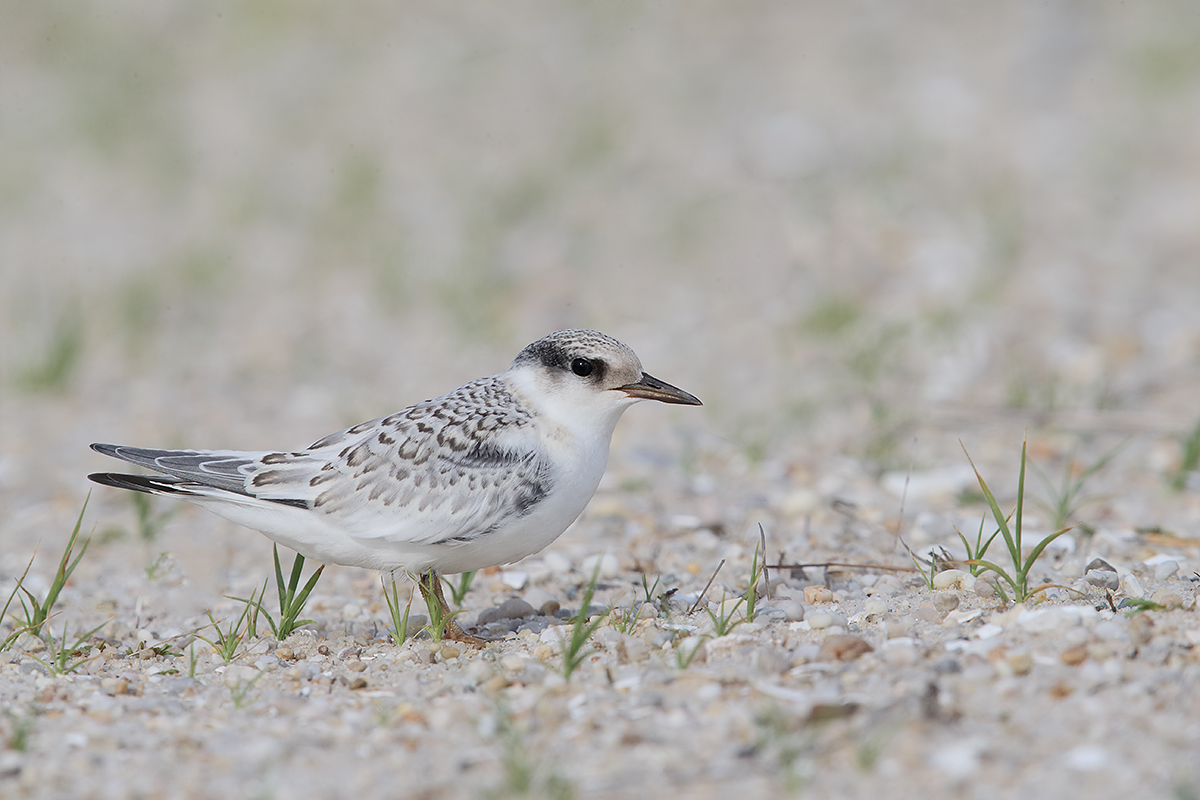
|
|
This image was created with the
the Gitzo 3532 LS carbon fiber tripod, the Mongoose M3.6 head, the Canon EF 600mm f/4L IS II USM lens, the Canon Extender EF 2X III, and the Canon EOS-1D X. ISO 400. Evaluative metering +2/3 stop as framed: 1/640 sec. at f/11 in Av mode. AWB.
Central Sensor (by necessity)/AI Servo-Expand/Rear Focus AF just ebelow and between the base of the bill of the bill and the eye was active at the moment of exposure. When you add the 2X TC to an f/4 lens with the 1DX or the 5D III hit the MFn button once to toggle to AF Expand and enjoy 4 extra AF sensors. Learn everything there is to know about the 1D X and 5D III AF systems including how to manage the various AF Area Selection Modes, when to use which one, and several ways to move the AF sensor around in the 1D X AF Guide and the 5D Mark III User’s Guide. Click here to see the latest version of the Rear Focus Tutorial. Click on the image to see a larger version. .
|
Recently Fledged Juvenile Least Tern
In addition to being much smaller than their Sterna genus cousins, Common and Roseates, juvie Least Terns do not feature any brown, tans, or buff tones in their plumages. Their exquisitely patterned upperparts are various shades of black, grey, and silver. The bills of young leasts are blackish with a hint yellowish tones. The face has a dark eye stripe that will become more prominent as they age. They rarely associate with other tern species.
|
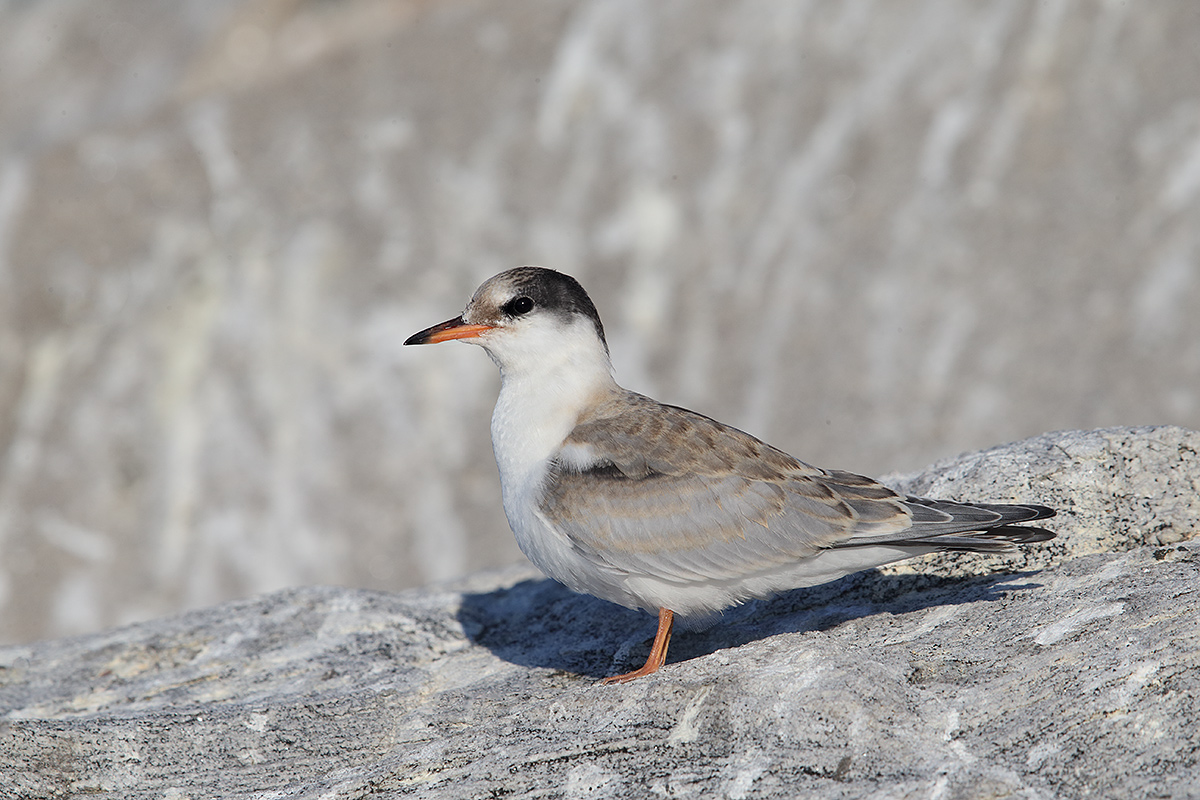
|
|
This image was created today, July 26 at Great Gull Island Project NY in bright sun at 7:16am with the Gitzo 3532 LS carbon fiber tripod, the Mongoose M3.6 head, the Canon EF 600mm f/4L IS II USM lens, the Canon Extender EF 2X III, and the Canon EOS-1D X. ISO 400. Evaluative metering +1/3 stop as framed: 1/1000 sec. at f/11 in Manual Av mode. AWB.
Central Sensor (by necessity)/AI Servo-Expand/Rear Focus AF on the spot where the hind neck meets the upper back was active at the moment of exposure. When you add the 2X TC to an f/4 lens with the 1DX or the 5D III hit the MFn button once to toggle to AF Expand and enjoy 4 extra AF sensors. Learn everything there is to know about the 1D X and 5D III AF systems including how to manage the various AF Area Selection Modes, when to use which one, and several ways to move the AF sensor around in the 1D X AF Guide and the 5D Mark III User’s Guide. Click here to see the latest version of the Rear Focus Tutorial. Click on the image to see a larger version. .
|
Recently Fledged Juvenile Common Tern
Recently fledged Common Terns feature more buff, tan, rust, and brown tones in their plumage than either of the other two species. Their soft parts–the bill, legs, and feet–colors range from light orange to pinkish orange. The bill has a dusky tip and upper ridge. The dark rear cap will become more prominent as they age. I enjoy photographing them on the rocks that protect GGI from erosion.
Folks need to consult their field guides when it comes to separating juvie commons from juvie Forster’s Terns–the latter feature a dark eye patch in all plumages.
|
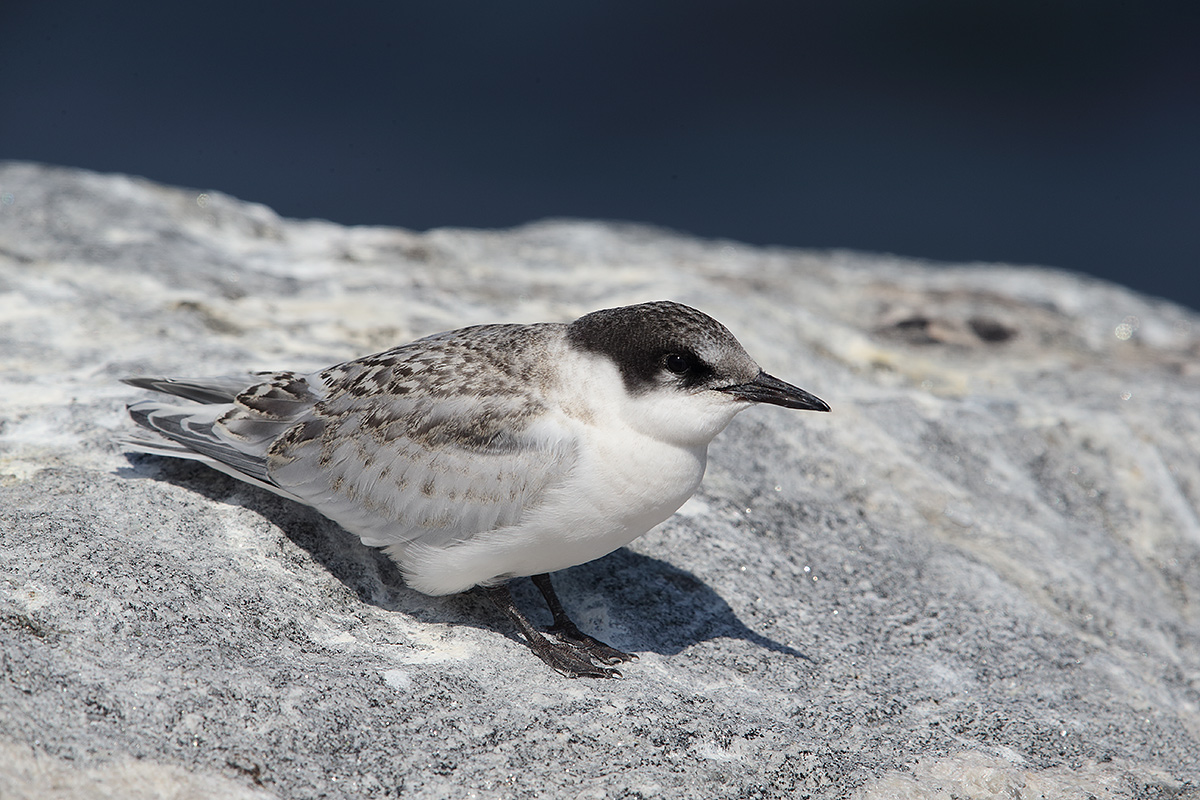
|
|
This image was created today, July 26 at Great Gull Island Project NY in bright sun at 9:54am with the Gitzo 3532 LS carbon fiber tripod, the Mongoose M3.6 head, the Canon EF 600mm f/4L IS II USM lens, the Canon Extender EF 2X III, and the Canon EOS-1D X. ISO 400. Evaluative metering -1/3 stop as framed: 1/1000 sec. at f/11 in Manual Av mode. AWB.
Central Sensor (by necessity)/AI Servo-Expand/Rear Focus AF on the hind neck was active at the moment of exposure. When you add the 2X TC to an f/4 lens with the 1DX or the 5D III hit the MFn button once to toggle to AF Expand and enjoy 4 extra AF sensors. Learn everything there is to know about the 1D X and 5D III AF systems including how to manage the various AF Area Selection Modes, when to use which one, and several ways to move the AF sensor around in the 1D X AF Guide and the 5D Mark III User’s Guide. Click here to see the latest version of the Rear Focus Tutorial. Click on the image to see a larger version. .
|
Recently Fledged Juvenile Roseate Tern
This species is much rarer than least or common. They breed locally in the northern hemisphere only on GGI and at one major location off the coast of Massachusetts. They are seen infrequently on their long migrations. They have fewer of the earth tone colors in their plumage than the commons and are most easily separated from the commons by their all black feet and bills. Like the young commons, it sports a dark rear cap. I am greatly enjoying the opportunity to photograph the young of this species for the first time thanks to the kindness of long time GGI director Helen Hays.
Facebook
Be sure to like and follow BAA on Facebook by clicking on the logo link upper right. Tanks a stack!
Support the BAA Blog. Support the BAA Bulletins: Shop B&H here!
We want and need to keep providing you with the latest free information, photography and Photoshop lessons, and all manner of related information. Show your appreciation by making your purchases immediately after clicking on any of our B&H or Amazon Affiliate links in this blog post. Remember, B&H ain’t just photography!
…..
Amazon Canada
Many kind folks from north of the border, ay, have e-mailed stating that they would love to help us out by using one of our affiliate links but that living in Canada and doing so presents numerous problems. Now, they can help us out by using our Amazon Canada affiliate link by starting their searches by clicking here. Many thanks to those who have written.
Typos
In all blog posts and Bulletins, feel free to e-mail or to leave a comment regarding any typos, wrong words, misspellings, omissions, or grammatical errors. Just be right. 🙂
|
|


